Australian
and international
exploratory
performance and
media arts
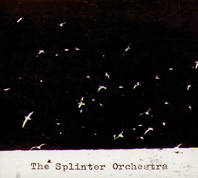
Split Records splitrecCD 17
http://www.splitrec.com/
Sydney-based ensemble The Splinter Orchestra has made a name for itself in recent years for live improvisations, particularly at events such Liquid Architecture and through the landmark ABC TV series Set (2006). This is the debut, self-titled CD and is significant both in bringing recordings of the ensemble’s work to the public and in reframing its oeuvre through the process of recording.
The CD contains five tracks in all. The first, simply entitled First Play, opens quietly with a long, barely audible drone at very low frequency, the other instruments progressively entering. The performers play quietly and the sound gradually builds as each instrument’s distinct voice emerges. This is complex music demanding careful attention. The second and fifth tracks are entitled First Tutti and Second Tutti respectively, indicating that the whole ensemble is joining in, whereas other tracks are free improvisation, where individual performers might or might not contribute, depending on what develops.
First Tutti opens frenetically. Each performer seems to work through tightly prescribed idioms resulting in an impenetrably dense layering, but within a more restricted dynamic range than that of the first track. Less lyrical and more monotonal, the combinations of sounds produce interesting hybrid textures. There is a long trombone drone in the background, which morphs into a hypnotically rhythmic whirring sound as the piece quietens towards its conclusion. Though developed from a composite of disparate noises, the piece gains a level of coherence that suggests an intimately shared sensibility.
Track 3, Second Play, opens quietly with teasing arpeggios at the top end of what sounds like a prepared piano. Other sounds are progressively layered over it and a restrained, minimalist lyricism emerges. Again the piece quietens towards the end, some electronics closing it out. Third Play commences almost imperceptibly and gradually gains momentum. Overall, the music is dense but elegant and restrained, slowly seducing rather than forcing itself on you.
The interest in such music lies in the extraordinary lyrical complexity that emerges from the combinations of instruments, even if they are playing simple, repeated motifs. It also lies in the almost infinite variety of timbres and textures that are generated from the instruments as they combine. Musical development occurs through the blending of instrumental voices and the players’ responses to the overall effect, rather than through programmed structures or melodic line. In the pieces for free improvisation the performers respond to each other to build the most engaging compositions. Each time you listen to this CD, you hear new things and follow new trails. It’s like getting to know a forest intimately though, in a sense, this is a petrified forest, and those unexpected moments and unpredictable interactions that characterise improvisation are frozen into this disc.
The CD notes indicate the kinds of instructions given to the performers for their performances. For example, for the tuttis, the ensemble might be divided into three sub-sections and there might be signals to each sub-section to start or stop playing, within which each member is to make only one sound and to play at will. The final recording was edited and mixed from many hours of studio performance and the five pieces coalesce into a work that is symphonic in scale if not in form. Though editing and mixing challenge the concept of live improvisation, the result retains its freshness and dynamism.
There are 27 performers listed in the CD’s credits, playing a variety of wind and brass instruments, several basses, accordion, percussion, guzheng, organ, synthesiser and laptop, often at the limits of technique. Though there have been frequent changes of membership, most members have worked together extensively, and they achieve a unique and profound musicianship. Evidently, the final recording was the product of long rehearsals and careful planning, so that the improvisation is mediated by the members’ experience in ensemble as well as by the instructions to the performers. That such large-scale improvisation can work at all is remarkable, and it works marvellously. The CD’s total running time of 44 minutes seems underweight, but more might have resulted in less, given how carefully measured each element seems to be and how well it comes together as an opus. This is an enchanting disc, and a most important development both for The Splinter Orchestra and for music generally.
Chris Reid
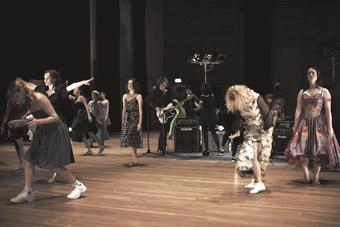
The Fondue Set, Evening Magic 2
photo Irèn Skaarnes
The Fondue Set, Evening Magic 2
THE HUGE PERFORMANCE AREA IS EVENLY DOTTED WITH DANCERS DANCING. THEY ARE PERFORMING BLANCHED VERSIONS OF ‘TYPICAL’ EXERCISE ROUTINES FROM A ‘TYPICAL’ DANCE CLASS. AT FIRST THE OVERLY DECOROUS AND BALLETIC MOVEMENTS SEEM AT ODDS WITH THE VIOLENCE OF THRASHING INDY ROCK. BUT IN CONTEMPORARY PERFORMANCE, DISJUNCTURE SEAMLESSLY MUTATES INTO SARDONIC COUNTERPOINT. THERE ARE TRAINED AND NOVICE DANCERS. ALL HAVE DETERMINEDLY BLANK FACES. I REGISTER THIS AS THE FIRST OF MANY IN-HOUSE STATEMENTS ON THE STATE OF CONTEMPORARY DANCE.
Like sedated inmates of an asylum the dancers obediently dissolve their formality and sit at tables in front of us—an audience within an audience. The Fondue Set appear, and from this point Evening Magic 2 becomes distinctly episodic. The first spoken/moved/sculptural vignette bursts with self referential text and coded dance references. In a Brechtian gesture we are handed directions to the toilets and emergency exits. The trio that is the Fondue Set form a sculptured image, meant none too subtly to disparage the very flexibility and dancerliness they display.
Despite this drastic plunge in energy levels, from frenzy to fancy, the Fondues maintain the intensity and audience fascination stirred by the opening. They do this through crafted performance skills, pithily witty text and compelling personas. They have been around for a while, extending the tendrils of modern dance into broader recesses of existence like pubs and clubs. These exuberant women, in signature red boots, employ text, mime, slapstick, theatrical production systems and music in equal weight with movement. Or maybe the weight is not so equal.
Clearly, coldly, palpably there came a point in this performance when I just wanted to see these women take their tongues from their cheeks and dance. Not sardonically but indulgently. Not ironically but gorgeously. Not generically but idiosyncratically. For these are gorgeous dancers. But here is raised the ugly head of expectation. I came here tonight knowing these women are trained in dance. I came wanting dance. The program tells me that this work aims at “broad communicative appeal…work that pushes the boundaries of what is considered dance, deals with original movement vocabulary and constantly questions existing theatrical dance forms”. These are big ambitions and I’m not so sure if they were realised on the night.
Involuted and coded messages about dancerliness only make sense to dance aficionados, actually tightening “communicative appeal.” While one audience member called it “anti-dance” I thought it not quite punk enough for this moniker. And traditional dancerliness was evident throughout. It’s in their athletic bodies and flexible extensions, their turned-out hips, in their lengthened muscles and in the very fibre of their being. It also lies in their deep familiarity with the canons of ballet and modern dance. Maybe in trying to be unique, in self consciously attempting to ‘push the boundaries’ they unwittingly place themselves on the same ground as those they would seek distance from. They appear tied to the very forms they revile.
But it was fun. I had a rollicking good time watching a show that ended before I was full. I loved the complexity of the sensorial experience as the guitar ripped into my ears, almost hurting, making me feel old. Production techniques and spatial largesse continually provided multiple and mutating points of interest. Costumes were whimsical, thoughtful and thematic while all the time flattering these fine female forms. I found Emma Saunders’ humorous posturing particularly infectious.
And I know the rest of the audience had a good time too. People ambled out smiling, aping bits of choreography and generally humming with aliveness, leaving the theatre as if it were a pub, as if we had been to a gig. And maybe this is the evidence of broadened “communicative appeal” as the Fondue Set lighten dance and set it free from the confines of serious art and the chin scratching search for meaning.
And Evening Magic 2 is unique. It was distinctive in the use of such a large group of dancers, calling up spectres of early modernist choreographers like Doris Humphries and Rudolph Laban who prized the communality of movement choirs. And yet dancers stood out, individuated against a sameness which ultimately highlighted idiosyncrasy. All were the same, all were different. Some grabbed my attention for lingering moments, but rarely did I lose sight of the organic wholeness of a group who were truly working together. This crowd of dancers congealed a potentially unwieldy space into a moving entity, and did so through an admirable admixture of focus and joyous indulgence. Groupness was never more evident than in the tap dance that wasn’t. A highlight of the night, gimpy hoofers faked a tap routine simply by making it sound right. It was hilarious. Other group vignettes, such as the milk crate choir, lacked vim and conviction and left me asking ‘why.’
Subtending and supporting often frenetic energy was technical proficiency. Evening Magic was thickly and slicky produced; exits and entrances of the large group went off without a hitch or a stumble. Large letters on wheels moved around seamlessly to create pertinent words just in case we didn’t get the message. The musicians appeared and disappeared silently and there was a general confidence with the material that let me know this was the result of dedicated hours of talking, dancing, thinking, planning and dreaming. The Fondue Set work through process. They create substance where there could be a frappe. And the ending was great and sad as we all knew it was over a bit too soon when the final word on wheels was rolled out: ENOUGH.
Fondue Set, Evening Magic 2: Don’t Stop ‘til You Get Enough, Fondue Set, Emma Saunders, Jane Mckernan, Elizabeth Ryan, with The Exiles, Hot Box, members of Decoder Ring, La Huva and Youth Group, design Agatha Gothe-Snape; Performance Space, CarriageWorks, Sydney, Oct 19-20
RealTime issue #82 Dec-Jan 2007 pg. 31
© Pauline Manley; for permission to reproduce apply to realtime@realtimearts.net
DANCER AISLING DONOVAN RECENTLY DISTINGUISHED HERSELF AS THE LEAD IN AIMEE SMITH’S COURAGEOUSLY HEROIC GALLANTRY, A DEMANDING PIECE WHICH EMPLOYED HARD ARTICULATIONS AND FOLDS OF LIMBS SPRINGING BACK AND FORTH BETWEEN AWKWARD AND ABSURD POSITIONS (RT 78, P33). A NEW WORK FROM DONOVAN FEATURED IN STRUT’S LATEST PROGRAM, DANCE #2, CONTRASTING REVEALINGLY WITH NEW WORKS FROM FLOEUR ALDER AND DEBORAH ROBERSTON.
aisling donovan
Donovan’s choreography, like Smith’s, also employed fierce limb extensions, carving up a corner with her arms and legs. Nevertheless, her Room With A View suggested a goth, if not melodramatic, ambience, unlike the bleak humour and cool detachment of Gallantry. The willowy dancer’s swathes of long, flying hair supported the work’s emotional tenor, Donovan presenting a figure on the verge of emotional self-destruction. Never quite fully dramatic, after a relatively static and introspective opening the dancer’s frenetic pacing and jagged twists were suggestive of the dark night of the soul. The ‘never-quite-there’ of the emotion was part of the work’s appeal, as well as its weakness. Theatrically, Donovan provided little to guide the audience through the emotional journey presented, beyond the heavy-handed music by Tool. This created a strange vacuum at the heart of the work around which Donovan’s muscular, bony poses moved. Overall, Donovan has established that she could dance a telephone book superbly, but the connection between form and affect here was uncertain—she needs to explore this further or throw herself deeper into expressive angst.
floeur alder
The use of a youthful muscular body to suggest emotional states from amidst a whirl of activity appears to ally Donovan with Floeur Alder. Donovan’s choreography and her work with Smith links her to the hard muscularity and performance art allusions of Australian postmodernism (Guerin, Adams, Stewart etc). By contrast, Alder has returned to Modernism’s heritage to produce a wonderful solo which could have come out of the Denishawn School of the 1930s. Using a suitably ‘exoticist’ score in tune with the primitivist allusions of Euro-American Modernism, Alder’s endlessly tensed body, and her expansions in and out of the chest, were executed in concert with clawed hands and spikily bent arms which recalled Wigman’s Hexentantz of 1926. Martha Graham and her predecessors trawled the cultures of those they called “pre-modern” for the primal rhythms of humanity, and Alder was well served by her choice of nuevo flamenco to accompany her own vibrant Expressionism. While Alder avoided the radical arching of the back in favour of a fluid, perching pose, settling into the ground and tearing out of it, every stance and spasm was nevertheless informed by the breath and energy clasped beneath her sternum. Despite the long history of this approach—to say nothing of how many consider it a politically problematic aesthetic—there is no denying Floeur Alder’s command over the material, nor her ability to craft these gestures and affects into a compelling study. Closer to Graham than Wigman, Alder’s dance too (not unlike Donovan’s) teetered on the edge of an emotional explosion. But where Donovan offered a curiously excessive body centred on an absence, Alder’s was a deep pool. Even so, the force beneath these waters was not released. Energy surged in tightly constrained, anguished pathways, imprisoning the body within its own richly affective forces.
deborah robertson et al
Choreographer Deborah Robertson’s task-based, performance art-like work offered something more than Alder’s intensity and Donovan’s emotional displacements. Robertson, Aimee Smith and Laura Boynes exhibited striking physical diversity. Robertson is a highly sensate dancer, proceeding from a quietly measured, inward self-awareness akin to Rosalind Crisp’s. Boynes and Smith are not indifferent to such subtle internal shifts, but their movement—both in this piece and in other projects—comes initially from outside the body, from form, shape, or political ideas. This dissonance suited the piece in that the often deliberately pedestrian movement revolved around a failure to fully connect; on rejection and ignoring one’s fellow. Smith was a lone rejected figure on a chair at the front while Boyne’s rapid move from her chair or away from Smith gave her movement a nasty edge. Robertson by contrast seemed a gentle focal point shifting throughout the space, but her mild articulations and reassuring self-awareness nevertheless failed to resolve this drama of dislocated individuals. Sounds of cars and city noises added a further layer to the sense of urban alienation. However, a work about the disarticulation of society risks drifting apart. Nevertheless, Robertson disarmingly sustained a sense of both accusation and forgiveness, of atomisation and socialisation in this simple work, providing a wonderful richness to its otherwise spartan form—an affective strategy far removed from the works by Alder and Donovan.
Strut Dance, Dance #2 2007, artistic director, curator Sue Peacock; Room With A View, choreographer, performer Aisling Donovan; Confessional, choreographer Deborah Robertson, performers Robertson, Aimee Smith, Laura Boynes; Seven choreographer, performer Floeur Alder; plus works by Keira Mason-Hill, Simon Green and Gerard Veltre, Bianca Martin, Lena John, Sally Blatchford and Shannon Riggs, Sarah Neville, and Valli Batchelor; King Street Arts Centre, Perth Oct 18-21
RealTime issue #82 Dec-Jan 2007 pg. 30
© Jonathan Marshall; for permission to reproduce apply to realtime@realtimearts.net
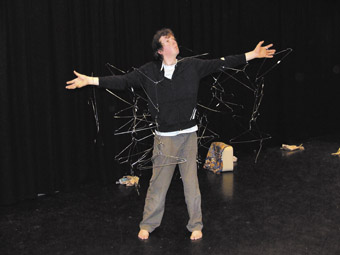
Weave Movement Theatre, Capsule
CAPSULE ENGAGES THE NOTION OF FLIGHT AT MANY LEVELS—FROM ITS MOST LITERAL INCARNATION OF AEROPLANE TRAVEL, TO THE ANALOGUE OF THE JOURNEY, THROUGH TO THE MYTHICAL FIGURE OF ICARUS.
Each of these incarnations signifies a certain vulnerability related to Icarus’ meltdown. The variety of dancers who make up the mixed ability Weave Movement Theatre embody our mortality by opening up our sense of who we might be. If dancing bodies tend to reinforce norms of beauty and facility, Janice Florence’s choreography engages a wider palette of human capacity. The result is a greater variety in the timbre of movement. What is it to watch action which must discover itself in the doing, rather than presuppose control? Nietzsche argues that there is no doer behind the deed, simply the deed itself. Here, the deed casts light on our presumptions about the doer. Is this to fly too close to the sun? Not at all. The use of irony, humour and parody alongside the poetic made Capsule much bigger and more resilient than us all.
Weave Movement Theatre, Capsule, director Janice Florence, choreographic advisor Michelle Heaven, performers Trevor Dunn, Janice Florence, Tom Hope, Sarah Mainwaring, Kate Middleweek, Noelle Rees-Hatton, Anthony Riddell, Ariel Verona; Dancehouse, Melbourne, Sept 13-15
RealTime issue #82 Dec-Jan 2007 pg. 31
© Philipa Rothfield; for permission to reproduce apply to realtime@realtimearts.net
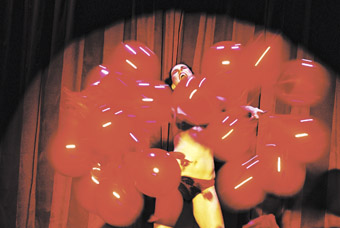
Moira Finucane, Burlesque Macabre, The Queen of Hearts,
photo Heidrun Löhr
Moira Finucane, Burlesque Macabre, The Queen of Hearts,
2007 DRAWS TO A CLOSE ON AN EXTRAORDINARILY BUSY YEAR OF INTERNATIONAL TOURING FOR AUSTRALIAN CONTEMPORARY PERFORMANCE. ASIDE FROM THE MAJOR COMPANIES RESOURCED TO TRAVEL (BANGARRA DANCE THEATRE, SYDNEY DANCE COMPANY ETC) SMALLER ORGANISATIONS AND INDIVIDUALS HAVE BEEN FINDING SUCCESS OVERSEAS. BACK TO BACK THEATRE, BRANCH NEBULA, ADT, URBAN THEATRE PROJECTS, DANCE NORTH, CHUNKY MOVE, LUCY GUERIN INC, CIRCA, ACROBAT, ROSIE DENNIS, CLARE DYSON, MOIRA FINUCANE, MEOW MEOW, MEN OF STEEL, TOM TOM CLUB…THE LIST GOES ON. WHAT IS BEHIND THIS UPSWING IN ACTIVITY? IS IT FASHION, CHANCE OR THE RESULT OF A SLOW ACCUMULATION OF SHEER HARD WORK? WHAT ARE THE MOTIVATIONS AND MACHINATIONS OF AUSTRALIAN ARTISTS ON THE INTERNATIONAL SCENE AND THOSE WHO SUPPORT THEM?
I talked to the few producers promoting Australian performing artists internationally and, as you’ll read in the next edition of RealTime, to the companies themselves. Wendy Blacklock at Performing Lines has been in the business for over 25 years, first taking an Australian Indigenous theatre company overseas in 1982. Marguerite Pepper has a similar history and both refer to Justin McDonnell, now in the US, as another pioneer of their generation. Certain funders have been around long enough to follow the work of these producers and their artists, including Amanda Browne, who has over a decade of experience as manager of the International program of Arts Victoria.
motivation
All these individuals agree on why artists choose to tour. There is the fundamental drive to keep working, to fill the calendar and preserve livelihoods. There is the sense of relevance and connection to a world of diverse cultural contexts. There is the chance to meet other artists and absorb new ideas. There is, sometimes, a financial benefit to be gained. With luck, new presenters with touring connections see your work. Occasionally there are even commissions and collaborations. Always there is the increased cachet and resultant opportunities at home that follow success overseas.
Nobody can be sure whether the increase in touring of 2007 is an all-time high. There is no consolidated data, yet producers and funding bodies confirm that activity has been building over the last decade and looks set to continue. All recognise that success breeds success. A large part of international touring is confidence. Any sense of disenfranchisement, because of Australia’s great distance from other markets, is quickly dispelled by a sell-out season at a major arts festival. The producers elaborated how much of their role is about coaching and encouraging artists, as much as it is about tour booking and negotiations.
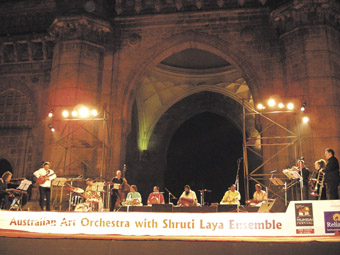
Australian Art Orchestra Sruthi Laya Ensemble, Into the Fire, Gateway of India Mumbai
global engagement, global issues
All agreed that Australian contemporary performance is currently expressing an unprecedented self-confidence, particularly in Indigenous and cross-cultural idioms. Mature performers such as didjeridu player Mark Atkins are leading new generations of artists into rich cultural dialogue. Amongst cross-cultural productions touring in 2007, Marrugeku’s Burning Daylight featured in Zurich’s Theaterspektakel festival and Urban Theatre Project’s Back Home travelled to Toronto’s Harbourfront Centre. And the rest of the world is particularly interested in this distinctive Australian discourse. Marguerite Pepper noted that the Pacific Rim focus of the 2007 Australian International Music Market in Brisbane was extraordinarly well received, by Europeans in particular. She cites the young Brisbane-based didjeridu player, Tjupurru, as a runaway success. Pepper talks of a coming of age of the sector but also of a more enlightened support structure which allows for risks to be taken with less proven artists or projects of scale, unconventional settings and more complex contexts.
Contributing to a global discourse is a sign of Australia’s cultural maturity. Benefiting from a cyclical change of taste and fashion is a less predictable but equally energetic connection. Australian dance, physical theatre and circus is the choice of European presenters jaded by their own artists’ current predilection for conceptual anti-theatre. Just as Meryl Tankard’s ADT, Legs on the Wall, Stalker and Circus Oz were feted in the early 90s, Splinter Group, Circa and Garry Stewart’s ADT now break into markets where virtuosity is thin on the ground. The hybridity of Australian work and its ease in cutting across forms, media and ethnicity has been praised by presenters such as Maria Magdalena Schwaegermann who favoured Australian work in her Theaterspektakel festivals in Zurich.
support mechanisms
While fashions have always come and gone, the difference now is that Australian artists are resourced to take advantage of them and are aware of and involved in the international arts market in ways impossible to imagine a mere decade ago. Web-based communication is making promotion easier as are cheaper travel costs. Blacklock spoke vividly about her trials raising a seemingly impossibly $100K to tour to Expo86 in Vancouver. In those days there were no specific programs to which companies could apply for travel support and this alone created an enormous hurdle. Now, as all agree, the range of sources of support encourages companies to invest in international presentation as a viable aspect of their business.
Producers and funders alike found it difficult to say if funding programs drive activity or vice versa. There was unanimity that Australian artists are professionalising apace and that many have formed coherent strategies for international activities. While some have done this in response to specific new funds designated for business development, such as Victoria’s SCOOP program, or the Australia Council Theatre Board’s International Market Development Strategy for Theatre for Young People, others have siphoned core funding into international activity as the most sustainable aspect of their business. Circa and Strut & Fret Production House (both companies are Brisbane-based) are examples of this entrepreneurial approach. Acrobat, who invested heavily in their career ever since their early borrowed bus and starvation tours, did it the hard way but are finally making a reasonable living not least in the UK and Europe where they are enormously popular.
the big picture
Sandra Bender, the new Director of Market Development at The Australia Council, is a Canadian who comes to the current situation with a perceptive take upon the successes and limitations of previous programs designed to promote Australian contemporary culture internationally. She recognises the intention of programs such as Undergrowth in the UK and the multi-year investment in Berlin as serious attempts by the Council to engage in reciprocity and exchange. She also realises however that such high profile, focused activity can be supplemented by subtler, smaller projects with longer lifespans. The Australia Council’s investment in arts markets is likely to diminish, and whilst the producers cited APAM, CINARS and APAP as the source of many of their most productive international relationships, they all agreed that nothing much materialised from the conversations engaged in there for years, and sometimes not at all. Bender plans to resource companies to tailor-make their international networking and relationships more strategic, aiming for future collaborations, co-productions and commissions. This approach has borne fruit for Arts Victoria, which has offered specific programs for international activity since 1995. Encouraging Victorian companies to make their own explorations, while still taking advantage of national initiatives such as The Barbican’s Ozmosis project or the Pittsburg Cultural Trust’s Australia Festival in 2007 makes the best of both worlds.
As the sources of support for touring proliferate the volume of activity naturally increases. The federal government’s recent announcement of the Australia on the World Stage program, to be implemented by AICC (the Australia International Cultural Council, a consultative group chaired by the Minister for Foreign Affairs and composed of leaders from government, the arts and business) is a promising new source of support, the details of which are not yet available. While this program will continue the focus upon key markets shared by the Department of Foreign Affiars and Trade (DFAT) and the Australia Council, the producers all noted that new markets are opening up to Australian artists. As the populations of Asian countries such as South Korea and China become more prosperous and more attuned to their role as global citizens, the doors to their cultural institutions are opening. Through proximity, something of a track record (at least compared with European artists) and the out-and-out encouragement by funders, Australian artists are making headway in Japan, Korea, Singapore and China. Artists in Western Australia recognise that performances in Asia are often less expensive to organise than a national tour.
pleasures & pitfalls
While there is a unanimous and hearty engagement with international touring among artists, producers and funders, it’s clear that there is an equal distribution of pleasures and pitfalls along the path to international success. Tales of lost freight, visa shenanigans, critics without context and language issues are balanced with accounts of budgets surpassed, standing ovations, return invitations and five star reviews. Most companies and artists report a fine balance between the cost and gain of their international activity and iterate the comments of funders and producers, confirming a lively interest and investment in this area and optimistic, if cautious views of the international future for Australian contemporary performing arts. In RealTime 83 I’ll report on how individual artists and companies view the value of their international touring.
RealTime issue #82 Dec-Jan 2007 pg. 32
© Sophie Travers; for permission to reproduce apply to realtime@realtimearts.net
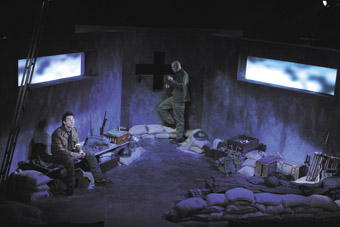
Joseph Del Re, Brendan Rock, Dogfall
photo Nic Mollison
Joseph Del Re, Brendan Rock, Dogfall
THE ‘THEATRE OF WAR’ IS A CURIOUS PHRASE WITH AN IRONIC RING. IT CONJURES AN IMAGE OF GENERALS, COMFORTABLY AT WAR, GATHERED AROUND A MAP ON A TABLE IN THE OFFICERS’ TENT, ARRAYING THEIR FORCES, THEIR PAWNS, IN WHAT SEEMS AN IMAGINARY GAME, A REPRESENTATIONAL FRAME, DIVORCED FROM THE ACTUALITY OF THOSE FIGHTING THE WAR.
That great 19th century theatrical shift—from actor-manager on the stage to theatre director in the auditorium—had an antecedent in military practice. By the time Carl von Clauswitz coined the phrase in his book On War (1832), the generals had long ceased leading armies into battle. Like the leading men of the theatre, they had retreated from the main action on stage. Modern war, like modern theatre, was to be directed from a distance.
These days wars fill our screens with their spectacle. Their ‘shock and awe’ imitates the animated splatter of computer games while, in the intimacy of our theatre, playwrights, actors and directors conduct laboratory experiments in the trauma psychology of men at war. Caleb Lewis’s Dogfall is a well-pedigreed play, declared ‘wonderful’ by American playwright Edward Albee, with whom the Australian Lewis undertook a two-week workshop on another of his plays. The wonder, I think, is Lewis’s imaginative insight into war and what can make us care.
The scenario is a war-time convention. Will (Brendan Rock) and Jack (Joseph Del Re) are soldiers, mates in the adversity of war. Life in the trenches means living it rough and doing it tough, while the battle rages and rumbles like thunder off-stage. They are disturbed by a third. A boy soldier, Alousha (Martin Hissey), becomes the unwitting target for their rough love, their piss-anguished fear, their gut-empty catharsis.
Director Justin McGuinness commands the energies of emotional realism from the actors. They sweat with fear and eat tinned food for real. They smoke on stage and drink and swear like troopers. They piss and shit copiously off stage to dysenteric sound effect. With the synaesthesia of intimate theatre, the production’s signifiers mingle in my nostrils: whatever the conflict, war stinks.
Lewis arrays the wars of past and present like tin cans in a rough-shot shooting gallery. While the characters conform to the continuities of drama, the theatre of their war changes with each scene—the Somme, Edessa, Guernica, Nanking, Northern Ireland, London, Treblinka, Stalingrad, Japan, Korea, Vietnam, Phnom Penh, Israel, Mogadishu, Kuwait, Home (as comic interlude), Bosnia, Rwanda, New York, Guantanamo Bay—till we end up bogged down in mud, mired in oil and blood with the dying and the dead.
Yet sitting in the audience, it’s for neither Will, Jack nor Alousha that I care. Their suffering is tarnished by the complicity of their guilt. In this theatre of war, there are no conscientious objectors, no women and children to be spared. I am desensitised to all but dogs, that fall mysteriously from the sky on the screens behind. I see an Alsatian falling, a Saint Bernard, a Dalmation. A spotty mongrel falls. I yelp in pain. “It’s just meat”, says Will. But not to me. I care.
TheimaGen, Dogfall, writer Caleb Lewis, director Justin McGuinness, performers Brendan Rock, Joseph Del Re, Martin Hissey, design TheimaGen, Tsubi Du, sound Peter Nielsen, lighting Nic Mollison; Bakehouse Theatre, Adelaide, Nov 2-17
RealTime issue #82 Dec-Jan 2007 pg. 33
© Jonathan Bollen; for permission to reproduce apply to realtime@realtimearts.net
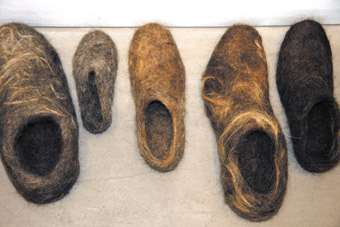
Roza Ilgen, In My Shoes
photo The Bellasis Bros
Roza Ilgen, In My Shoes
IN A RANGE OF EVENTS IN GALLERIES AND MUSEUMS AND CULTURAL CENTRES THROUGHOUT THE UK, 2007 IS BEING COMMEMORATED AS THE 200 YEAR ANNIVERSARY OF THE ABOLITION OF THE SLAVE TRADE. IN BRISTOL, ARNOLFINI’S RESPONSE TO THE ANNIVERSARY IS DISCURSIVE, RATHER THAN DIRECT, AN EXAMINATION OF THE WEST’S IMPLICATION IN PAST AND CONTEMPORARY PATTERNS OF GLOBAL EXPLOITATION. THE RESULT, PORT CITY, IS A MAJOR CROSS-ARTFORM PROJECT EXPLORING ISSUES OF MIGRATION, TRADE AND CONTEMPORARY SLAVERY, CONCERNED WITH THE SIGNIFICANCE OF THE PORT “AS GATEWAY TO A WIDER WORLD…A SYMBOLIC SITE OF CULTURAL EXCHANGE.”
During the Port City Live Art Weekender at Arnolfini, I felt I was truly being engaged as a global citizen, by other global citizens, the artists: an unruly bunch of compromised, ambivalent, intercultural border-crossers. Much of the work was about being in one place with roots in another; translating/making analogies between one situation and another.
brennan, speakman
Both Tim Brennan and Duncan Speakman invoked a sense of moving through the English landscape, crossing long lines of traffic or transport or time, connecting urban to rural, historical to immediate. Brennan, in Performing Northumbria: Empire, mediated his story through deliberately informal, low technology journal keeping and conversation, reading aloud from William Hutton’s early 19th century account of walking Hadrian’s Wall. Assisted by rather gauchely literal props—an actor dressed as a Roman legionary, a large stuffed eagle, a child’s umbrella with mouse ears—he had audience members volunteering for various story-assisting duties, including several people reading extracts from Hutton’s journal in a chorus of overlapping voices.
Speakman, using high-tech recording and mixing in For Every Step You Take, I Take A Thousand, constructed a sound picture of a four-day walk taken through countryside fields into Bristol. Recordings made during that journey—Eastern European farm workers, drinkers in a pub, birds in hedges, an aeroplane passing, traffic—could be listened to either through the studio speakers or, more intensely, through headphones. Speakman mixed and processed the sound live for the audience in a tightly-controlled, evocative work.
curious
In (Be)longing, Curious made play for us with their culturally-determined, authentically inauthentic selves—middle-class English intelligentsia and dislocated Texan—in a delicate, funny piece about longing and identity. Under a glowing neon road sign they addressed the audience, wryly performing failure to be a shit-hot guitarist, or failure to evolve into a higher being through yoga; gently demonstrated the ordinariness of disappointed aspirations. Also showing was a short video piece bu curious in which a group of young women, teenage asylum seekers, were asked about their wishes, hopes and fears. All are likely to be deported once they reach the age of 18, fracturing any sort of continuity in their lives and educations. The link between video and performance was tenuous, but there was an attempt to find common ground between very different women’s lives, and to use the empathy thus poetically engendered as the basis of political awareness.
patel and bradley
In Morris Dancing, a piece about cultural exchange and mirroring, Hetain Patel and Alex Bradley posed adjacent to each other. The skin of each was decorated with henna in patterns derived from William Morris wallpaper, a deliberately hybridised system of signs highlighting a specific moment in their two countries’ long history together, echoing down from the British Raj into the present. Spotlit but separate in a dark space edged by the boundary marking of a strip of wallpaper, each fell into their own rhythm and style of display, relaxation and camouflage, sometimes resting, sometimes seated, sometimes laid against the wallpaper as if to match the pattern on it.
jiva pathipan
Jiva Parthipan’s Necessary Journey related the snafu details of an attempted trip to take up an artist’s residency. Seated at a desk, Parthipan (an Asian artist of Sri Lankan heritage) read out official letters he had received from embassies, from the Home Office, from the Arts Council, accumulating the narrative of a completely thwarted journey to Mexico and the US. He would periodically interrupt himself to step to one side of the desk, take some of his clothes off and transform, through mannerisms, into first a dog, then a monkey, and finally, nakedly, into plain humanity, explicitly glossed in the program notes as ‘godhead’, the divine.
That evening, from the same artist, we had a treat in the shape of cabaret from the Al-Quaeda State Ballet, supported by free rum for the audience. It would have been alarming if it hadn’t been so impish—there was jumping and gyrating and a sort of Ninja can-can—clothes came off at some stage—there were black tights involved but those could have been on his head…
harminder singh judge
A godlike man, his bearded face and head painted blue, delivered his urgent, incomprehensible Live Sermon to us, the audience in the dark, from a speaker placed in his mouth. Dressed in a heavy silk skirt, Harminder Singh Judge (whose work is rooted in Hindu and Sikh religion) stood in a wide shallow dish of luminous-looking milk—an effigy, a mouthpiece, a resonating instrument, an avatar. Afterwards an almost invisible trace of his presence was left in the milk, a cloudy blue shadow, an indecipherable portent, a stain from the hem of his skirt.
qasim riza shaheen
In the Light Studio for Qasim Riza Shaheen’s Queer Courtesan, I’m instructed to select one of a bunch of old vinyl 45s scattered by a portable record player, one of those 60’s affairs that folds up into a little briefcase. I discard an old pop song and a couple of discs with Urdu titles in Roman script to choose a polka. There’s a booth to the side, fairground colours, a plastic strip curtain in the entrance. I’m ushered inside. I sit down.
I can see a shadowed human figure behind a transparent sheet of plexiglass just in front of me. The light changes and I’m in the dark, the figure spotlit. Dressed in a heavily embroidered silk sari, fanfared by the music, a gaunt, graceful, heavily made up man with a martyred, ecstatic expression begins to primp and preen and touch himself up. It’s suggestive, but tasteful.
I’m just relaxing into it when the light goes off, the music stops, that’s it, that’s my lot. No more technicolor, no more polka, no more tease. It was so well-timed for maximum frustration, I was sure he’d been looking at me (the program notes explain he only sees his own reflection). If I’d been a punter I’d be angrily banging on the glass—but I’d also pay up for another five minutes. Seduction, I guess, has to be about something you can’t get: a satisfied client has no further reason to pay. However I remain unenlightened about the relationship, mentioned in the program notes, between dance and prostitution.
Queer Courtesan manifests too as a video installation in the Dark Gallery with six telly-sized video screens across a wall. In each the artist presents a cameo of a different individual: he impersonates, or represents, one of the Khusra, transgendered sex workers of Lahore he worked with over a period of two years. He wears that person’s clothes (elegant female clothing) against a backdrop of their habitat—their room, or their street corner. One of the rooms is white and shiny, full of electrical equipment and speakers. Another screen shows a couch on the street beside a smoking fire and a tyre swinging from a rope. On another screen the artist sits in an armchair; on another he dances. His costumes are ornate and appear expensive. Looking straight at the camera he strikes attitudes, displays cleavage, plays with a scarf, tears his hair.
A studied invocation of The Virtuous Woman haunts each of these drag acts, trailing implications of forbearance and tenderness and of sacrifices made on the altar of love; meanwhile the tease is tremendously aggressive. It lures you in, so to speak, only to slam the door in your face. One of the cameos actually does this: the artist comes closer and closer to the camera until his face fills the frame; he seems to be just on the verge of being available and, then, bang! The door of the booth slams shut, with you, the client, on the outside, in darkness.
Shaheen impersonates Khusra for the gallery in a way that could not be done without their justified cooperation and trust. The artist places himself as a conduit between the community and the outside world: he does it with beauty and one hell of an attitude. Histrionic and very alluring, at the heart of the work one can discern contempt for the client combined with a yearning for love (maybe clients are to be punished for not being that mythical creature, ‘a real man’). The performances ooze with a defiant sense of entitlement which is linked to the visual portrayal of an ideal of exquisite suffering; and the viewer is uncomfortably cast in the role of john, with all the complicity and self-deception that entails.
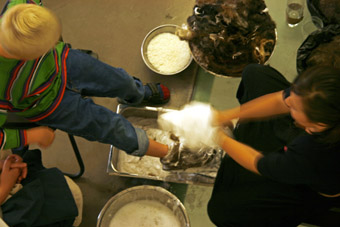
Roza Ilgen, In My Shoes
photo The Bellasis Bros
Roza Ilgen, In My Shoes
roza ilgen
The foyer at Arnolfini is open all the way up the stairwell to the top floor, all clean white angles around the brushed steel lift-column. A young woman sets up camp here. The niche she creates is untidy, like a market stall. She sits on a low stool, with a dish of viscous white liquid to her left. Two chairs face her, and on her right are big metal basins heaped with dark fuzzy patties of what looks like felt. It’s a terribly organic colonisation of that clean white space.
She’s an attractive, personable presence, facing onlookers with friendly engagement. She could be…Southern European? Latina? South Asian? Her dress contains a nod towards the Orient in that she’s wearing calf-length black jersey shalwar; these look, however, as if they could have come from Gap. In other words, this woman in her untidy territory looks completely cosmopolitan.
On enquiring what she’s doing, you could find yourself seated in front of her with one foot on a low stool placed in a basin of soapy water, while she smears suds over a disc of human hair placed round your foot to make a felt slipper. Similar slippers line the walls of the foyer, all sizes from toddler to galumphing size 12, and in all colours. Of hair, that is, which means in fact brindled. It seems the colour of human hair in Europe, while not absolutely mousy, averages out to brown. When I speculated that in a different country this base colour would be different my assumptions about Scandinavians were quickly corrected! Bin bags full of hair had been collected from 20 different hairdressers in the city and the artist had prepared a supply of felted discs ready for the installation.
Looking at the circles of hair packed into the bowls, you begin to conjure up presences. That person, a rarity, has black hair, and had a complete change of style judging from the quantity cut off; that must be a child with fine blond curls; that person just had a trim; that one is going grey, and oh vivid, there’s a redhead! The spectre of these invisible donors is urgent, and you’d imagine that having your foot swaddled in their off-cuts would be intrusively intimate, but it isn’t. It’s workaday, mundane, like getting a manicure or being measured for a bra. Distancing kicks in, and the process feels like just another variant of the service industry.
Roza Ilgen wrapped my foot in cling film, shaped a circle of human felt around my heel with warm soapy water, moulding more patches onto it to make up a slip-on bootie. She really got into it, kneading and squeezing gently, pouring on more soapy water, covering the toes, building up the throat. When she was satisfied she tackled it with a hair dryer, felting the material more. Then she eased the boot off. It was still damp but held it’s shape, looking sturdy and, already, well-used.
As a black woman I bring such a heavy set of interpretations to the symbolism of hair, I was in danger of missing what was happening here. I wondered about the rows of empty shoes bounding the space, facing the wall, the possible ethnic presences or absences indicated by hair type and colour. I missed the analogy with shoes removed at the door of the mosque—in this case facing a blank wall rather than pointing towards a place of worship.
I nearly missed this beautiful, pragmatic, deeply subversive gesture for what it was: a stubborn exercise in de-mystification and defiance. Ilgren performs a personal service for an audience, engaging them, drawing them in. Meaning streams from her presence in the middle of the activity: she is a Kurdish artist, one of the people without a country, just for now treating the gallery like a cottage industry squat. She takes a material attribute of humans that is, within Islam, culturally loaded and prescribed in a specifically gendered way: with this she makes public, workmanlike, hardy artefacts. Artefacts that are meant to be trodden on. Artefacts that somehow infect the conceptually clean gallery space with some of their own physical fuzziness.
Port City Live Art Weekender, Arnoflini, Bristol, UK, Sept 28-30
RealTime issue #82 Dec-Jan 2007 pg. 34
© Osunwunmi ; for permission to reproduce apply to realtime@realtimearts.net
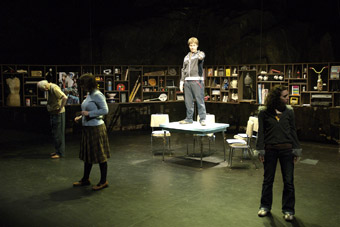
l-r – Ron Haddrick, Sara Cooper, Jonathan auf der Heide, Jemma Gates, Beyond the Neck
photo Tony McKendrick
l-r – Ron Haddrick, Sara Cooper, Jonathan auf der Heide, Jemma Gates, Beyond the Neck
TOM HOLLOWAY WAS 17 YEARS OLD AND WORKING IN A PIZZA SHOP IN HOBART WHEN THE TRAGEDY AT PORT ARTHUR UNFOLDED IN 1996. HIS PLAY, BEYOND THE NECK, A STORY PERFORMED 10 YEARS LATER, IS HIS POWERFUL RESPONSE TO THE EVENTS OF THAT DAY.
An arc of shelving containing family memorabilia wraps around the performance space. Isolated in compartments these artifacts include a transistor, phone radio, wireless, pair of binoculars, traffic cone, model ship, horseshoe, red safety helmet, photo developer, dartboard, pair of red shoes and a model of a colourful Montgolfier balloon. Most of these embody a nostalgia for childhood and the shared times of family life. Because we are alert to the symbolic significance of many of the items, this miscellany of memory also evokes a sense of menace and foreboding.
Four strangers are seated at a table. They introduce themselves as a boy (Jonathan auf de Heide), teenage girl (Jemma Gates), young mother (Sara Cooper) and a tour guide (Ron Haddrick). They offer fragments of their story interspersed with interruption and disjuncture. Each character strategically draws on the device of a closing imperative such as “No!”, “Stop!” and “What!” These intercessions deflect a specific or difficult strand of thought that threatens to summon terror, blame or dread.
It’s Sunday. Making their separate journeys by car or coach are the boy, the teenage girl and the young mother. Inevitably someone is whingeing. The teenage girl is cramped in the back of a car with her knees jammed under her chin. She resents her mother’s intimacy with the driver, her father’s best friend. The boy is hyper-excited because his friend Michael is traveling with him—or is he? The young mother is part of a mystery bus tour with a blue-rinse mob. She turns toward the rear of the bus to ensure that her husband David and daughter Molly are present—or are they?
It is this indeterminacy of past, present and future that contributes to an inexorable build of tension. Our knowing and imaginings are already filling in the spaces. Through an interweaving of narrative and back-story, our apprehensions hover about the temporal uncertainty and the indeterminate fate of these Sunday travellers.
The Neck is a narrow strip of land a few hundred metres wide, 83 kilometres from Hobart. To cross The Neck is to be inexorably drawn to the former penal settlement of Port Arthur. This prison was modelled on Jeremy Bentham’s Panopticon which functioned as a round-the-clock surveillance machine where each prisoner was left alone in the dark without sound or name, inevitably raving into madness. We are similarly seated in the darkness of the auditorium while observing each character’s terror, grief and compassion unfold.
Waiting at Tassie’s top tourist attraction to meet his next tour group and unleash his “old fart’s bad jokes” is the tour guide (Ron Haddrick). When he welcomes us to the Visitors’ Centre our indeterminate journey begins. The impact of that day on each of the characters is gradually revealed. Again we are reminded of the cruelty of sudden absence: the boy hears his friend Michael urging him to act, the teenage girl grieves the loss of her father, the young mother recalls her terror when she is locked in the darkness of a solitary cell. Ten years later the tour guide is still fending off intrusive questions and angrily refers to the “bullshit” of ‘closure.’ “Were you there?”, the teenage girl asks the tour guide and an autumn chill slaps our necks.
Beyond the Neck was one of five plays out of 400 entries to be chosen for presentation as part of the Royal Court Theatre’s International Young Playwrights’ Festival in London. Holloway structures his play so that through fragments and overlays of story, through the fluctuation of presence and absence, four strangers find connection, solace and possible redemption.
The events at Port Arthur reverberated around the world. To echo the words carved in stone at the memorial site: “…cherish life for the sake of those who died. Cherish compassion for those who gave aid. Cherish peace for the sake of those in pain.” Holloway’s tautly crafted work offers a theatre of renewal for and of our time.
Beyond the Neck, writer Tom Holloway, director Iain Sinclair, performers Jonathon auf der Heide, Sara Cooper, Jemma Gates, Ron Haddrick, design Jamie Clennett, lighting design Daniel Zika, composer, sound designer Steve Toulmin, An Argy Bargy Production presented by Tasmania Performs; Peacock Theatre, Hobart, Sept 12-15
RealTime issue #82 Dec-Jan 2007 pg. 35
© Sue Moss; for permission to reproduce apply to realtime@realtimearts.net
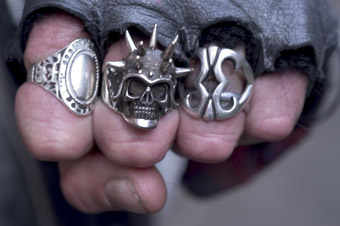
Hotel Obsino
I MUST CONFESS TO HAVING SPENT A SOLITARY NIGHT IN THE SIR CHARLES HOTHAM HOTEL, SPENCER STREET MELBOURNE. AS THE INSPIRATION BEHIND ADAM BROINOWSKI’S PLAY HOTEL OBSINO, I ALMOST FEEL AT HOME AMONG THE STICK BOOKS AND SYRINGES LURKING WITHIN THE FLOTSAM ON LA MAMA’S FLOOR. IN A BOOTH BENEATH THE STAIRCASE SITS A SO DESCRIBED CURRY-MUNCHING CARETAKER. CORNERED BY BOUTS OF CROSSWORD CONTRIVED WISDOM, BUDDHIST RHETORIC, OUTBREAKS OF RESIDENTIAL MADNESS AND INCOMING INDUCTEES, HE IS BOTH MANAGER AND MADMAN. ENTER NOAH, ON THE RUN FROM EVERYONE, INCLUDING HIMSELF.
Searching for solace in this ark of decay, Noah is the ballast Hotel Obsino requires. Well, somebody’s gotta ‘keep it real’ amidst death, drugs, life sentences in rooms that resemble Sadean dungeons, madness, despair and the Devil’s delight circulating within a purgatorial twilight…In doing so, Noah discovers that he also is an accomplice of the criminally insane.
A parade of dying souls descends the staircase, beginning with a young woman wearing a negligee and carrying a bucket. Miss Jones squats and piddles, then pats her pubis with a sheet of toilet paper. Singing “It’s a fine line between pleasure and pain”, she exits stage left. Obsino is a man’s world, and I cannot help but wonder what the women in the audience are feeling… Excluded perhaps, like the Aboriginal, Noodles, who after unleashing a moment of squawking madness, is only ever seen wandering alone through corridors, sitting invisible, listening to whitefella attempts at camaraderie, or crossing off the days in chalk on a wall in what might be his room, but could also be a memory of incarceration at Grafton Prison. Bigotry never takes a holiday, and nor do the relentless days and nights filtering through cracks in walls from an outside world that is only ever referred to in paranoid terms. A tourist with a typewriter, Noah will eventually jump this Ship of Fools. As for the other residents, they’re down here for the the term of their natural lives.
Dave has a swastika tattooed on his neck and may have been baton raped while doing three with a five. Fabio dreams of having sex while his cock is wrapped in a nail studded towel. Gold is a jive talkin’ junkie hybrid of the Wogboy and the Universal Soldier. Felix and Doug are curious creatures. The former is a sentimental European who recreates his mother in his room; the latter, a religious nut primed with a fear of the Devil that is explosive when unleashed upon Noah. As confidante, Noah commiserates, and is complicit in the anti-life of each fruitloop. But all are united by survival on the edge of a metropolis that itself may be a manifestation of insanity. Common to all these characters is a fear of religious damnation. In this sense, Hotel Obsino is an examination of people trapped in purgatory. Driven mad by an inability to relinquish a belief in the Divine, each slowly self-immolates.
Having myself spent seven years living in a notorious St. Kilda dive, I can vouch for the authenticity of Hotel Obsino’s characters.
Hotel Obsino, writer, director Adam Broinowski, performers Le Roy Parsons, Eric Mitsak, Tahir Cambis, Tom Davies, Brendan Bacon, Melanie Douglas, Craig Hedger, Dylan Lloyd, Polish Larsen, Greg Ulfan; La Mama, Melbourne, Sept 12-30
RealTime issue #82 Dec-Jan 2007 pg. 35
© Tony Reck; for permission to reproduce apply to realtime@realtimearts.net
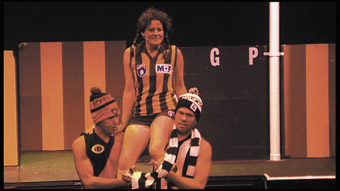
Raymond Wright, Tanya Langdon, Donald Mallard, Barracking
photo David Nixon
Raymond Wright, Tanya Langdon, Donald Mallard, Barracking
AWARENESS OF THE HUGE CULTURAL SIGNIFICANCE OF AUSTRALIAN RULES FOOTBALL FOR INDIGENOUS PEOPLES IN THE NORTHERN TERRITORY HAS ONLY RECENTLY BEGUN TO DAWN ON WHITE URBAN AUSTRALIANS. THIS HAS BEEN DESPITE THE FAME OF INDIVIDUAL ABORIGINAL PLAYERS FROM THE REGION WHO HAVE SUBSTANTIALLY LIFTED THE GAME OF LEAGUE TEAMS IN THE SOUTH. IN THE WAKE OF THEIR SUCCESS WITH MICHAEL WATTS’ NOT LIKE BECKETT (RT81, P32), ALICE SPRINGS’ RED DUST THEATRE HAS NURTURED ANOTHER FASCINATING PLAY, THIS TIME ABOUT FOOTBALL, AND TOURED IT THROUGH THE TERRITORY.
Katherine-based writer Toni Tapp Coutts, who saw the play in her home town, describes its tone as “although heart-wrenchingly honest, essentially comic.” She writes,”Barracking does not take the easy road. You squirm in your seat as Cuz tells the ambitious young footballer Brownie in no uncertain terms what it can be like to be a blackfella in the city. Coutts thinks that “the focus on the shared faith of football, almost a religion for many Australians, allows the play to confront issues of racism, love, family pressure, community demands and the internal struggle of a young man who wants to be a great footballer in the city, playing for his beloved Hawks, but doesn’t want to let down his home team, family and friends.”
Written by Jane Leonard (a long-time writer who moved to Alice Springs nine years ago) and Steve Gumerungi Hodder (a Mornington Island man who has lived much of his life in the Alice as an actor and broadcaster), Barracking is, on the page, a brisk and engaging account of a developing romance between Brownie and a Melbourne writer, Goldie, who has moved to Alice Springs after the death of her father. A series of brief encounters where Goldie is sometimes the only white person at a community match bring the two closer together, a shared passion for the Melbourne-based team Hawthorn providing common ground. Brownie has the talent to play for the Hawks and yearns for the accompanying luxuries in contrast to the poverty and despair that surround him. His cousin, Cuz, has lived the life of the footballer in the city, a venture undone by white racism and his own stubborness. Brownie is undeterred, he already knows racism. However, when the ‘draft’, the search by white coaches for black talent, ensues and Brownie is told by his coach to give up his community team coaching, his love for Goldie and a vision of a Northern Territory team taking on the south creates a new future for him and his community.
Threaded through this tale are scenes, often comic, of Goldie’s evolution as football fan (and writer, as she mimics sports broadcasters) from childhood to adolescence and university, in each period having to restrain her passion for the Hawks in the interest of not upsetting male domination of footy fandom. The exception is her beloved father with whose ghost she affectingly chats to in a cemetery before taking off for Alice Springs, saddened by her loss and deploring the corporatisation of the AFL. In the Alice she finds both love and a community-based football that reminds her of better times.
Barracking is often overtly didactic (Goldie’s Armenian heritage, for example, is a loaded late addition to the story) and in the end it’s wilfully and jovially sentimental, largely because there is no scene where we witness the emergence of Brownie’s vision and the struggle to realise it—we find out about it after the event. Similarly, although the developing relationship between the lovers is nicely handled, the challenges to it becoming a marriage are sidestepped (even though Brownie is elsewhere as frank about Aboriginal racism as white) and the birth of their first child simply announced. Although there are clues to Brownie’s background in his chats with Cuz, there’s not the same attention paid to his growing up as there is to Goldie’s—how did he become a footballer, what of his relationship with his relatives, how is it he’s escaped the pull of alcohol and other traps?
The great strength of Barracking, however, is in its language—the footy coach with his mouthfuls of mixed metaphors, the droll humour that seems an inherent part of the riches of Aboriginal English, and the playwrights’ often deft handling of dialogue. There are ample engaging cultural details, for example in an exchange on playing aids: “Cuz: He was cheating anyway. Them Nungkara rub that ndura on his legs. Brownie: Can’t be. May as well be on steroids, dirty camp dog! So where you get that stuff?” Later, Goldie comments that a player “leaps like one of these big red roos.” Brownie explains: “You know why? He been sung. Them old men sing all night for him, then they call for that wallaby, eagle, kangaroo, anything. Transform him. He’s that kangaroo now.”
Issues of race and culture are woven through the narrative: “Cuz: How any white blokes know your skin, your totem? They don’t know our language, our country. They don’t know ‘cause they got none either.” Brownie is shocked when his white team mates treat him as one of them while using racist language: “like I wasn’t there…it was like them pretty boys didn’t even think I’m black.” And Cuz speculates on cultural difference: “Why you think they don’t have a Territory team in the league? We got enough talent here for a half decent team…Money, that’s why, footy all shop now. Them management take care of business, not spirit. That’s why us blackfellas all over the shop. White man worry ‘bout money first, then spirit after.”
In performance, says Tapp Coutts, “Brownie and Goldie are surrounded by an assortment of characters capably played by just two actors: the bitchy girls on the netball team in Goldie’s teenage years, a university professor, a beatnik boyfriend, the disillusioned Indigenous player who has returned to the Territory, the ghost of Goldie’s father and even an AFL ‘Bishop.’ Raymond Wright, who plays Brownie and has enormous promise, was sighted by director Craig Mathewson at a shopping centre only five weeks before the tour.”
Tapp Coutts reports that “Barracking toured remote regional Northern Territory during August, playing to small crowds of devoted theatre-goers in the Ti Tree Indigenous Community, the Ali Curung Indigenous Community, Tennant Creek, Katherine, Timber Creek and at the Darwin Festival and the Alice Desert Festival. It was a miracle that the performance went ahead in the small town of Timber Creek, 300km west of Katherine, as the road crew vehicle and trailer—with all the staging, sound and lighting—rolled over three times, the equipment strewn across the highway. In true Territorian style the actors proceeded to Timber Creek with a clothes rack and costumes and performed, without sound or theatre lighting against a sheet-covered whiteboard backdrop, to an enthralled 40-strong crowd. Aboriginal children squealed with joy, calling out their favourite footy teams.”
–
Barracking, writers Jane Leonard, Steve Gumerungi Hodder, director Craig Mathewson, performers Tanya Langdon, Raymond Wright, John Robb Laidlaw, Donald Mallard, costume designer Franca Barraclough, lighting Greg Thompson, sound design Steve Gumerungi Hodder, Craig Mathewson, producer Danielle Loy, Red Dust Theatre, Alice Springs; Aug 14-Sept 8
Written by Keith Gallasch with Toni Tapp Coutts, a Katherine-based short story writer who works in remote indigenous communities as Project Coordinator for Katherine Regional Arts.
RealTime issue #82 Dec-Jan 2007 pg. 36
© Toni Tapp Coutts & Keith Gallasch; for permission to reproduce apply to realtime@realtimearts.net
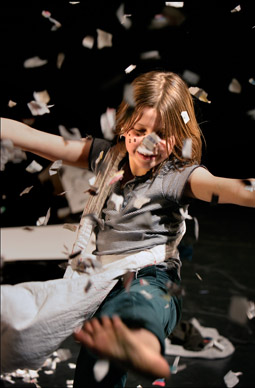
Martha Marthe Mathilde Matthieu, De Kopergietery
photo Phile Deprez
Martha Marthe Mathilde Matthieu, De Kopergietery
THE 11TH EXPLOSIVE! INTERNATIONAL YOUTH THEATRE FESTIVAL IS, ACCORDING TO THE PUBLICITY MATERIAL, ITS MOST POLITICAL PROGRAM TO DATE, THOUGH YOU WOULD NEVER GUESS IT FROM THE OPENING NIGHT’S SHOW, AMAZONIA, BY BRAZIL’S COMPANHIA APLAUSO. THE SHOW BEGINS WITH PERFORMERS TUMBLING ACROSS THE STAGE AND SCALING UP THE SILKS, ALL WHILE MAKING MONKEY NOISES. WELCOME TO THE JUNGLE. UNFORTUNATELY, THE POLITICS OF THIS PIECE ABOUT A RAINFOREST THAT HAS BEEN RAVAGED BY BOTH COLONIALISM AND NEO-COLONIALISM ARE COMPLETELY AT ODDS WITH THE POLITICS OF ITS PRESENTATION.
There were many uncomfortable moments but the image of a black man standing on stage in a leopard-print loincloth, beaming out at a largely Anglo-Saxon audience, and singing “Brasil!” stands out. Forget the jungle, welcome back to the 19th century, where bare brown bodies are displayed as exotica/erotica for your viewing pleasure. Skin, sex and some capoeira to boot—the Brazilians seemed to confirm every stereotype imaginable in a single performance.
I’m in Bremen, Germany, to perform with Sydney’s PACT Youth Theatre in The Speech Givers, a show which draws on the themes of previous PACT shows such as Toxic Dreams (RT73, p16) and Whistling Man (RT77, p44) but which was developed especially for this festival. After watching Amazonia we are beginning to wonder about what we are doing and why. What exactly is international about an international youth theatre festival? To what extent are companies expected to confirm or contest national stereotypes? And what would the audience make of an Australian show about a series of speech acts that only sometimes succeed?
Perhaps the highlight of the festival was Sehnsucht (Longing or Desire), directed and choreographed by Belgian Ives Thuwis and performed by the Forum Freies Theater from Dusseldorf. It begins with the director dancing, slowly at first and then with increasing rapidity until his breath becomes laboured and loud and he retreats to the side of the stage. In what follows, 11 performers aged between 10 and 20 proceed to evoke the barely contained chaos of a party without parents. To the strains of Dusty Springfield’s “Son of a Preacher Man”, Audrey Hepburn’s rendition of “Moon River”, and Sonny and Cher’s “I Got You Babe”, a young woman sips water through a straw from the crevices (ribs, clavicle, navel) of a young man’s torso. There is a tense pas de deux between two teenage boys, which proves too much for one of them so he heads across stage and tackles a teenage girl to the ground. She escapes his grasp and stalks off to the couch to sit in a silent sulk, trying but failing to avoid the early onset of post-party blues.
The younger children are oblivious to all this teenage angst, busy as they are playing ping pong, hiding under the table and sending out a string of paper boats across the floor. Once in a while the two groups interact—a young boy spies the sulky girl changing and decides to steal her dress. One tender moment has three of the older members of the group spooning their slightly younger counterparts. It is as if they are already dancing with younger selves, a reminder that you are never too young to experience nostalgia and that even at 16 you can still miss your 10-year-old self. More importantly, it reminds us that there is no such thing as a singular ‘youth’ and therefore no such thing as a singular ‘youth theatre.’ The piece comes to climax with an ecstatic version of Lesley Gore’s “You Don’t Own Me” before the director, who has been standing and watching the entire time, comes back on and dances again.
The songs are the soundtrack of the director’s youth not the performers’ but because the work is so accomplished we tend to forgive him the indulgent framing device. Besides, perhaps it’s a metaphor for working in youth theatre where one is forever standing ‘in the wings’, casting an adult eye over the chaos, trying to harness erratic energy while instilling a degree of discipline in those beautiful bodies that, ultimately, are not yours to inhabit or even to inhibit. Indeed, they always emphatically reply, “You Don’t Own Me.”
Thuwis also collaborated on a performance on the next night, Martha Marthe Mathilde Matthieu by De Kopergietery (Gent, Belgium). Each child of the title worked with a professional choreographer, resulting in four curious portraits. These might also have been called Bedroom Boredom because they are about what children do—or more accurately what adults think they might do—when left to their own devices. The first girl walks in wearing what looks like a red party dress but she soon throws it off in favour of some far more comfortable black pants and a loose blouse, freeing her to gallop around the room. She flings cushions about with abandon, turning them into a trampoline to bounce on, a sea to swim in, and skates to glide on. She is utterly absorbed and utterly absorbing but when an older girl comes in wearing her party outfit and carrying a birthday cake, the smaller one scampers off.
Alas, this new girl does little more than loll about on the floor like Lolita. While the piece itself is uninteresting, the juxtaposition with the previous portrait is arresting. What is it that happens to girls? How can someone be so full of agility and agency and then a few short years later be boring beyond belief, desiring nothing more than to be desired? The contrast between this learned feminine passivity and masculine activity becomes even more apparent when a teenage boy enters. He doesn’t have half her grace but he is far more intriguing. Loud music blares from his laptop and he lurches around the room, doing bad stunts and telling bad jokes but thinking sweet thoughts. Eventually he steadies himself while listening to the Counting Crows intoning, “I am ready, I am ready, I am ready, I am.”
The extensive use of popular music—entire songs played back to back—recurs throughout the festival though not always to the same effect. In fact, the songs in Schauspiel Essen’s show Homestories (ballads for the girls and hip hop for the boys) are interspersed with the personal stories of the performers, as well as some odd but occasionally compelling video footage they shot in and around their home town of Essen-Katernberg. Unlike Sehnsucht and Martha Marthe Mathilde Matthieu, Homestories is instantly recognisable as ‘youth theatre.’ The production was facilitated by Armenian director Nuran David Calis who lived in the city of Essen’s troubled social district of Katernberg for six months while collecting the stories of the young collaborators, many of whom are migrants. Homestories had been awarded the Sociale Stadt 2006 (Social City 2006) prize so perhaps the social coherence it promotes is more important than the artistic coherence it lacks.
What is obvious from these three performances, as well as from the production of Hamlet (co-produced by the festival’s German hosts, the Schlachthof theatre, with the Dutch company Growing Up in Public theatre and the Danish director Jeroen Kriek) is that they do not explicitly engage with notions of nationality. Indeed, through the very fact of their being, these ‘international’ collaborations simultaneously ignore and problematise the idea of the nation. This implicit approach contrasts with the rather blunt approach of the last show, k-ENTER-n, which looks at issues of globalisation through a regrettably rudimentary lens. If Amazonia resorts to national caricatures then k-ENTER-n, which was also produced by Schlachthof theatre, resurrects socialist clichés. The play has evil corporations threatening to take over the world via the internet and the program even refers to the “stormy oceans of capitalism.” PACT’s The Speech Givers is neither an international collaboration, nor agit-prop theatre, nor an attempt to think through the identity of Australia. Even so, it may have been interpreted that way, with people commenting that the show was ‘very athletic’ or that they were expecting something ‘sunnier.’
Far from sunny, The Speech Givers depicts the necessity and impossibility of speaking in general, and of speaking up and speaking out in particular. The six performers prepare the space and then themselves to stand and deliver the speech of a lifetime. These public speeches are well-intended but ill-executed—white noise overwhelms one speaker while a wave of mass hysteria sinks another. More private speeches happen when performers accost one another as they stride across the stage, cruising the corridors of power. Once again, the speakers are inaudible, inscrutable, impossible. Ultimately, whether public or private, promising or compromising, these speech acts are also solitary acts, monologues that may or may not be understood by the addressee. The piece finishes with the six performers and the sound artist walking to the front of the stage and sitting face to face with the audience. Together they listen to the strains of Elgar’s Chanson de Matin and look at the strain on each other’s faces, suggesting that perhaps the most radical speech act of all is to sit and listen, to try and move beyond monologues towards dialogue.
Perhaps this is the point of the festival more generally: to introduce artists to other artists and to other audiences and in doing so to start a quiet conversation. Nothing more and nothing less, but still no mean feat in an age of megaphone diplomacy.
1tth Explosive International Youth Theatre Festival, Bremen, Germany, Sept 14-15, www.explosive-info.de
RealTime issue #82 Dec-Jan 2007 pg. 38
© Caroline Wake; for permission to reproduce apply to realtime@realtimearts.net
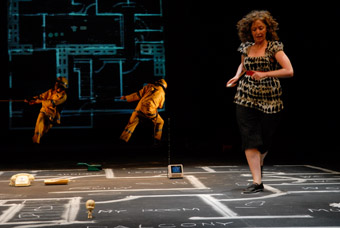
Louis Fitzpatrick, David Buckley,
Deborah Pollard, Blue Print
photo Heidrun Löhr
Louis Fitzpatrick, David Buckley,
Deborah Pollard, Blue Print
FOR FRENCH PHILOSOPHER GASTON BACHELARD, THE CHILDHOOD HOUSE REPRESENTS THE SHAPE OF THE HUMAN PSYCHE: A MEMORY CONTAINER STACKED WITH DELICATE OR DANGEROUS TRACES OF THE PAST. STAIRWAYS, LINEAR AND ANGULAR; OPEN-PLANNED SPACES LEADING INTO LIGHT AND SHADE; UNDERGROUND CELLARS THAT REPLAY THE DARKER RECESSES OF THE MIND. THESE ARE THE CAVITIES AND GEOMETRIES IN WHICH WE GROW ACROSS TIME. WE EMBODY THESE SHAPES AS THEY SHAPE US. THINGS GET STORED IN SUCH SPACES: OUR OBJECTS (A BROTHER’S LOUD‘N’DUSTY LED ZEPPELIN COLLECTION) AND OUR MEMORIES (ANGER, GRIEF, RAGE…A PETRIFYING AND ANGUISHED SCREAM ACROSS THE TELEPHONE…).
Deborah Pollard’s personal reflection on the loss of her childhood home in Blue Print is a reverie in response to the devastation of the 2003 Canberra bushfires. “After a firestorm”, the opening projections explain, “there is silence…no lawnmowers…no trees.” These bushfires are remembered for their absolute destruction, swallowing two thirds of the region in flames, gutting 501 houses and killing four people. For Pollard, it is the 501st house that offers a statistic of humanity amidst such mammoth anonymity. She likes to think of the oddly numbered house as her house; the one uniquely singled out amidst those many others.
A phone sits centre stage, ominous symbol of events to unfold. Around this, Pollard paces out the plan of her childhood house, using a linemarker to chalk the floor with rhythmic precision to reveal stairways and doorframes. Her poise is strong and calm but her actions (obsessively precise) tell a different story. In her act of both retrieval and grief, we watch the house emerge from muddied beginnings into a vision of its former glory. Recorded interviews are cut against Pollard’s action, and we hear relatives recollecting the moments leading up to what is now (we know) predestined destruction. Anecdotes, memories—the minute administrivia of everyday families in the thick of everyday life—crackle across the audio sphere. At times emotive, at times teetering unnervingly towards the feel of Australian Story reportage, voices fill the space with an empty, nostalgic echo.
Sentiment in words and action is undercut by the presence of three anonymous firefighters. Like bright yellow stock characters, they sprint across the space, pull ropes, or convalesce, blackened and exhausted, against a smoking Christmas tree. These are the uniformed tricksters who animate Pollard’s backstage psyche. They have moments of partytime, exhaustingly head-banging to Led Zeppelin’s Dazed and Confused (a comment on the dubious commitment of ACT authorities to the prevention of the fires?). They also have to deal with staggering grimness, pulling a heavy, life-sized dead horse—inanimate, flopping and falling across the space. The horse is rendered in a lifeless darkish purple, making it a metaphor for all the loss that this scene has witnessed. It is pathetic, ironic, tragic, disgusting: a striking image against the mundane simplicity of Pollard’s home world.
Sound (Gail Priest) and video (Samuel James) also introduce curious signifiers into the space. A door frame seemingly grows and retracts like a worm on the upstage projection screen. The door bleeds into visions of a burnt-out, trunk-laden landscape against the searing horizon sun: that archetypal image of an Australian bush summer, holding smells of Christmas and heat and soggy roast chicken in its iconography. Sound evokes an ambient melancholy, occasionally mimicking the gentle crackle of fire, but often gestures emotively, underlining stage action and story.
Blue Print is less about smoke and fire than the innate trauma of time passing: of losing the touchstone of what is most familiar and known. And yet, amidst such potency, there is an aura of stasis in Pollard’s theatre of recollection. We watch the performer looking at her leftovers—the psychic residue of her childhood home—without much hope of revelation. Memory is like this too. Cyclic and unrelenting, it can make inertia out of the very catharsis that it would rather seek. The poetic transcendence that theatre brings to stories of trauma can elevate the personal into a shared sense of insight and healing. In Blue Print I was strangely unmoved by the scenescape of recuperated bits and pieces. I couldn’t help thinking that all childhood houses disappear in one way or another—it’s how their corners and geometries have shaped us that counts.
Blue Print, devisor, performer Deborah Pollard, performers David Buckley, Daniel Fenech, Louis Fitzpatrick, dramaturg John Baylis, video design Samuel James, horse design erth, sound Gail Priest; Performance Space, CarriagWorks, Sydney, Oct 26–Nov 4
RealTime issue #82 Dec-Jan 2007 pg. 39
© Bryoni Trezise; for permission to reproduce apply to realtime@realtimearts.net
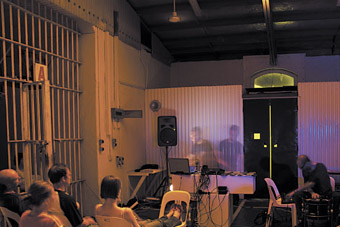
Sounds Unusual, Fannie Bay Gaol
photo Tanja Kimme
Sounds Unusual, Fannie Bay Gaol
THE 2007 SOUNDS UNUSUAL EVENT BEGAN IN ALICE SPRINGS THIS YEAR AS PART OF THE ALICE DESERT FESTIVAL BEFORE MAKING THE JOURNEY THROUGH DESERT TO COAST TO DARWIN TO PRESENT SURREALESTATE AT FANNIE BAY GAOL AND ISLANDS:CROSSING IN WHICH FIELD RECORDINGS BOTH AUDITORY AND VISUAL WERE COMBINED FOR MULTICHANNEL SOUND AND NEW MEDIA INSTALLATION AT THE DARWIN VISUAL ARTS ASSOCIATION (DVAA).
Director Rob Curgenven likes to gather audiences in historical Darwin sites, previously the WWII oil tunnels and this year Fannie Bay Gaol. These significant sites provide more than a backdrop, often dictating the overall listening compass. The essence of these events is an individual’s experience of a textured and tactile listening world, performed in a venue with great acoustic potential and theatrical presence.
The opportunity to explore the grounds and in particular the maximum security building where surrealestate was performed provided sombre reflections on 96 years of incarceration including that of Lindy Chamberlain. Many of the inmates gaoled here languished under appalling colonial policies which were racially prejudiced against Chinese and Aboriginal Australians.
Blastcorp (aka Kris Keogh), one of Darwin’s most invigorating performers, teamed with newcomer Ruben from The Fairweather Dolls to provide an appropriate ‘Welcome to Darwin’ set. Jason Kahn from Switzerland performed a solo for analog synthesizer and percussion, and then completed the event in an improvised duet with Curgenven’s field recordings and instrumental harmonics.
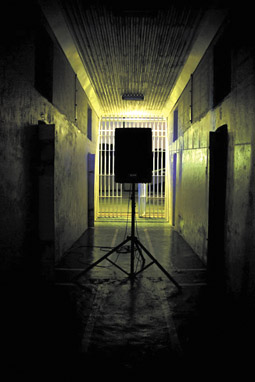
Sounds Unusual, Fannie Bay Gaol
photo Tanja Kimme
Sounds Unusual, Fannie Bay Gaol
Kahn’s sleight of hand across the snare drum created a gradual, entropic state change which was mesmerising. His right hand shimmered over an inverted cymbal while his left deftly controlled the output on the analog synthesizer. Minute changes to the position of the cymbal over the drum created dramatic sonic resonance via an overhead microphone. It seemed the slightest movement from the audience within the cell blocks also impacted on the sounds in the space.
There was a cyclonic build-up of volume as superseded sounds echoed down the darkened tunnels of cell blocks A & B. Speakers formed horizontal columns of sound either side of the audience.
The performance paralleled Darwin’s most famous sound recording, Cyclone Tracy, which plays in a dark room at the Northern Territory Museum & Art Gallery. The gaol is one of the survivors of that disaster. Kahn, perhaps unaware of this uncanny connection, drew us to an immersive finish of gentle dissipation.
Curgenven makes the point that sounds are fundamental to our perception of the world and significant to notions of the familiar and our sensing of otherness. Nature’s presence is pervasively felt in the Top End, not least in terms of time and place. Curvengen’s field recordings, a collection of over 250 CDs stacked in neat piles next to various portable CD players, was the result of many hours of recording from Alice Springs and Central Australia to Darwin via the Tanami Highway.
The complex micro and meso-structure of these field recordings suggested a time pattern for Jason Kahn’s processing. Curvengen’s collection included familiar sounds such as twilight crickets and dogs barking, as well as more all-encompassing sound events evoking specific places. The listener’s recognition of the source material completed the extension Kahn shaped for the overall composition and created an interesting counterpoint to his own continuum. Our ability to completely hear the complexities of a place and time is intersected by memories of the familiar which are in turn displaced and transformed.
The new media installation Islands:Crossing at DVAA featured Rob Curgenven’s field recordings and Katie Hepworth and Tanja Kimme’s photographs and video. A culmination of the journey these artists took from Alice to Darwin, the work recounts through stops and starts the visual and audio journey undertaken. For those who have experienced this road trip the travelling felt familiar. The distance expressed visually seems vast and often is told through zooming towards a point in the horizon. The moments of deceleration are quiet and reflect the field recordings heard.
As a diary piece Islands:Crossing suggests a rich source of material for continued performance.
Sounds Unusual, Northern Territory Festival of New Music, Alice Springs, Sept 8-18, Darwin, Sept 25-28; artists’ field trips: Central Australia, Sept 10-14, Alice Springs to Darwin, Sept 19-24; www.soundsunusual.com
RealTime issue #82 Dec-Jan 2007 pg. 40
© Sarah Pirrie; for permission to reproduce apply to realtime@realtimearts.net
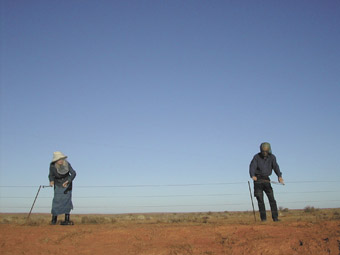
Hollis Taylor & Jon Rose, Twin Lakes, NSW
photo Jon Rose
Hollis Taylor & Jon Rose, Twin Lakes, NSW
AUSTRALIAN VIOLINIST, COMPOSER AND INSTRUMENT MAKER JON ROSE’S PASSION FOR BOWING FENCES GOES BACK TO 1983. BARELY INTO THE ‘LET’S LIVE TOGETHER STAGE’ OF HER RELATIONSHIP WITH ROSE IN 2002, AMERICAN CLASSICAL VIOLINIST, CHAMPION FIDDLER AND COMPOSER HOLLIS TAYLOR FINDS HERSELF CHAUFFERING HER PARTNER ACROSS AUSTRALIA, ATTACHING CONTACT MICROPHONES TO THE WIRES AND POLES OF FENCES THEY WILL PLAY—NEW AND OLD, TAUT AND COLLAPSED, IN LANDSCAPES PUBLIC, PRIVATE AND RESTRICTED, WIND-BLASTED, COOKED AND BEAUTIFUL, IF ALIEN. TAYLOR HAS DOCUMENTED THE EXPERIENCE IN A FASCINATING BOOK.
Rose and Taylor stroke and tap fence wires gently and aggressively. They shorten and extend lengths with spare hands, bending and damping wires to yield a remarkable sonic range. The resulting layers of metallic squeal, mellow hum and strange harmonics sound nonetheless like kin to the sounds the wind draws less extrovertly from these remote fences. The book’s accompanying DVD provides numerous examples of the fences, landscapes and playing with occasional striking images of Rose’s head swathed in gauze (amidst a plague of flies) and Taylor a gothic figure in black against ochred or ghostly, bleached landscapes and battered fences.
The book is a funny, frank, finely written account of an artistic adventure and a personal and intellectual relationship in formation—there’s a liberal supply of Jon Rose’s ideas and observations too. Taylor’s evocations of the Australian landscape as witnessed by an outsider are vivid, so too accounts of the demands on the body, not least the hands. Post Impressions offers the pleasures of a good travel book (rare locations plus the hell that becomes fun in retrospect) and an informative account of the wider reaches of music. RT
Hollis Taylor, Post Impressions: A Travel Book for Tragic Intellectuals, A TwiSted Fiddle Production, 2007, order from www.hollistaylor.com
RealTime issue #82 Dec-Jan 2007 pg. 40
© RealTime ; for permission to reproduce apply to realtime@realtimearts.net
SIAL SOUND STUDIOS, IN COOPERATION WITH THE CITY OF MELBOURNE, STAGED THREE PERFORMANCES OF EXPERIMENTAL MUSIC AS A LUNCHTIME CONCERT SERIES IN THE MELBOURNE CBD. THE FIRST CONCERT WAS HELD IN THE TOWN HALL, BUT THE REMAINING TWO WERE HELD OUTDOORS, BRINGING NEW MUSIC TO A PUBLIC OUTSIDE THE CONCERT HALL. SIAL—SPATIAL INFORMATION ARCHITECTURE LABORATORY, PART OF THE SCHOOL OF ARCHITECTURE AND DESIGN AT RMIT UNIVERSITY—TAKES AN INTERDISCIPLINARY INTEREST IN SPATIAL AWARENESS, SOUND IN THE ENVIRONMENT AND THE INTERRELATIONSHIP BETWEEN SOUND AND ARCHITECTURE.
Concert two was held in Fulham Place, off Flinders Lane, an area densely populated with shopping malls and office blocks. Fulham Place is an urban canyon, about 4m wide, 80m long and four to five storeys high, with gracious neo-classical architecture on one side and a bare concrete wall on the other. Performer Karen Heath’s work Artemis occupied the program, a work paying homage to the Greek goddess whose sacred animal was the deer, and she was suitably attired in antlers, fur and makeup. Playing a miked bass clarinet, Heath steps ritualistically around the space as the work unfolds. The sound is slow, with gentle, simple motifs repeated and blended with pre-recorded voice and percussion, as well as ambient noise picked up by microphones in the laneway. An array of loudspeakers projects the sound into the reflective walls, and live processing by Lawrence Harvey and Jeffrey Hannam creates a complex, layered orchestration. There is a delay of variable length in the rebroadcasting of the live clarinet, creating an artificial echo of shifting dimensions to contrast the acoustic character of the space.
Heath’s performance concludes as the sun reaches its zenith and floods the laneway with light, and she kneels to blow into the clarinet’s microphone, creating the sound of wind. At nearly an hour in length, this is a demanding work for the soloist. Artemis is a delightful composition, and its mythological references, especially in this location, create a sense of longing for an unachievable past in a world of decline.
Concert three was located on the north bank of the Yarra River, outside Flinders Street Railway station. The work was Karlheinz Stockhausen’s Spirale, performed by Michael Fowler, a post-doctoral fellow at SIAL. Spirale, composed in 1968 for short-wave radio receiver and an instrument of the performer’s choice, is an important work in Stockhausen’s oeuvre. The performer must broadcast a moment of sound from the radio, which might not be tuned to any station, imitate it and then use the resulting sound as thematic material to develop variations and elaborations. Fowler used a Doepfer analogue synthesiser and Korg micro synthesiser in conjunction with the radio, and worked from a score that outlines overall parameters but leaves much to the performer. The result — carefully executed hissing and whining signals and staccato beeps and squeaks, of varying pitch, duration, frequency and volume, interspersed with occasional keyboard notes—was highly musical, with a delicate subtlety.
The performance utilised the north bank’s Signal sound system—16 pairs of speakers mounted just above head height at intervals along a 100 metre stretch of the path bordering the river. The use of a 50 millisecond delay between each pair of speakers added to the spaciousness of the sound. In this setting, the listener’s attention is not focused as it is in an auditorium. Rather than reaching us from a fixed point, the sound floats in the air and blends with ambient sound, especially the clatter of suburban trains from the adjacent station. The listener becomes aware of the parallel universe of radio waves and of the electronic communication that permeates our lives, and also of other sound in the space. Such a realisation of the Stockhausen work adds considerably to it through its integration into a space already alive with sound and movement.
Artistic director Lawrence Harvey indicated that the intention of these outdoor lunchtime concerts was to bring experimental music to the city public. Fulham Place was chosen for its acoustics and, being a dead-end, it would normally attract little through traffic, but the north bank of the Yarra is a busy promenade, especially on a workday lunchtime, and numerous passersby heard at least a few moments of Spirale. Importantly, both concerts explore the shifting of spatial awareness and the incorporation of environmental sound into the material—sound both as installation and as a mutable, dynamic element of its environment. As well as bringing new music to the public, locating these events in public space adds significant sonic and conceptual dimensions to the works themselves.
SIAL Sound Studios, Lunchtime Concert Series, Karen Heath, Artemis, Fulham Place, Nov 9; Michael Fowler, Spirale, composer Stockhausen, Yarra River, Melbourne Nov 16
RealTime issue #82 Dec-Jan 2007 pg. 41
© Chris Reid; for permission to reproduce apply to realtime@realtimearts.net
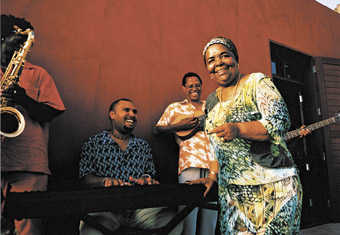
Cesaria Evora
THE LABEL ‘FOLKSINGER’ SOMETIMES APPLIED TO CAPE VERDE’S “BAREFOOT DIVA”, CESARIA EVORA, SEEMS INADEQUATE, PERHAPS BECAUSE THE FORM SHE HAS INHERITED AND DEVELOPED, MORNA (SONGS OF SADNESS WITH LYRICS IN THE AFRICAN-PORTUGUESE CAPE VERDEAN CREOLE), IS A SUBTLE, SOPHISTICATED HYBRID, DRAWING ON ANGOLAN LANDU (LAMENT), PORTUGUESE FADO AND BRAZILIAN MODINHA WITH A TOUCH, POSSIBLY, OF ARGENTINIAN TANGO. EVORA’S DISTINCTIVE SOULFUL LYRICISM AND HER ACUTE SENSE OF PHRASING LEAVE MANY A JAZZ SINGER IN THE SHADE.
Cape Verde is a volcanic archipelago 500km off Senegal in western Africa. Breaking from Portugal it became an independent state in 1975. Evora was born on the island of Sao Vincente in 1941, her father a musician, her uncle a morna composer, but she didn’t become a star until 1988, and thanks then to French patronage.
Morna is most often described as soulful, the songs focusing on separation, homesickness and lost love. They have been composed by many hands, the topics often quite local and frequently idiosyncratic—a wasted salary (“Oh little Theresa/ The money from Angola is gone/ I do not have a penny left/ to spend with you”), the decline of the city of Mindelo, getting drunk (“There were three of us/ Drinking rum punch/ We emerged/ Quite out of control /and walked like/ ‘Crooked’ Mr Antoine”), while others are more broadly romantic, even nostalgic. But the mood is never depressed, rarely dark, certainly often sad and yearning but always with a supple buoyancy that suggests reflection and even stoicism.
The classic lilting morna accompaniment comprises guitar, cavaquinho (a small four-stringed Portuguese guitar), violin, clarinet and accordion, but Evora uses a wide range of instrumentation album to album while maintaining a distinctive morna feel or invigorating the sexy dancerliness of the other Cape Verde musical idiom, coladera. Cesaria Evora is a major figure, much more than a World Music icon. Her appearance at WOMADelaide 2008 should be one to relish and treasure. RT
WOMADelaide, Botanic Park, Adelaide, March 7-9, 2008, www.womadelaide.com.au
RealTime issue #82 Dec-Jan 2007 pg. 41
© Keith Gallasch; for permission to reproduce apply to realtime@realtimearts.net
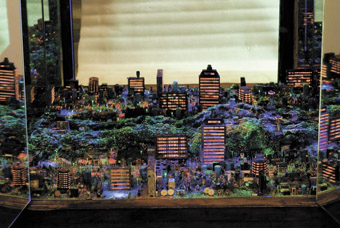
Glance Back, Na Mo
THE SCULPTURED INDUSTRIAL LANDSCAPES CREATED BY KOREAN ARTIST NA MO (KIM NAM OH) WOULD RESONATE ANYWHERE IN THE CONTEMPORARY WORLD, BUT SEEM PARTICULARLY POIGNANT WHEN SEEN IN CHINA’S CAPITAL. YOU DON’T HAVE TO BE IN BEIJING LONG TO FEEL ALL THE WONDERFUL SENSORY, CULTURAL AND SOCIAL STIMULI OF THIS 21ST CENTURY MEGA-METROPOLIS, JUST AS SURELY AS THE CITY MAKES PLAIN THE UGLY CONSEQUENCES OF UNFETTERED URBAN EXPANSION. SIMILARLY, NA MO’S WORK CONVEYS THIS SENSE OF HOPE AND IMPENDING ENVIRONMENTAL DISASTER IN EQUAL MEASURE.
Na Mo first came to China in 1993 to study Chinese ink painting, graduating from Beijing’s Central Academy of Fine Arts in 1999. He returned to Korea to teach for five years, but found himself drawn back to the Chinese capital. “I’m interested in Chinese traditional things, especially Chinese antiques. I wanted to do some research on antiques and find a way to combine modern and traditional things in my art.” This aim has borne fruit in his recent work, evidenced by the Glance Back—Environmental Pollution exhibition recently staged at Omin ART, a small gallery in Beijing’s famous 798 arts district.
Entering the converted factory space of Omin ART, visitors are confronted with two large works hung on the wall like paintings. They are anything but conventional canvases however. The black surface of each is peppered with tiny protrusions, laid out in grids dissected by ‘roads.' Upon closer inspection, the tiny ‘buildings’, ‘silos’ and ‘factories’ forming each block turn out to be circuit boards and assorted electrical parts such as transistors, capacitors and wires. One work features a shiny river of resin dissecting the miniature ‘city’, washing around the buildings like a stream of industrial runoff that’s burst its banks. The other work is marked by a red blotch splashed across the darkened surface, like a bloodstain left by some omnipotent being. It takes a few moments to realise the red patch is in the shape of China.
The next room contains a series of cityscapes also constructed from rusted electrical and computer parts, set in sculpted landscapes made from resin and fibreglass. Some are set into tables, while others reside in traditional looking Chinese cabinets, complete with wooden doors. The largest work, Environmental Pollution, is set into a table over two and half metres long and a metre wide, and depicts a darkened industrial cityscape interspersed with large boulders, surrounded by bubbling volcanoes in the hills. The volcanoes look like fetid pools of industrial outflow, or perhaps primordial forces attempting to burst through humankind’s imagined domination of nature.
The cityscapes set in cabinets are collectively entitled Glance Back, and exude a more ambiguous but less menacing air. The ‘buildings’ in these cities are covered by a furry looking substance in dayglo colours growing across the landscape like psychedelic moss. Fluorescent lights enhance the sense of iridescent splendour, simultaneously suggesting some horrific irradiating disaster that’s washed over the landscape, and nature reclaiming the city.
Superficially, the works in this exhibition bear little relation to the classical landscape painting Na Mo studied at art school, but in the exhibition catalogue, Lily Hope Chumley notes a certain continuity in the artist’s concerns: “Landscape painting has always served both to represent real places and to reimagine them, excising or exaggerating their flaws and charms. In these works, Na Mo on the one hand engages with the ugliness of the modern city and, on the other, strives to develop a visual language with which to describe its beauties.”
Na Mo’s cities in miniature, constructed from the technological detritus of the recent past, signify and critique both the material conditions and philosophical questions of the era in which we live. The eerily depopulated cityscapes have a melancholy air, memorials to the end of the industrial era and its dreams of unlimited production. The only signs of life in Environmental Pollution are the bubbling pools of sludge in the hills surrounding the city and the winking pinpricks of light along each street. Have the inhabitants been annihilated by some unspecified disaster, or has the unrestrained pursuit of industrialised production simply rendered this city uninhabitable? Perhaps the population has moved on, leaving the city as a deserted monument to a dream now abandoned or transcended.
The glowing scenes set inside traditional furniture suggest a more hopeful, sustainable future, in which old and new, people and the environment, exist in more harmonious balance. The buildings here are lit from within, suggesting warmth and an ongoing interior life. The walls of the cabinets in which the landscapes are set are mirrored, reflecting the face of the observer looking down on these scenes as if investing him or her with the power to realize the potential of a more balanced mode of urban existence.
Na Mo says that in creating these works he sought to make art that would speak directly to ordinary people about contemporary concerns. Judging by the obvious fascination of many visitors, both Chinese and non-Chinese, these concerns require little translation for an international audience. We are surrounded by irrefutable evidence of the untold damage we have inflicted on the planet, yet we have at our fingertips productive power and collective wealth unimaginable to earlier generations. The course we take at this crucial juncture will determine whether we harness this power to move to a more balanced way of life, or simply exist in an ever more degraded environment of life-destroying pollutants and industrial fallout. Nowhere does this choice seem starker than in the People’s Republic.
At the centre of Na Mo’s exhibition is a final work, quite different from the surrounding landscapes. It depicts a human shape completely encased in circuit boards, covered with tiny lights and lying on a bed of fine black dust. Twentieth century man laid to rest, or 21st century man ready to emerge from the dust of the industrial era? Na Mo’s art embodies some of the fundamental questions of the 21st century, suspended as we are between the death of one era and the boundless potential of another.
Glance Back—Environmental Pollution, artist Na Mo, Omin ART, 798 Art Zone, Beijing, October 1-19
Many thanks to Wang Yi for her assistance in translating the writer’s interview with the artist.
RealTime issue #82 Dec-Jan 2007 pg. 42
© Dan Edwards; for permission to reproduce apply to realtime@realtimearts.net

Ballad(s) for Quiet Horizons, video still, Scott Morrison
WITH A LITTLE PERSEVERANCE AND THE RIGHT STATE OF MIND, SCOTT MORRISON’S BALLAD(S) FOR QUIET HORIZONS IS A REWARDING EXHIBITION, OFFERING A UNIQUE SPACE FOR INNER REFLECTION. LIKE STARTING POINTS FOR MEDITATION, THE THREE VIDEO INSTALLATIONS IN CCAS MAIN SPACE USE THE FAMILIAR IMAGERY OF GRASS, CLOUDS AND LEAVES TO SPARK A PERSONAL AND EMOTIONAL RESPONSE. TRIGGERING MEMORIES AND AWARENESS OF CURRENT THOUGHTS, BALLAD(S)… IS SOMEWHAT OF A ‘MAKE YOUR OWN EXPERIENCE’, DEPENDENT ON THE DESIRE AND CAPACITY TO STUDY THE WORKINGS OF YOUR MIND.
Transforming the open gallery space into a dark haven, Morrison mesmerises his viewer, the senses adjusting to the rhythmic light and sound, eyes drawn to four monitors sitting in a pile of dirt and wood chips. In this first installation, Les echos de l’ocean, a large wall projection of a 12-second shot of grass has been edited and processed so that the stems become mere lines and shapes, flickering rhythmically. This clean-cut imagery contrasts with the bed of earth and wood, its smell and texture alerting us to the physicality of the installation; as if under hypnosis, we are aware of Morrison’s spell but are unable to stop ourselves succumbing.
Morrison reinforces this repetitive imagery with a complex layering of sound. A musical score, derived from the original audio, complements the motion of the blades of grass and is layered over the sound of wind. In the background, the music of the other two projections floats in and out of my consciousness. Turning away from Les echos de l’ocean, I almost fall over a large monitor which reflects the large grass projection. On another in the the back corner of the room, the image of a blue, cloud-swept sky builds a horizon for the endless field of grass. The constant interplay of sound and image means that Ballad(s) for Quiet Horizons simultaneously comprises one whole and three discrete ballads, immersing the viewer in a harmony of sight and sound.
By providing headphones for two of the three installations Morrison allows for more intimate ruminations over each of the works. For A push and a shove but we fell out of this together, the audience is invited to don earphones, blocking out the sounds of the other two installations. Suddenly, the blurry imagery projected on the adjacent wall becomes clearer. Slowly, the layered music and rhythmic overlaying of leaves—glowing in the darkened space—engulfs the senses. The burning desire to make sense of the exhibition dissipates. Within the bubble of the headphones, I am content to sit, gradually becoming aware of a jumble of racing thoughts.
In Drift, the ambient sound arrangement of the previous two works becomes background to Adrian Klumpes’s more structured musical score. Memories of afternoons spent lying on my back, finding shapes in the clouds above, come flooding in as I watch Morrison’s peaceful projection of sky. Compared with the flickering speed of its companion works, Drift imbues a feeling of serenity.
Ballads for Quiet Horizons highlights how the layering and intertwining of images and sounds shapes responses, forming textured personal journeys, but without beginnings, middles and endings, journeys as rich as everything we bring to the work and how far we let ourselves surrender to it.
Scott Morrison, Ballad(s) for Quiet Horizons, Canberra Contemporary Art Space, Oct 12–Nov 24
RealTime issue #82 Dec-Jan 2007 pg. 43
© Cheree Mack; for permission to reproduce apply to realtime@realtimearts.net
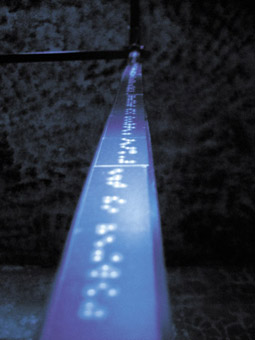
:the braille box:, Jessica Tyrrell
CANTERBURY ROAD ALWAYS SEEMS TO BE HOT, NOISY AND BRIGHT—THAT WHITE, RELENTLESS LIGHT OF A SYDNEY SUBURBAN SUMMER. BUT SLIPPING THROUGH THE MAKESHIFT BLACK CURTAINS INTO THE FRONT ALCOVE OF THE DON’T LOOK NOW GALLERY, THE SHIFT INTO THE DARK IS MORE THAN JUST THE ABSENCE OF LIGHT REQUIRED FOR VIDEO PRESENTATION—IT’S THE REALM OF THE WORK ITSELF.
In the middle of the almost claustrophobic front space is a smaller metal skeleton of a room. Connecting the four planes of the scaffold is a thin shelf on which strips of braille are pasted, dimly lit, inviting you to touch. As I run my fingers along the bumps, a voice emerges abruptly from behind me out of the darkness, and a snippet of video appears projected on the low ceiling, directly above the cube. I react, remove my fingers and the action stops. Soon I learn to play the box: closer to the corners is louder and more intense, moving towards the centre vision and sound begin to fade, eventually shifting into another voice at the far end.
Jessica Tyrrell has drawn the content for :the braille box: from interviews with people (curiously, mainly men), discussing what it is to be blind, how they lost their sight, the progression of their blindness and their reactions, both psychological and physical. The video sequences use grey/blue hues and show the interviewees’ faces, partially obscured by shadow, overlaid with light patterns and textures. Like the sound, these visions respond with varying levels of clarity and intensity to the actions of fingers on the braille.
The interviews in themselves are totally absorbing as the subjects speak in strikingly honest yet quite detached tones about their experiences. One man who has become blind in mid-career, talks of the sensation of his life peeling away, all sense of identity based on what he ‘did’ stripped from him, forcing him to reconstruct himself as the person he actually ‘is.’ A woman wonders whether blind people feel more intensely, not just through heightened senses, but emotionally. A calm acceptance and wisdom comes across in these conversations that makes me feel an honoured witness.
In some ways :the braille box: could stand as a purely interactive audio installation, as the voices are fluidly manipulated and augmented with subtle under-rumbles and reverbs and are interestingly spatialised. However the use of the video emphasises the feeling of disorientation and loss. The constant shifting and obscuring of the image serves to construct a visual parallel for the sensation of blindness—an intriguing contradiction for a seeing audience.
Jessica Tyrrell has been very canny in her design of the interactive interface. The cause and effect is quickly discernible, but you need to constantly run your fingers across the braille to keep the content playing. While the installation may initially appear to be touch sensitive, further play reveals the use of video tracking registering the movement of the fingers to control the audiovisual material. Using distance from the camera as a key parameter the results are slightly unpredictable providing just enough frustration to keep you exploring and seeking more of the content, which is at once educational without being didactic, and moving without lapsing into sentimentality. So engrossing was the experience that when I stumbled back out into the shockingly sunny street not only the tips of my fingers were tingling.
Jessica Tyrrell, :the braille box:, Don’t Look Now Gallery, Sydney, Nov 8-17
RealTime issue #82 Dec-Jan 2007 pg. 43
© Gail Priest; for permission to reproduce apply to realtime@realtimearts.net
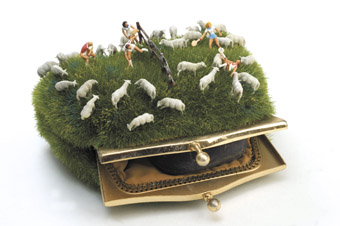
Kendal Murray, Game, Aim, Blame, Proclaim
courtesy of the artist
Kendal Murray, Game, Aim, Blame, Proclaim
THE FRENCH ROMANTIC POET OF THE 1870s, ISIDORE DUCASSE, AKA THE COMTE DE LAUTRÉAMONT, HIT ON AN IMAGE OF BEAUTY THAT WOULD LATER BE CHAMPIONED BY ANDRÉ BRETON AND HIS COLLEAGUES AS AN EPIGRAM FOR SURREALISM: THE RANDOM ENCOUNTER OF AN UMBRELLA AND A SEWING MACHINE ON A DISSECTING TABLE. ACCORDING TO BRETON ET AL, THE PROPHETIC DUCASSE HAD NAILED THE SURREALIST SHTICK 50 YEARS AHEAD OF TIME. IN MAX ERNST’S LOOSE PARAPHRASE OF THE SELF-STYLED COUNT, IT’S ALL ABOUT THE COUPLING OF INCOMPATIBLE REALITIES IN AN INAPPROPRIATE PLACE.
Such random encounters and oddball couplings abound in Kendal Murray’s exquisite An Enchanted Life, with its insistently surrealistic undertow. Here, the dissecting table is a vintage facepowder compact, purse, or teapot, diminutive proscenia in which everyday objects and tiny, naturalistic plastic figures collide in complicated dramas of startling illogic. Not for her the pop-kitsch of the melting clock school of surrealism. Murray’s are the whip-smart inversions of causality and torsions of logic of, say, Meret Oppenheim’s alarming fur cup-and-saucer set (Breakfast in fur), or Magritte’s La reproduction interdit, the low-key nightmare in which an anonymous everyman fronts up to a mirror which reflects only the back of his own head.
As did the surrealists’ work, Murray’s Enchanted Life inhabits the terrain of fantasy, dream and the unconscious as it irrupts into conscious life. Many of the 36 sculptures that make up the show mine the rich lode of metaphor and metonymy that, in psychoanalysis, characterises dreamwork, some leavened by offbeat humour. Motifs include water, the sylvan glades of nature, and the deepseated thrum of anxiety played out in the archetypal dreams of falling from heights or appearing unclothed in public. Murray’s scenarios feature objects of perceptual framing or of transition from interior to exterior space—windows, ladders. And in the pieces using vintage powder compacts, the mirrored backdrop is omnipresent, multiplying the hermetic mise en scene of the miniature, a trope of the unconscious, as the outside is likewise reflected in.
In Advance, Romance, Perchance, a man and woman sit with their backs to each other on opposite sides of a bed, his arms folded defiantly. A tall tree with lush foliage sprouts between them from the marital mattress—a rebus, perhaps, for existential disconnection and loss, potently metaphorising what it is to grow apart. In Implore, Ignore, Done For, a relationship is frozen in moment of chaotic meltdown worthy of a feverish Albee. A woman stands with arms akimbo precariously teetering on a towering jumble of chairs, a cleaner in the corner sweeping up the scattered debris surrounding her. The female protagonist looks expectantly to a man with his back to her, standing on a table, leaning out of a window. His escape, if that’s what it is, is thwarted by the mirror/wall that occludes the window and visually loops him back into the chaos, enmeshing him in the domestic maelstrom. In another riff on coupledom, oblivious young lovers embrace on top of a parked car overrun by a luxuriant blanket of grass, as time, for them, telescopes into one crowded hour.
Elsewhere, a high diver launches headfirst into a backward swandive off a precipitously high ladder into a half-filled bathtub. Simultaneously, in what seems to be another temporal dislocation—a flash-forward to the unpretty ending?—cleaning women scrub the tiled bathroom floor. In another watery scene, two boatmen in a tiny craft battle the roiling, treacherous seas of a storm in a compact. A neat play complicates the dream/wakefulness, inside/outside divide: one flings the boat’s wildly outsized anchor right over the compact’s gilded edge, shattering the fourth wall.
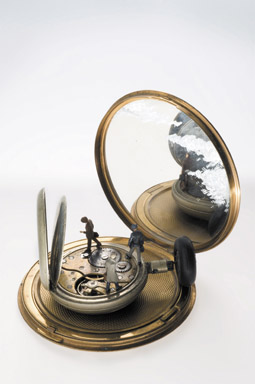
Kendal Murray, Chase, Replace, Erase
courtesy of the artist
Kendal Murray, Chase, Replace, Erase
Murray’s Lilliputian tableaux are no less compelling for being short on the vivant. A signature of the show is the surprisingly full sense of subjectivity that animates the inert plastic toys in Murray’s itty-bitty theatre of the absurd. These figures, and the vignettes which they play out, possess the slightly perplexing capacity to touch the viewer, eliciting emotional and psychological investment in the characters’ backstories. It’s oddly hard not to care about the psychodramas of these two-cent toys, or involuntarily project into the scenes the freight of a lifetime of psychic flotsam, improvising mini-narratives for them shot-through with the pulse of personal memory, anxieties and desire.
Some works are not so enigmatic, but still powerful and curiously moving. In Chase, Replace, Erase, three drab-suited briefcase-carrying workers endlessly walk the circumference of a splayed-open gold fobwatch, damned to the Sisyphean grind and anonymity of the salaryman. In Distance, Resistance, Existence, down at heel eastern-European émigrés lugging shabby suitcases stand mesmerised by a shopping trolley set on a verdant circle of grass. They’re cut off from the steely grail by a ring of rubble and rocks. The work here has a cast of political theatre, with its poignant take on the diaspora and swipe at the all-consuming commodity fetishism that shorthands late global capitalism.
Murray’s achievement is enduring in several ways. There’s the sheer beauty of her miniatures and the prodigious dexterity of their construction. Then there’s her creation of multiple parallel universes, each layered over with allusion, and each peopled by human-shaped bits of plastic imbued with unexpectedly complex interior life. Most striking is her adroitness of touch in inflecting everyday scenarios with the sudden, disorienting punch of dreamscape and hallucination, exploiting in the most evocative way the convulsive juxtapositions of the surreal.
Kendal Murray, An Enchanted Life, Arthouse Gallery, Sydney, Sept 16-Nov 13
RealTime issue #82 Dec-Jan 2007 pg.
© Annemarie Jonson; for permission to reproduce apply to realtime@realtimearts.net
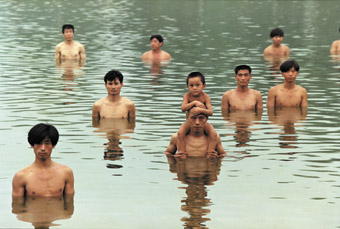
To Raise the Level of Water in a Fishpond (1997), Zhang Huan
ROBERT LEONARD CURATED GREY WATER, AS PART OF BRISBANE’S RIVER FESTIVAL, IN RESPONSE TO THE CURRENT ANXIETIES ABOUT WATER AND IMMIGRATION—ANXIETIES ABOUT “PURITY”, AS HE PUTS IT IN THE CATALOGUE. JUST INSIDE THE DOOR, HIGH IN A LITTLE ROOM OF THEIR OWN AND SPEWING FORTH SOAP BUBBLES LIKE A CHILDHOOD PARTY DREAM, ARE TERESA MARGOLLES’ BUBBLE MACHINES, LOADED WITH THE SOAPY WATER USED TO WASH DOWN CORPSES IN MEXICO (HOW DID THAT GET PAST QUARANTINE?). TO ENTER THE ROOM IS TO BREATHE IN TINY LITTLE BITS OF THE DEAD, MOLECULES FROM THE SKIN, WATERY HOMEOPATHIC VIBRATIONS. IT’S HARD NOT TO HOLD ONE’S BREATH, BREATHE SHALLOW, INVOKE THE FIVE-SECOND RULE OF FOOD DROPPED TO THE GROUND AND GET OUT QUICK. DEATH IS THE GREAT POLLUTER, SOMEONE ELSE’S PROBLEM, SOMETHING TO QUIETLY DO LATER. MARGOLLES BRINGS DEATH HOME, OUT OF DENIAL AND INTO THE MIDST.
Down the hall and in a largish room are Marian Drew’s longitudinal photograms of water, made by direct exposure of submerged photographic paper. The effect is microscopic, clinical and forensic. Slowly sinking to the bottom of the clearest lake and looking up in one last frozen moment at leaves, moths, tadpoles, the sprayed droplets from a hose, ripples running like a creek.
To the back a Peter Greenaway video is running, bodies being dragged from the Seine, the sound up a bit too loud and dominating the room. At different spots in the room, the artist not wanting them displayed together, are photos of the surface of the Thames by Roni Horn. The photos are arranged with image above and footnotes below—definitions, asides, stray thoughts about water and the Thames. The river’s motion is frozen, its surface brought close, where it glistens like the skin of an ancient traveler, tanned and leaden from centuries in an Irish bog.
Also in this room are two portraits by Roland Fischer. In each an individual woman stands in water to the shoulders so that she becomes like a marble bust—like one of the thousands that litter European museums as remnants of ‘Rome’ and ‘Greece.’ At first I thought the two portraits were of the same person but they are not—they just share the same even makeup, impassive gaze and icy, no-fucking-I’m-glamorous stare. Shot in LA, they seem immersed in the cool green waters of commodification.
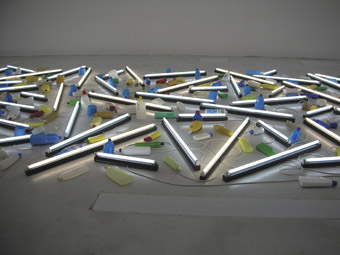
Flotsam, Bill Culbert, 1992/2007
Courtesy Sue Crockford Gallery, Auckland
Flotsam, Bill Culbert, 1992/2007
Next door is the hit-you-in-the-eye show stopper—Bill Culbert’s Flotsam. Lying on the floor, scattered amongst a few dozen fluorescent tubes, are beautifully cleaned de-identified plastic bottles—detergent bottles, home cleansers, bottles that once came with safety instructions—all plopped on the floor in some sort of display of equivalence—rubbish as a condition of equity. Some of the bottles are cut to make them appear to sink into the floor, but most are not—it’s a sort of nod to illusion. The fluoros glint, the white electrical cords curl like ripples on the cement floor of the gallery. Although Culbert is a tad older, I am reminded of work by Tony Cragg, David Mach and Bill Woodrow—art in the transformation of detritus.
There are a couple of rooms set aside for video works. Zhang Huan is one of the big successes of the Chinese art scene and has a short video documenting a 1997 performance from Beijing where he recruited various migrant labourers “to raise the water level in a fish pond.” It’s a rural idyll of a pond in the same way that a feedlot is a bucolic grassland. The men gather around the pond stripped down to underpants which look as if they were designed by an unsympathetic committee in a time of great sadness. Embarrassed grins all round. Nearby, people drive tractors, buy fruit and generally carry on regardless. The men disperse themselves around the perimeter of the fish pond and look at it for a bit. They walk into the water, form a line, then move about until positioned in a sort of random clump. The artist gets in, a bit gingerly. He’s carrying a boy on his head. He starts walking and doesn’t stop until he gets out at the other end and…that’s it. It’s a ritual without substrate, perfunctory and functional, the boy now initiated into the adult world of disengaged labour.
The other video is Memorial Project Minamata: Neither Either nor Neither—A Love Story by Jun Nguyen-Hatsushiba. Starts off with footage of Minamata, the fishing village in Japan where thousands of people contracted methyl mercury poisoning through industrial pollution. Kids laugh and play. There is a truly awful sentimental soundtrack that is both comforting and disquieting. Orange dye blooms in water, referencing mercury orange, a stain that shows where mercury goes in biological tissues—showing the parts mercury takes out.
Cut from the village to underwater, murky, a small group of divers. Bathers, no goggles. The divers are contained within a large dome-like plastic frame which, unaccountably, they try to manoeuvre along the ocean floor. The divers don’t carry their own air, their own life support. That’s supplied by attendants in full scuba gear. This is a high maintenance struggle.
Now cut from underwater to people dancing, bad disco music, shots of their feet, taken low. Anonymous glimpses of someone lying still on a bed. A fan turns. A mosquito net hangs like a hospital curtain. In the languid reverie of their illness perhaps they dream of the water, their breath slow and murky, now underwater, weightless, free, threatened with suffocation.
Grey Water, curator Robert Leonard, artists Bill Culbert (Britain), Marian Drew (Australia), Lawrence English (Australia) and Toshiya Tsunoda (Japan), Roland Fischer (Germany), Peter Greenaway (Britain), Roni Horn (USA), Zhang Huan (China), Abie Jangala (Australia), Rosemary Laing (Australia) with Stephen Birch (Australia), Teresa Margolles (Mexico), Jun Nguyen-Hatsushiba (Vietnam) and Lawrence Weiner (USA); Brisbane River Festival; Institute of Modern Art, Aug 4-Oct 6
RealTime issue #82 Dec-Jan 2007 pg. 46
© Greg Hooper; for permission to reproduce apply to realtime@realtimearts.net
AERIALIZE, SYDNEY'S CIRCUS ARTS TRAINING CENTRE, CERTAINLY KNOWS HOW TO PUT ON A SHOW, A BIG ONE THAT TRUMPETS THE TALENTS OF ITS MULTITUDINOUS STUDENTS, PLAYING TO PROUD PARENTS AND FRIENDS AND THE EAGER GENERAL PUBLIC THAT PACKED THE ADDISON ROAD COMMUNITY CENTRE GREAT HALL FOR THE THREE PERFORMANCES OF OFF THE RAILS.
While a huge forestage accommodated a host of artists of trapeze, tissu, hoop, web, stilts, acrobatics, juggling, mime, song and much more, a towering proscenium set reproduced a railway station mutating from its Victorian origins and British India to the Orient Express and on to the present Sydney Rail timetable delays, the fear of unattended bags and, above all, rail crashes.
All of this was accompanied by a gaggle of historically asynchronous recorded pop songs that one way or another suggested trains. But no matter in a show as happily impressionistic as this in which every beat and image is an opportunity to release the body from the thrall of gravity.
Tiny children filled the stage en masse, hoisting themselves unselfconsciously aloft with rough agility while older students and practiced professionals displayed poise and took risks. Among the standouts were Scott Walker and Tanya Richards in duo tissu in the Melodrama Station scene and, in British India Markets, Megan Bolton on handstand bars, Heidi Holmes and Elli Huber on tissu and again, on spanish web, Richards and Walker.
It was fascinating to watch a show that time-travelled the history of railway travel to reveal that its pleasures and anxieties haven't changed a lot, and nor have the ancient circus arts lovingly preserved and passed on here.
Aerialize, Off the Rails, producer, director Sha McGovern, co-directors Bel Macedone, Leanne Kelly, script Rebecca Conroy, lighting Dave Ferguson, set design James Browne, The Great Hall, Addison Rd, Marrickville, Sydney, Sept 21-23, www.aerialize.com.au
RealTime issue #82 Dec-Jan 2007 pg. online
© Keith Gallasch; for permission to reproduce apply to realtime@realtimearts.net
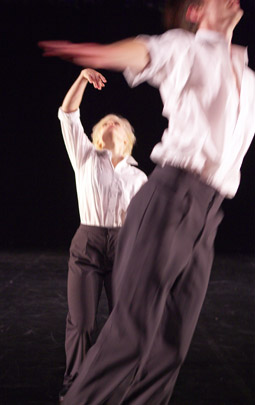
Link Dance Company, The Fugue
photo Jon Green
Link Dance Company, The Fugue
THE US HAS A LOVE-HATE RELATIONSHIP WITH TWYLA THARP. IN MANY WAYS QUINTESSENTIALLY AMERICAN, THARP’S CHOREOGRAPHY IS BRASH, ATHLETIC AND YOUTHFUL, AN EXPLOSION OF WIT AND SHOWY ACTIVITY, WHILE HER DRAMATIC CONTENT HAS COVERED 1960s COUNTERCULTURE (HAIR), THE VIETNAM WAR (HER BILLY JOEL MUSICAL, MOVIN’ OUT) AND THE NATION’S RUSTIC RELIGIOUS BASE (THE SHAKER-INSPIRED SWEET FIELDS). NOW 66, THARP IS MAKING CONCERTED EFFORTS TO SECURE HER LEGACY.
2003 saw the publication of Tharp’s second monograph, while the first critical biography on the artist appeared in 2006. Tharp has even secured her presence on the somewhat nauseating website, the Academy of Achievement.
This rush of activity was accompanied in 2006 by the spectacular flop of Tharp’s dance-theatre-musical The Times They Are A Changin’, a mawkish setting of Bob Dylan’s lyrics to a circus narrative. Critics hated it so much they gave up all pretence of even-handedness and openly mocked it. It is this oscillation in quality not only Tharp’s work, but more particularly her critical standing, which led one New York Times reviewer to remark that if Tharp “were an automobile, she’d be a 1960s Jaguar: fast, stylish, high profile…and unreliable.”
Despite such setbacks, Tharp wishes to situate herself alongside such key figures in US dance as Martha Graham, Hanya Holm and Ruth St Denis. Tharp has long called for a “cross-over” dancer who “could genuinely work as comfortably on the so-called modern techniques as on the classical technique.” And she more recently suggested that her own works could act as “scores and pedagogical material” akin to those developed by classical music “composers to produce better musicians.”
With this in mind, in 2003 Tharp began to licence her works to teaching institutions. Since 2005, more than eight US colleges have staged Tharp’s pieces, including Sarah Lawrence College, where Tharp’s early collaborator Sarah Rudner works.
Tharp has influenced Australian dance. Lucy Guerin began working in Rudner’s company, while the influential Russell Dumas has worked with both Tharp and Rudner. The Australian Ballet staged Tharp’s popular athletic ballet of 1986, In The Upper Room, several times, its brash combination of energised pedestrian movement (running and jogging) with ballet and the pulsing music of Phillip Glass continued to draw audiences. Interestingly though, the first of Tharp’s early works to be staged in Australia as part of this repositioning are Torelli and The Fugue, performed by the West Australian Academy of Performing Arts’ Link Dance Company.
Fugue is a key piece in the canon, originally danced by Tharp, Rudner and Rose Marie Wright. Although austere in presentation, lacking any music beyond the tap-derived stamps of the trio and the silent rhythmic counterpoints of the dance itself, Fugue meshes easily with classicism. It is precise and mathematical, demanding every pose be done just so, and although it has a touch of postmodern pedestrianism in that none of the actual physical phrases or gestures are in themselves all that difficult (arms held horizontal as the body drops into bent legs, slowly, like a perching bird; crossing of the feet to mark out triangles and lines on the floor etc), the speed of the transitions and the intricate ebb and flow of the timing makes for virtuosic performance. Indeed, Fugue has been in the repertoire of the American Ballet Theatre since 1988.
Torelli however is more difficult to fit into any tradition, not least as it has no formal precedent as such. Never performed quite the way Tharp envisaged it, Torelli was to be danced on a barge around Manhattan Island. It ended up being staged only once, in 1971, as an environmental, installed work, performed in a park during sunset, with Tharp et al dressed in everyday winter clothing. The 2005 Marymount College production evoked this unbounded ambience by seating spectators on stage, but the Link Dance Company production was poorly served by the oppressive concrete proscenium arch of WAAPA’s theatre.
The process of reinventing Torelli runs the risk of over-formalising it, of turning it into something closer to Tharp’s later works for Broadway than her earlier productions staged in the last years of the Judson Church movement and postmodernism’s arrival on the US dance scene. After executing a set of pedestrian phrases of arm swings, shoulder shakes and so on, the performers begin to improvise on this material, a deep, slow drop into the floor as the legs spread apart being a notable gesture used to not only pace and segment material, but also as an amusing response to fellow dancers.
While the discipline—or more accurately, the deliberate ill-discipline—of learning such a work is pedagogically useful, the piece offers less for audiences. Its theatrical staging does not attain the sense of countercultural fun and radicalism which it once had, coming across as a historical curio. Fugue by contrast offers much in its temporal delights, while the various gender combinations which today’s companies like Link are playing with present many opportunities for lightly enunciated sass and sex. The current costuming—the slacks, black shoes and open-necked white shirt of a classic Broadway hoofer—gives a touch of transvestite subversion. This was particularly true with one of the Link female dancers’ platinum blonde bob evoking that ambiguous goddess herself, Marlene Dietrich. Fugue is brimming with a sexy, presentational “look-at-me!” execution, while the more introspective Torelli does not directly address the audience, and once taken from the park to the stage, this is problematic.
As far as America is concerned, the jury is still out on where to place Tharp. The choreographer’s transition from postmodern rebel to an almost neo-classical populist makes one wary of quite what effects the institutionalisation of her style might have for the opening out or closing off of physical plasticity today. Tharp has even less in common with deliberately formless and resolutely anti-classical approaches like butoh or Body Weather than Merce Cunningham. Nevertheless, Tharp remains a commanding presence in dance, here as well as in the US, and further opportunities to revisit her work, such as provided by Link, are to be welcomed.
Link Dance Company, artistic director Michael Whaites; Torelli (1971), choreographer Twyla Tharp, new costuming Emily Frederickson, lighting Jayne Ottens, performers Helen Duncan, Russell Leonard, Jade Dibblee, Rhiannon Newton, Laura Boynes, Elanor Webber; The Fugue (1968-71), choreographer Twyla Tharp, lighting from design by Charlie Hodges, costume recreation Santo Loquasto, performers Sophie Burgoyne, Luke Hickmott, Chimene Steele-Prior; Western Australian Academy of Performing Arts, Edith Cowan University, Perth, Nov 1-3
RealTime issue #82 Dec-Jan 2007 pg. online
© Jonathan Marshall; for permission to reproduce apply to realtime@realtimearts.net
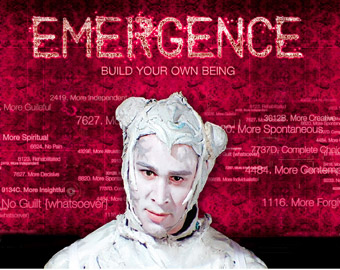
Synarcade Audio-Visuals, Emergence
THE PROCESS OF LABOUR IS LONG, AND SO IT IS THAT EMERGENCE (PRODUCED BY SYDNEY'S SYNARCADE AUDIO-VISUALS) BEGINS NOT AT THE NORTH MELBOURNE TOWN HALL BUT ON THE INTERNET AT MY HOME IN RICHMOND. LOGGING ON TO WWW.BULDYOUROWNBEING.COM I’M ASKED WHICH PERSONALITY TRAIT I WOULD LIKE TO INSTILL IN MY YET TO BE CONCEIVED OFFSPRING.
Later that night, when the performance proper is about to begin, I’m standing in a hi-tech operating theatre surrounded by four screens and a sound system emitting a mesothelial rasp and throbbing gristle. I see the personality trait I chose earlier imprinted on one of the screens: “Walk the Talk Between Eros and Thanatos” says more about me than my bouncing bubba. Having endowed my child with such a precarious awareness I’m reminded of an obsessive father at an Under 9’s football match. Oh the joys of parenting. Thank god I can disavow any responsibility in that area.
Back inside the operating theatre, I’m wearing a fluorescent green halo and feeling like a cross between Astro Boy and Victor Frankenstein. Luckily, 30 other patrons have their heads adorned in the same luminous loop. Above and to my right, a cocoon shaped head projected upon an oval screen implores me not to remove my halo, as it is part of a universal tracking system. Our offspring, appropriately named RAM, will be shaped by our wants, needs, passions and eccentricities. We will vote for characteristics such as ‘Cooperative’ and ‘More Individualistic.' Our responses will be monitored via our halos, fed into the universal tracking system, then recorded percentage-wise and used to shape the personality of RAM.
We skip from screen to screen, voting with our feet. There is some tantrum throwing among the audience as each tries to persuade the ‘Swinging Voter’ that RAM should become ‘Completely Honest’ or “More Critical.' One woman claims there resides amongst us a phallocentric tendril of conspiratorial males hellbent on control of RAM’S development. She’s probably right, for RAM is regressing into childish episodes of chest beating and thumb sucking by the minute. Swept by moments of cheap sentimentality, our monstrous metrosexual has become a being in need of quiet resolution. So, after a second governmental intervention, RAM, as we have created him, is simply discontinued, replaced by a feminised version named Zye who slides down a birth canal and pops out a slit hidden in a screen. Standing on a plinth before us, Zye wants us to help set her free. Beset by the mindless principle of consumer class Individualism, we offer her all the assistance she needs. Some members of the audience even prompt Zye to ‘Find her own path’ and ‘Discover who she really is.' The perils of parenting, it would seem, are irresistible.
Synarcade's Emergence is a sly take on the very human desire to control the lives of others, without realising that the monster residing within has been unleashed and our ‘Inner Tyrant’ set free.
Synarcade Audio-Visuals, Emergence: Build Your Own Being, writer, director Mark Bolotin, performers Nick Currow, Lindsay Farris, Anna-lea Russo, Nicole da Silva, Gary Boulter, Richard Cartwright, multi media production Synarcadia; Arts House, North Melbourne Town Hall, Sep18 – 23; www.buildyourownbeing.com
RealTime issue #82 Dec-Jan 2007 pg. online
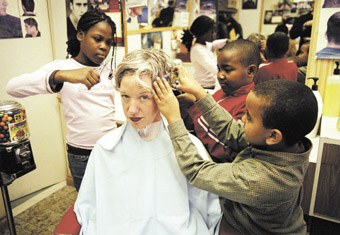
Haircuts by Children
The RealTime Editors and a team of six Canadian writers from the RealTime-PuSh
review-writing workshop will be posting reviews of the festival as it unfolds at
www.realtimearts.net/features
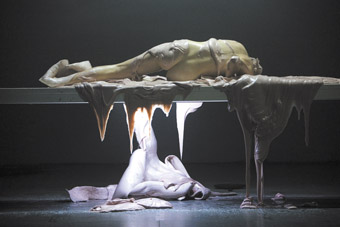
Hey Girl!
Read about these shows & more
Romeo Castelluci [Italy]: Hey Girl!
Boca del Lupo [Vancouver]: My Dad, My Dog
Nigel Charnock [UK] : Fever, Shakespeare sonnets in voice, dance & music
Mammalian Diving Reflex [Toronto]: Haircuts by Children
Catalyst [Edmonton]: Frankenstein
November Theatre [Edmonton-Vancouver]: The Black Rider by Waits, Wilson & Burroughs
Electric Company [Vancouver]: Jonathan Young in Palace Grand
newworld theatre [Vancouver] & Teesri Duniya Theatre [Montreal]: My Name is Rachel Corrie
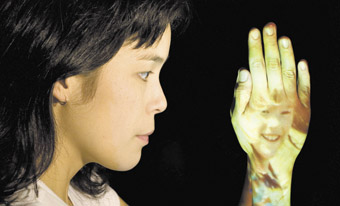
My Name Is Rachel Corrie
and from Australia
CIRCA: The Space Between and 46 Circus Acts in 45 Minutes
Back to Back Theatre: Small Metal Objects
Chunky Move: GLOW
www.pushfestival.ca
RealTime’s participation in PuSh 2007 has been made possible by the Canada Council and the Australia Council for the Arts.
RealTime issue #82 Dec-Jan 2007 pg.
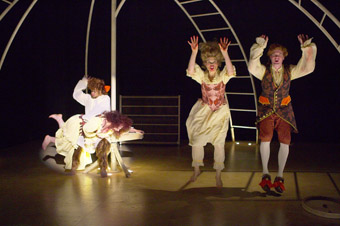
Memmie Le Blanc Deckchair & Vitalstatistix
photo Jon Green
Memmie Le Blanc Deckchair & Vitalstatistix
THE WILD CHILD RAISED IN NATURE WAS A PARTICULARLY ENLIGHTENMENT FIGURE, SEEN AS A LIVING EXEMPLAR OF ‘NATURAL MAN’ UNGOVERNED BY REASON, AND DEBATED BY HOBBES (WHO SAW SUCH ESSENTIALLY SELFISH BEINGS LIVING A LIFE “NASTY, BRUTAL AND SHORT”) AND ROUSSEAU (WHOSE “NOBLE SAVAGE” REPRESENTED A PRELAPSARIAN IDEAL WHICH MANKIND HAD LOST THROUGH THE OPPRESSIVE ACCRETIONS OF FEUDAL SOCIABILITY). ONE FAMOUS WILD CHILD WAS MEMMIE LEBLANC, A GIRL CAUGHT IN THE WOODS OF CHAMPAGNE IN 1731, AGED 10. MEMMIE IS THE SUBJECT OF HILARY BELL’S LATEST PLAY.
Directed for Adelaide’s Vitalstatistix and Perth’s Deckchair Theatre by Angela Chaplin, Memmie Le Blanc is a strong, subtle four-hander which riffs on the girl’s teens, when she was passed from the local Marquis to the (fictional) Duchess Catherine Michel (Netta Yaschin). The production benefits from a wonderful design by Andrew Lake, evoking both the sparseness of Bell’s straightforward narrative treatment while also hinting at the rich excesses of Rococco lifestyle.
On the simple, cream coloured stage floor is a domed climbing frame on which the prime actions are performed, while two holes bounded by jute on the floor act as perforations through which stage elements such as candles, soil and mice appear and descend. Isaac Lummis’ costumes are a particular treat, dresses bulging out in an echo of the frame above them, and each waistcoat, skirt and jacket decorated with ochred orangutans.
Memmie (Anni Lindner) initially appears in a simple white shift, but is entranced by the Duchesses’ coiffure and stitched clothing. An early sign of Memmie’s apparent socialisation is when Yaschin forcefully straps Lindner into new corsetry, each pull of the bindings signifying the social strictures which 18th century theorists recognised as the necessary cost of the ‘social contract’ which prevented men and women from murdering each other. The audience is encouraged to ask itself if the orangutans (an ape attracting much interest in Europe at the time for its supposed facility at imitating humans) sewn onto these dresses really lay outside or within the characters. With the arrival of Dr Legendre (Adam McGurk) and his orangutan companion, Robert (Sete Tele), the question became moot.
Bell based her portrayal on Michael Newton’s Savage Girls And Wild Boys (2002), an erudite but popular account of feral children which historian James Steintrager notes lies uneasily between a “trade book and a work of scholarship” (Eighteenth Century Studies, 38.4, 2005). Although Newton and the play give due attention to historical context, both slip into an ahistorical interpretation of the Wild Child as a universal symbol of the impenetrable depths of human emotion. In the end, Bell and Chaplin are not principally interested in the implications which this attempt to civilise a subject like Memmie—who was explicitly identified as someone of low class—might have for the founding of modern colonialism, racism, capitalism and patriarchy. Robert the orangutan is after all a prize of empire, and played by the only black actor in the cast.
These concerns are not however absent and are played out in a wonderfully creative, abstract fashion as a series of near ‘blackface’ song’n’dance routines accompanying 1920s exoticist and primitivist popular song like “Get Cannibal” and “The Princess Of Poo-Poo-Ly”, during which a deeply ironic but still apelike Robert spanks a delighted Duchess. The spectres of dangerously unleashed, primitive sexual appetites, of empire and of Britain’s Enlightenment hero Captain Cook, seem implied if not named in these actions.
In the end though, Bell and Chaplin are chiefly concerned to reject Hobbes’ construction of humanity. The critical sign of Memmie’s socialisation is that she loves the Duchess. Some of Le Blanc’s contemporaries like Louis Racine had imputed lesbianism to her, seeing this as another sign of her monstrosity, and although the production hovers close to allowing this reading, in the end Le Blanc’s gesture of affection is read in filial rather than erotic terms. In short, although it could perhaps benefit from more forceful treatment, this is a wonderful, suggestive production
Deckchair Theatre and Vitalstatistix, Memmie Le Blanc, writer Hilary Bell, director Angela Chaplin, performers Anni Lindner, Netta Yaschin, Adam McGurk, Sete Tele, choreographer Sete Tele, designer Andrew Lake, costumes Isaac Lummis, sound Phil Bailey; Deckchair Theatre Fremantle, Nov 8-Dec 2
Memmie Le Blanc can be seen at the Adelaide Fringe, Queen’s Theatre, Feb 15-March 8, 2008
RealTime issue #82 Dec-Jan 2007 pg. online
© Jonathan Marshall; for permission to reproduce apply to realtime@realtimearts.net
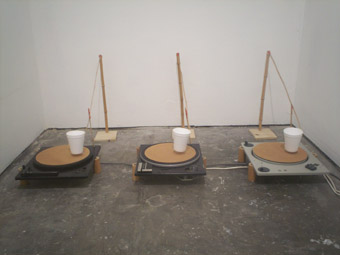
Vaucanson’s Duck, installation, Ernie Althoff
photo Robbie Avenaim
Vaucanson’s Duck, installation, Ernie Althoff
FRENCH ENGINEER AND INVENTOR JACQUES DE VAUCANSON’S THREE AUTOMATED FIGURES—THE FLUTE-PLAYER, THE DRUMMER AND THE DUCK—OF THE LATE 1730S SEEMED TO BE AS MUCH ABOUT REVEALING THE INNER WORKINGS OF LIVING CREATURES AS BEING A FORM OF ENTERTAINMENT AND SPECTACLE. THROUGH THE DUCK’S OPEN ABDOMEN ONE COULD OBSERVE THE HUNDREDS OF MOVING PARTS AS THE LIFE-SIZED REPLICA ATE AND APPEARED TO DIGEST FOOD. IN VAUCANSON’S DUCK, ERNIE ALTHOFF, ROBBIE AVENAIM AND DALE GORFINKEL APPEAR TO HAVE PRODUCED A SIMILAR ARRAY OF MOVING PARTS, HOUSED WITHIN THE THREE ROOMS (AND FOYER) OF BUS GALLERY, WHILST ALSO REVEALING, VIA A TWO-WEEK SERIES OF CONCERTS WITH SPECIAL GUESTS, THEIR OWN INTERNAL WORKINGS AND PROCESSES AS ARTISTS.
The installation component of Vaucanson’s Duck features a collection of constructed and deconstructed sound-making objects. Each is accompanied by fictitious museum-style labeling attributing all of the works to Jacques Vaucanson, with titles such as Self-portrait with Duck, Duck Egg Blues, Two Left Webbed Feet and Duck Photographed by Edweard Muybridge.
Althoff’s constructions are the first to be encountered in the foyer and the long room adjoining it. Most feature either a record player or tape player as the driving mechanism for an object that strikes various other constructions placed in its path. One in particular has three polystyrene cups held in place on three turntables by split bamboo structures. Pointed legs attached to the bases of the cups inscribe marks onto masonite discs on the record players producing a drone of rough, scraping sounds; this in contrast to the mainly percussive textures that Althoff’s other instruments produce.
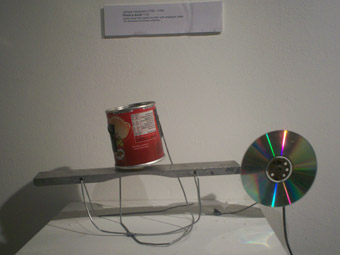
Vaucanson’s Duck, installation, Dale Gorfinkel
photo Robbie Avenaim
Vaucanson’s Duck, installation, Dale Gorfinkel
Gorfinkel also employs the polystyrene cup in his deconstruction of the vibraphone. Along with other vessels—tin cans, tennis ball canisters, plastic cups—he resonates vibraphone bars by placing motorised discs (predominantly CDs and Meccano wheels) against them. Suspended from the ceiling, or propped up on makeshift wire stands, the previously percussive instrument becomes a rich drone-making device while the vessels, swaying over the bars, shift the timbre as the sound is trapped within their small empty spaces and vibrate sympathetically.
Avenaim turns the percussive into drone by resonating the skin of a suspended kick drum with a vibrating spring attached to its lower surface. Another instrument features a suspended motorised drumstick, set off kilter by a fifty cent piece which jitters over an array of objects resting on another drum. Metal discs, rocks, bells, a spanner, wood, bamboo and a tambourine are some of the objects that the rapidly paced drumstick encounters. A motorised kick drum pedal with variable speed, a super 8mm projector with a circular saw blade instead of a film reel, and various resonating motors and objects also form some of Avenaim’s explorations into instrument making.
The performances included a selection of the instruments from the installation, additional elements and guests performing with the trio on most nights. The second night comprised a duet between Althoff and Avenaim concluding with a solo by Gorfinkel. Althoff played a pair of children’s coloured spinning bells, a wind-up frog and some of his percussive instruments while Avenaim played his haptic, jittering motorised drumstick, drone kick drum and some small motors on varying surfaces. The percussive sounds bounced about the space tingling the ears. A vibraphone with a series of Meccano wheels grinding away at the ends of vibraphone bars seemed to cue Gorfinkel to begin his solo, activating the bar instruments throughout the space and creating a dense, shimmering drone of medium to high pitched tones. He then distributed other bars, each with a fishing line handle and a mallet, to the audience who added their own percussive elements to the tones.
The final night’s performance featured a duet between Althoff and Philip Samartzis with Avenaim and Gorfinkel joining in. Althoff’s fan instrument swayed, striking a series of pewter bowls and other metal objects, while another fan knocked large sake bottles containing varying amounts of liquid. Samartzis responded with creeping fluttering tones which hovered and then moved into the foreground, transforming the space and setting Althoff’s live instruments in a new sound environment. Althoff came back with a wood and metal whirring instrument spun from an adjustable fishing line until Samartzis retreated, giving us the ‘actual’ acoustic space again. We saw more of the interior of the duck when there appeared to be a break in the communication flow as the concert’s end was announced while Avenaim and Gorfinkel were just getting started. The result was cymbals crashing into and scraping along the walls, drones from aluminium bars, fast thudding kick drum and scattering percussion creating a rock‘n’roll ending to a previously subdued yet engaging sound art performance.
Vaucanson’s Duck, sound installation by Ernie Althoff, Robbie Avenaim, Dale Gorfinkel, performances by Ernie Althoff, Robbie Avenaim, Dale Gorfinkel and guests Dave Brown, James Wilkinson, Rosalind Hall, Oren Ambarchi, Robin Fox, Erick Mitsak, Sean Baxter, Paul Wain, Graeme Leak, Rod Cooper, Anthony Pateras, Natasha Anderson, Philip Samartzis, Bus Gallery, Melbourne, Nov 9-23
RealTime issue #82 Dec-Jan 2007 pg.
© Dean Linguey; for permission to reproduce apply to realtime@realtimearts.net
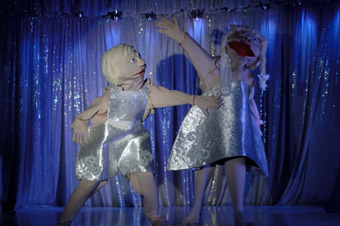
Snuff Puppets, Snuff Clubb
photo Ben Richards
Snuff Puppets, Snuff Clubb
OUR SNUFF CLUBB MC HAS IN HIS MOUTH A SET OF CHOPPERS THAT YOU WOULD NOT WISH ON YOUR WORST ENEMY. AN ARCHIPELAGO OF UNINSCRIBED TOMBSTONES TRANSFIXED IN A SLEAZY GRIN, THEY HOVER ABOVE A BOTTOM LIP THAT HAS A LIFE ALL ITS OWN.
The show begins with the reluctant appearance of Inside Outside Man, poked onstage by a woman wielding an iron probe. Initially constipated in his attempts to evolve beyond his flesh coloured costume, he eventually succeeds, confronting us with crimson muscle and flapping liver. Inside Outside Man is banished backstage. The freakshow continues with the appearance of The Great White Nanna. An incarnation of that huge breasted, maniacal madwoman residing in the haberdashery of your dreams, her hysterical cogito here finds expression in a falsetto and a head of hair self-styled with trowel and concrete. Just what the Great White Nanna sings about remains unclear. But the audience is unperturbed. We know this woman, and she has known our darkest secrets since earliest childhood.
An exploration of the perverse binds this show, and that limelight hog the Puppet Master MC is no exception. Accompanied onstage by a prancing Japanese diva, our MC answers the question we have all been asking. Stripped naked by the MC, it is revealed that six inches of masculinity lurks beneath the ditzy diva’s dress. Our MC then produces a pair of dressmaker’s scissors, reduces six inches to three, and transforms the poor tranny’s bleeding stump into an exquisitely detailed pink vulva. But wait, there’s more. Attaching his colossal nose to his groin, the MC nasal fucks this nascent vulva while the tranny is restrained in a chair. Obscenity charges pending, what makes all this palatable is the astute sense of craft from the puppet design team, and Snuff Puppet’s measured commitment to pushing bad taste to its extreme. Snuff Clubb shows that a relentless exhibition of the most base human acts can prove entertaining when removed from any abject or realistic display of that same base material.
Watching an irritating transvestite receive the John Wayne Bobbit punishment for infidelity was superseded by the Sadean ritual of the puppet pensioner sex act, live on stage. An elderly rural couple slaughter a cow and chicken, then use an extrusion machine to make 12 inch lengths of salami. Wife Beryl straps on the salty prosthesis, and fulfills Farmer Bob’s desire for back passage, extracurricular activity. While not as morbidly fascinating as genital transmutation, the above scene was played out with a sense of inevitability usually reserved for Jacobean drama. At show’s end, after being slithered over by a huge white grub, an entertained audience proffered generous and unrestrained applause for a job well done. Thoroughly perverted, this was the most indirectly disturbing act of appreciation I saw during a very funny night in the theatre.
Snuff Puppets, Snuff Clubb, direction Adam Broinowski, Andy Freer, Ian Pidd, text Lally Katz, performers Andy Freer, Adam Pierzchalski, KT Prescott, Emma Bathgate, Ryota Harada, Graeme Leak, Earl Rosas, lighting design Jenny Hector; East Brunswick Club, Melbourne, Nov 15-16
RealTime issue #82 Dec-Jan 2007 pg. online
© Tony Reck; for permission to reproduce apply to realtime@realtimearts.net
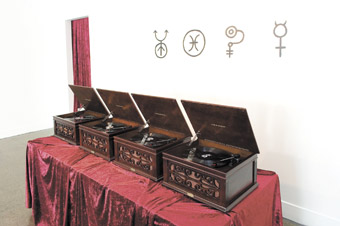
Zoso, A ritual of rock, runes & magick (detail)
photo Andrew Barcham, Screaming Pixel
Zoso, A ritual of rock, runes & magick (detail)
DID LED ZEPPELIN REALLY MAKE A PACT WITH THE DEVIL IN EXCHANGE FOR FAME AND RICHES? SO IT IS SAID IN A TALE THAT ECHOES THAT OF THE FAMOUS BLUES SINGER ROBERT JOHNSON.
Rock and roll is all about myth. And Led Zeppelin is a band of mythical stature. They are remembered as the band that set the bench-mark for three hour sets and 30 minute solos, for misbehaving with groupies and the art of hotel trashing, for excessive consumption and death by rock and roll. They helped define the music of the 70s till the arrival of punk, with its preference for three minutes of musical mayhem, stamped a use-by date on Zeppelin’s epic ballads, consigning the band to rock dinosaur status.
Zoso is an incarnation that once more unleashes the spirit of Zep. Demonic drawings and arcane symbols and sounds summon the lost icons of rock and invite the mage who never speaks and the golden god to walk among us again.
The exhibition, created by Ian Haig, Philip Samartzis and Darren Tofts, is an exploration of the mythology that Zeppelin created for themselves and with their fans—not just their status as legends of rock but the myths of their own construction that became a vital part of the culture of the band. Zeppelin’s most famous album, their Untitled IV (Runes) is an exercise in mythmaking. The album has no title and the name of the band appears nowhere, not even on the spine. The gate-fold jacket opens to reveal a drawing of the Hermit from the Tarot, a symbol of wisdom looking down from a cliff top at the ascent of a young man on a spiritual quest. In a further act of significance the band members are identified not by name but by four arcane symbols. Zoso is the timeless and sacred symbol that Zeppelin’s infamous guitarist Jimmy Page chose for himself.
According to rock journalist Simon Woods, Zeppelin had a “cool media image.” This draws on Marshall McLuhan’s theory of hot media as one “well filled out with data” while cold media requires the audience to “fill the gaps.” In contrast to the rich symbolic world that Zeppelin set out to create with their music and their albums, the band released very little information about themselves—rarely doing interviews or posing for photographs. Woods suggests that this helped create a mythology around the band. Fans imagined wild and fantastic lives for their heroes fed by the odd revelation, which would then be reverently shared; such as Jimmy Page’s purchase of eccentric British occultist Aleister Crowley’s legendary haunted castle, Boleskine House.
Zoso explores the codes of this secret society of fandom. Tofts is the hierophant of the group, taking pleasure in the language of Zeppelin—the borrowings from Celtic folklore, the pillaged blues lyrics and the curious marriage of the two. These, along with the ambiguous evocations of Page’s infatuation with the writings of Crowley and the promise of Tolkien’s imagined world without Christianity, create Zeppelin’s unique concoction of spirituality. The Boleskine Grimoire, the exhibition’s own sacred artefact, presents a text portentous with meaning. It is gleefully bubbling over with esoteric references, Zep arcana and laced with hidden messages for true believers.
Haig’s seven headed beast guitar (see this issue’s cover) is displayed in state within a private antechamber whose walls are scrawled with incarnations from Crowley and the names of demons, their unholy nature identified as the source of Page’s legendary prowess. The famous double-necked guitar was custom made for him so that he could perform multiple guitar parts at Zeppelin concerts and became both a symbol of his musical prowess and an icon of cock rock. The monster guitar complements Haig’s wall drawing of Page, which captures his uncanny feminine beauty in full thrusting rock glory.
Four lavish mock cedar record players, resplendent on crushed red velvet, symbolically support the six track recording celebrating Zeppelin’s generally overlooked importance as innovative experimental musicians. Zeppelin’s guitar virtuosity and their role in spawning Heavy Metal are common lore but their genuinely avant-garde experiments have been under acknowledged. These include the marriage of Page’s theremin playing with the Robert Plant’s vocal stylings. Also significant was Page’s bowing of the electric guitar. Samartzis reclaims Zeppelin for the avant-garde in a composition featuring gongs, cowbells, theremin, chanting and what could even be something played backwards. It is a ceremonial soundscape that is not for the faint hearted. A theremin in the gallery offers the believer an opportunity to partake in the ritual.
Zoso is an intriguing exhibition. It is first and foremost a celebration of the rich language of Led Zeppelin’s mythology and the importance of their fans in its construction. While the artists’ work is undoubtedly ironic, they have not forsaken their primary relationship as fans. Embracing the rich transformative possibilities of rock and roll, Zoso revisits adolescent dreams of Zeppelin’s promise of a world of sexuality, power and magick. This is not a dry academic reclamation but an honest fan boy confession of guilty and undying passion for the dreams of excess and dragon pants, of arcane secrets and words with two meanings and, most importantly, the pleasure of music and myth. It is an exhibition that can only be truly appreciated by the members of a secret society who rejoice in a playful nostalgia that not all its audiences will understand. In reawakening our awareness to these impulses in the confines of the gallery, Zoso also raises interesting questions about contemporary art practice, its mythologies and elite codes and the act of encryption within the gallery space.
And it makes me wonder.
Zoso, A ritual of rock, runes & magick, artwork Ian Haig, sound design Philip Samartzis, concept design and text Darren Tofts; Project Space/Spare Room, RMIT University, Melbourne, Oct 29-Nov 16
RealTime issue #82 Dec-Jan 2007 pg. 19
© Helen Stuckey; for permission to reproduce apply to realtime@realtimearts.net
This picture spread is available for download.
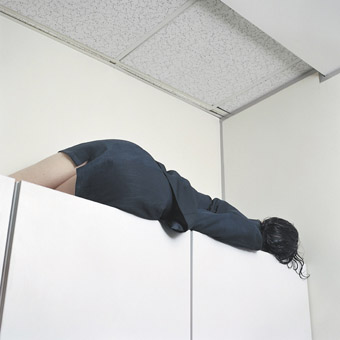
White Collar Undone (2006)
Narinda Reeders
White Collar Undone (2006)
White Collar Undone (2006), Narinda Reeders.
Reeders’ day job as a computer programmer inspired two photo-documentary series about office environments. Exhibited as part of Girl Parade curated by Bec Dean, Australian Centre for Photography, Nov 16-Jan 26
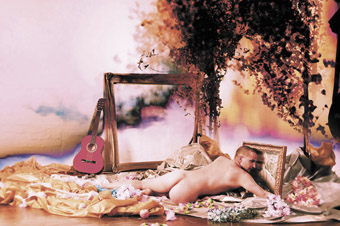
Brindabella, BalletLab
photo Jeff Busby, art direction 3 Deep Design
Brindabella, BalletLab
Brindabella, BalletLab
A collaboration between BalletLab and New York choreographer Miguel Gutierrez. A baroque fantasia on the seductive dangers of the Australian bush. Malthouse,
Dec 5 -8. Reviewed in RT83.
Photography: Alex Davies
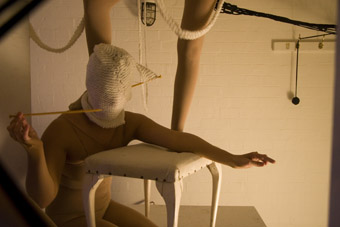
Pork in The Rafters, Body Knitting
photo Alex Davies
Pork in The Rafters, Body Knitting
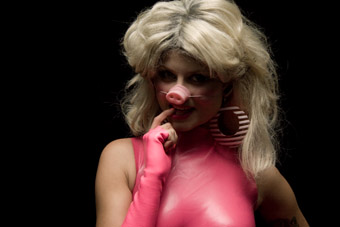
Nikki Majajas
Alex Davies
Nikki Majajas
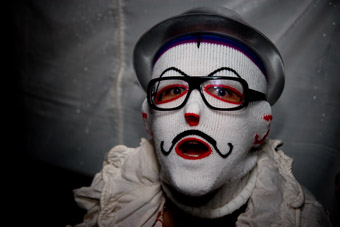
Biffo’s Blowup Bonanza, Justin Shoulder
Alex Davies
Biffo’s Blowup Bonanza, Justin Shoulder
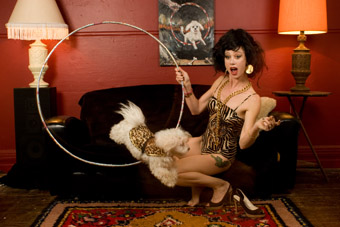
Annabel Lines and Baby Boy
photo Alex Davies
Annabel Lines and Baby Boy
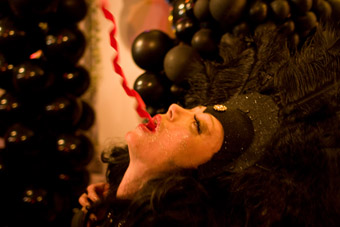
Bachanalian Bash, Annabel Lines
photo Alex Davies
Bachanalian Bash, Annabel Lines
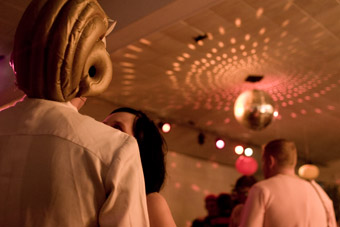
Bachanalian Bash, Medium Rare Gallery
photo Alex Davies
Bachanalian Bash, Medium Rare Gallery
A selection from Davies’ exhibition of over 150 social documentary/street photographs from Sydney and abroad. Chalkhorse Gallery, Surry Hills,
Nov 29-Dec 1, http://chalkhorse.com.au
RealTime issue #82 Dec-Jan 2007 pg. 2-3
© RealTime ; for permission to reproduce apply to realtime@realtimearts.net
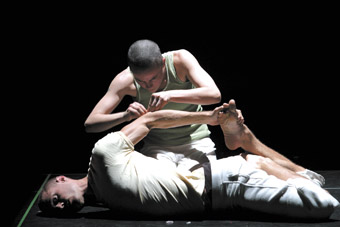
Kyle Kremerskothen, Kirstie McCracken, Aether, Lucy Guerin Inc
photo Rachelle Roberts
Kyle Kremerskothen, Kirstie McCracken, Aether, Lucy Guerin Inc
“EXHILARATING, STIMULATING, DISTURBING, EROTIC, PROVOCATIVE, CHALLENGING, HAUNTING.” SYDNEY FESTIVAL HAS SELECTED THESE ADJECTIVES TO DESCRIBE THE SEVEN DANCE PRODUCTIONS IN THE ‘FESTIVAL WITHIN A FESTIVAL’ WHICH IS THE ABOUT AN HOUR PROGRAM FOR 2008. LAUNCHED IN 2006, THE SERIES IS ONE OF FESTIVAL DIRECTOR FERGUS LINEHAN’S MOST SUCCESSFUL INITIATIVES, ATTRACTING NEW FESTIVAL AUDIENCES TO THE SYDNEY OPERA HOUSE THROUGH A $25 TICKET FEE, SHORT PERFORMANCES AND PUNCHY MARKETING.
This year’s program, subtitled Movers & Shakers, is devoted entirely to Australian contemporary dance. Sydney Festival was the successful bidder in a $200,000 tender from the Australia Council’s Dance Board and Community Partnerships and Market Development Division for an initiative to build audiences for, and raise the profile of, Australian dance. Jennifer McLachlan, Director of Dance at the Australia Council, says, “The Sydney Festival has developed a smart concept that will provide an ideal platform to showcase Australian dance to a broad cross-section of the Australian community.”
Realising that this program is the closest thing to a national contemporary dance festival Australia has had since Robyn Archer’s 2003 Melbourne Festival, the Australia Council has focused additional funding on bringing a delegation of 12 key international presenters to the festival—from North America, the Netherlands, Belgium, Germany, France, Finland, Korea and Japan.
Fergus Linehan has created a program with mass appeal, seeking work with strong imagery and high production values. He has used the new funding to commission and co-commission world premieres and remount productions recently shown in other states and overseas. Works will be shown in the Opera House’s Drama Theatre, Playhouse and Studio and at the Riverside Theatres in Parramatta. The festival has also commissioned a program of dance for screen, curated by Erin Brannigan of Reeldance, for the western foyers of the Sydney Opera House. There will also be a panel in the Eat, Drink, Talk Art series at The Mint which will bring the programmed choreographers into conversation with their audience.
force majeure
Amongst the world premieres is Force Majeure’s The Age I’m In, a collaboration with Sydney-based photographer William Yang. Described by the company’s director Kate Champion as “a revealing portrait of Australia today”, the work is a slice-of-life examination of “a random and diverse selection of Australians aged between eight and 80.” Force Majeure’s 2005 production, Already Elsewhere was commissioned and premiered by Brett Sheehy for the 2006 Sydney Festival and the company’s debut Same, same But Different premiered in Sydney Festival of 2002. Champion says,”The company came into being through the Sydney Festival so our relationship is heartfelt. We are thrilled to be part of this festival which we feel represents the ‘here and now’ of the Australian dance industry. The Age I’m In is extending our aim to represent a range of Australian experience that exists beyond the rehearsal room walls and is sourced from experiences of everyday people.”
chunky move
Another world premiere in the season is Chunky Move’s Mortal Engine (see the interview with director Gideon Obarzanek in RT81, p41), a follow-up to the widely toured dance and technology solo, Glow, which was shown at the Sydney Opera House Studio in 2007 as well as at Melbourne Festival and extensively overseas. In Mortal Engine we will experience a “new dance-video-laser performance using movement responsive video projections to portray an ever-shifting, shimmering world in which the limits of the human body are an illusion.” Promising the same shift between the exquisite and the grotesque which characterised the mood swings of Glow, but with more dancers and more technological innovations, this collaboration between choreographer Gideon Obarzanek and German interactive video systems maker Frieder Weiss features the polished integration of movement and image characteristic of much of the Movers & Shakers program.
rings, benjamin, dunn
A double bill commission is the third world premiere in the season. Independent choreographers Frances Rings and Narelle Benjamin have created solos for dancer Kathryn Dunn. Rings’ Belonging is an “evocation of the innate connections between the body and nature.” Rings, one of Bangarra Dance Theatre’s resident choreographers, says, “ I feel this work is as much a journey back home for me as it is for Katie. With each of my new works I step closer to connecting with my roots. I’m excited to work with a soloist and really get down to defining my choreography and to partake in some Women’s Business.” Benjamin says her work, Figment, “was created to throw light on my sister’s experiences as a suffering schizophrenic. Schizophrenia changed her reality, and re-wrote the path of her past for years before beginning treatment. After she began taking medication, and gaining some relief, she kept journals detailing her hallucinations and delusions. She also took the time to talk of those times and the ongoing battle she wages with this debilitating disease.” Benjamin is using the same creative team she assembled for recent productions, Gossamer and The Dark Room, with Samuel James contributing projected images and Huey Benjamin the score and sound design.
shaun parker
Amongst the Sydney premieres are Shaun Parker’s This Show is About People, a hit of the 2007 Melbourne International Arts Festival. Dancer-choreographer Parker collaborated with vocalists Mara and Llew Kiek and a talented group of dancers and musicians to create a humorous dance theatre work with appealing musical quirks (see John Bailey’s review p8). Parker says,”I wanted to make a work about the nature of life and death and the questions one asks about humanity and to allow the production to be driven by the body and the voice—two of the fundamental aspects of what it is to be human. I want my work to connect with audiences, and challenge them all at the same time.”
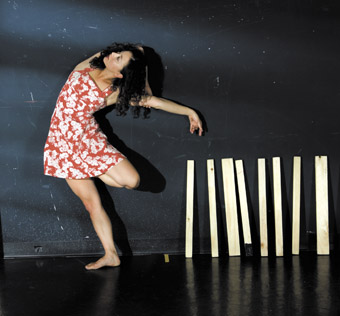
Kristina Chan, construct
photo Chris Herzfeld
Kristina Chan, construct
tanja liedtke
Tanja Liedtke’s Construct premiered in London in 2007 (see Martin del Amo’s review in RT81) and toured the UK just prior to the choreographer’s untimely death. Solon Ulbrich, associate director of the work and Liedtke’s partner, says, “Construct received acclaim from England’s The Times newspaper as ‘a bolt out of the blue’ and has been planned for presentation in the Sydney Festival since April 2007. The festival is to be commended for maintaining their commitment to presenting Construct. We are thrilled to present the work and fulfil Tanja’s commitment to bringing audiences the finest, stimulating dance experiences.”
lucy guerin
Lucy Guerin’s Aether is new to Sydney, but the company certainly is not. Guerin says, “Being programmed in Sydney for the third time in 12 months is an incredible opportunity for our company to consolidate the audience base we have there and also to make some inroads in expanding it. Our company is on a strong upward trajectory with various opportunities appearing in our hometown of Melbourne, as well as around Australia and the world.” Described by Guerin as “an intricate and chaotic dance piece”, Aether “depicts the struggle of five dancers—at once fast, furious and delicate—as they transcend the messy clutter and confusion of contemporary communication and make direct, and ultimately human, connections.”
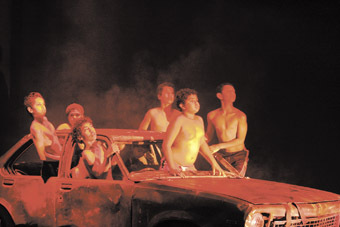
Kin
photo Joanne Bell
Kin
stephen page
Kin by Stephen Page, Artistic Director of Bangarra, is a surprise inclusion, featuring as it does, a cast of pubescent boys clambering over a burnt-out car and telling their stories in dialogue, rock music and rap as much as in dance and movement. Page calls Kin, commissioned by the 5th Asia Pacific Triennial and shown at the Melbourne International Arts Festival, “a contemporary initiation through theatre into the social and political problems in Aboriginal communities,” yet his touch is light and the “young boy energy” which he celebrates ignites this production and makes it worthy of inclusion in a line-up of Australia’s best dance talent.
Such an unprecedented line-up of dance productions is likely to attract excited audiences and it is no wonder that Linehan’s launch publicity for the festival calls this season “our proudest programming achievement” and predicts it to become “the talk of the festival.”
–
Sydney Festival 2008, About an Hour: Movers & Shakers, Sydney Opera House, Parammata Riverside Theatres, Jan 5-26, www.sydneyfestival.org.au
RealTime issue #82 Dec-Jan 2007 pg. 4
© Sophie Travers; for permission to reproduce apply to realtime@realtimearts.net
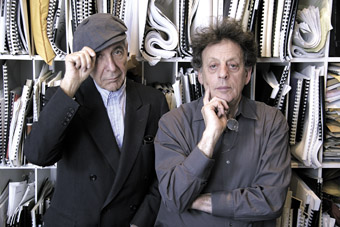
Leonard Cohen & Philip Glass
ALTHOUGH VERY DIFFERENTLY PROGRAMMED, THE 2008 SYDNEY AND ADELAIDE FESTIVALS SHARE A PASSION ABOVE ALL FOR MUSIC. SYDNEY’S ARTISTIC DIRECTOR, FERGUS LINEHAN, HAS MAXIMISED THE FESTIVAL’S POPULIST TENDENCIES (AT THE SERIOUS END OF THE SPECTRUM) WITH A MASSIVE MUSIC LINEUP RANGING FROM BRIAN WILSON AND BJORK TO AMERICAN INDIES, DETROIT DJS AND AUSTRALIAN INDIGENOUS PERFORMERS. ADELAIDE’S BRETT SHEEHY HAS GIVEN CENTRESTAGE TO AINADAMAR, GOLIJOV’S OPERA ABOUT FEDERICO GARCIA LORCA, AND PHILIP GLASS’ INTERPRETATION OF LEONARD COHEN’S RECENT COLLECTION OF POEMS AND DRAWINGS, BOOK OF LONGING. ON THE JAZZ FRONT, SHEEHY HAS BILLY COBHAM AND ORNETTE COLEMAN. ON CONTEMPORARY CLASSICAL THERE’S THOMAS ADES AND JOHN ADAMS AMONG OTHERS AND A DRAMATISED LIFE OF VIVALDI, THE RED PRIEST.
Sheehy’s final Adelaide Festival appears to be his best, at least on paper. It’s rich in potent content. However, compared with the thematically rich festivals of Kosky, Archer (in Adelaide and Melbourne) and certainly Kristy Edmund in her 2007 Melbourne Festival, Sheehy adheres to the conventional model of programmed diversity. Whether or not he’ll please Melbourne’s vociferous conservatives (desperate for opera, ballet, symphonies and great Shakespeares) when he takes over their festival in 2009 is another matter—he’s quite capable, as his 2008 Adelaide Festival attests, of programming challenges for his audience. Fergus Linehan has moved on from the diversity of his first two programs to something more ambitious and coherent—a massive celebration of music, diverse in itself, but focused especially on the riches of popular music yielded by the 20th century and still being mined and developed and doubtless bringing a new audience to the festival.
adelaide festival
Ainadamar (Fountain of Tears) is Oswaldo Golijov’s first opera. It premiered in 2003 and a revised version was directed by Peter Sellars in 2005. Golijov is an Argentinian composer of Eastern European Jewish extraction. He’s an adventurer in the weaving of instrumental and electronic sound, the juxtaposing and merging of music from various cultures (here Christian, Sephardic and Arabic, true to Spain’s history), but not adventurous in a modernist, avant-garde sense. His melodies are largely tonal, his harmonies immersive, his rhythms regular, his constructions familiar, but he can move and provoke and create passages of great beauty, capacities ideal for opera.
In the restrained theatricality of American David Henry Hwang’s libretto Lorca’s execution by the fascist Falangists is framed by the death of the revolutionary Mariana Pineda, executed in 1831 (and whom Lorca celebrated in the play named after her), and then principally by the coming death of Lorca’s actress friend Maria Xirgu, old and ill in Montevideo where she has carried on the writer’s theatrical tradition. She’s passing it on it to her young student Nuria but continues to suffer guilt for having failed to convince Lorca to flee with her from Spain in 1936. Maria and Nuria are performed by sopranos, Lorca by a mezzo, heightening the sense of the writer’s complex sexuality.
Lorca, himself a composer, was in love with flamenco and it quickly establishes itself as the principal musical mode of the opera. Ainadamar opens with the sound of a dark flood of water, heralding trumpets, castanets, the beating hooves of galloping horses, propulsive drumming and then the high whine of a female chorus singing of Mariana Pineda against strummed guitars and soaring strings. These constellate to frame Margarita Xirgu’s recollections (“the day I first took [Lorca’s] hand—soft like a baby, yet he was already a man”). Golijov immediately evokes the Spain we know through Spanish folk, classical and movie music, but manages to transcend pastiche with a sustained line and careful emotional shaping. Capturing the sense of a nation betraying itself, Lorca’s Falangist tormentor and executioner is sung in flamenco tenor. A rasping, recurring Radio Falange broadcast (“Whoever is not with us/ Is against us”) deepens the mood of threat.
The text of Hwang’s libretto is spare and uncomplex, replete with just enough striking images (“To Havana, ah! With my skull open to the sun,/ sand tasting like rum/ The breeze is my shepherd, /I shall not want”) in the manner of Lorca, and capturing the poet’s intensely personal notion of revolution, social yes but in search of other kinds of release and embodied in adoration of the suffering woman. Of Pineda, Lorca sings “Yet the revolution betrayed her/ for all she really wanted/ was love, only love.” Lorca himself is Christ-like, in his own words (“I walk singing, crowned with thorns”) and those of the chorus (“you carried your cross, /on his left, a school teacher, on his right, a bullfighter,/ and the fountain began to cry”). Some of the most affecting music is heard in the Voices of the Fountain and then in the pathos of Confession with its many gentle voices (including recorded village folk in prayer against high, delicate marimba arpeggios) and Lorca refusing death. The electronically treated gunshots come as a shock, sole accompaniment to the Falangist tenor and mutating into the sharp pulse of castanets.
The Adelaide production is to be directed by Graeme Murphy, with design elements by Brian Thompson and video by Tim Gruchy, and Slava and Leonard Gregorian featured on guitars, most prominently for a taut duet, Crepuscule deliriant (“Delirious sunset, an interlude of light and orchestra–guided by two Arab guitars”), prelude to the sublime trio of sopranos with guitar, Day mi sangria (Here is my blood), at the opera’s end. For some, Ainadamar will amount to no more than superior kitsch, a simplistic account of the last hours of a great poet and dramatist, for others it will be a deeply moving experience. A recording of this brief opera is available on one CD (DG 002894776165) with Dawn Upshaw, the composer’s favourite soprano in superb form as Xirgu (listen also to her remarkable performance on Golijov’s more provocative Ayre, DG 002894775414), with Kelley O’Connor excellent as Lorca (and appearing in the Adelaide production with Jessica Rivera as Xirgu).
In the 1990s Leonard Cohen spent eight years in a Buddhist monastery from which he emerged back into the world of song, sexuality and love and with a large collection of poems and drawings now published as Book of Longing. Cohen had read many of the poems to Philip Glass before their publication and the composer suggested he score them as a song cycle. The performance, described as “part concert, part cabaret”, features Glass, his ensemble, vocalists and projections of Cohen’s drawings, but not Cohen himself (except as occasional recorded reader of his poems), nor his tunes. This could be a very odd experience but the advance word is good. Even a seasoned Glass-watcher and doubter like the New Yorker’s Alex Ross finds that “the expected stretches of prefab Glass give way to sharply characterised [instrumental] solos…These set the stage for a potent reimagining of Cohen’s song ‘You Came to Me This Morning’—it becomes a languid ballad somewhat reminiscent of the Kurt Weill of ‘Rise and Fall of the City of Mahagonny’, driven along by an ominously seething ensemble accompaniment. In the right context, Glass’ music releases unexpected energies” (November 5).
The recently published Penguin paperback of Book of Longing is a generous offering of Cohen both profound and slight, and inherently tuneful—it’s easy to imagine many of the poems sung, and a couple, like “Because of”, have been on recent albums. The evocation of monastic life is strong, how tiny details, like insect life, become enormous, the denials and contradictions (the master priest Roshi’s love of Scotch whisky), and Cohen’s growing sense of a life not right for him. Side by side with resignation about a life nearing its end (“This is it”, or “Takanawa Prince Hotel Bar” where Cohen espouses the “the Great Resignation of Poetry”), there’s anger too, not just about the incapacities of an aging body and monastic deprivations, but also the fundamentalism inherent in his own questing: “I joined a tiny band of steel-jawed zealots/ who consider themselves/ the Marines of the spiritual world” (from “The party was over then too”). The Glass Book of Longing (also soon out on CD), should be nothing less than fascinating in performance with works sung and read—a reminder that Cohen started out as a poet in the 1950s; I remember reading and admiring him in the 60s, his novels as well, before his singing career commenced.
There’s much more music in the Adelaide Festival and some very strong theatre. Schaubuhne an Lehniner Platz Berlin present Tenessee Williams’ Cat on a Hot Tin Roof. Malthouse and the Sydney Opera House have commissioned Marius von Mayenberg’s Moving Target, directed by Australia’s Benedict Andrews (who impressively directed the writer’s Eldorado for Malthouse and directs at the Schaubuhne). The Netherlands’ company Kassys will present Kommer (Sorrow), a reverie about grieving that moves from stage action into film. Brink Productions will premiere Andrew Bovell’s When the Rain Stops Falling, Dash Arts will present A Midsummer Night’s Dream in Tim Supple’s multilingual production drawing on classical Indian dance and martial arts, and Lovers & Haters is a new play about Don Dunstan written by Rob George and Maureen Sherlock. South African State Theatre presents Township Stories, a serial killer thriller with a strong social perspective.
In dance, DV8 will perform To Be Straight with You, a work derived from interviews with people affected by various forms of discrimination; Akram Kahn and Sylvie Guillem will unite for Sacred Monsters; and Australia’s Force Majeure will collaborate with William Yang to present The Age I’m In (see page 4). The program also includes Chunky Move’s Glow and the Emmanuel Gat Dance Company from Israel. As always there’s a strong visual arts lineup in the festival, but more about that later.
sydney festival
Sydney Festival will open with a huge, free music party instead of the usual guests-only gig, encompassing Hyde Park, Angel Place, Macquarie Street, The Domain and beyond, and featuring Brian Wilson, Paul Kelly, New York’s Pink Martini and many others. The party is the prelude to an ambitious round of concerts, major ones featuring large bands, orchestras even. Brian Wilson and band will perform the classic Pet Sounds in one concert and a new work, That Lucky Old Sun (A Narrative), a hymn to California, in another. The festival’s previous celebrations of Leonard Cohen and Lou Reed (the staging of Berlin featuring Reed himself) have pulled huge audiences and aided some intriguing critical re-evaluations; the Wilson should do no less. Bjork, as popular with the art scene as with her fan mass, sold out within seconds: the anti-scalper unit is on alert.
American songwriter Sufjan Stevens has created an engaging, eccentric body of work with his curious take on Christianity and American culture in compositions rich in the idioms of hymns and folksong, and sometimes boosted to epic force with orchestral instrumentation. As with Brian Wilson and Bjork you’ll get something more than a nice set of songs. Stevens’ band will be supplemented with a wind and brass ensemble and video projections. Joanna Newsom, like Stevens another acquired taste, is also in symphonic mode, performing her album Ys with the Sydney Symphony Orchestra in arrangements by Van Dyke Parks (a key Beach Boys collaborator).
On the Australian front, Indigenous music is strongly represented in two concerts by an astonishing lineup of talent supported by prominent non-indigenous artists. In Cannot Buy My Soul, the truly idiosyncratic and bracingly political Kev Carmody will perform with Broome’s wonderful Pigram Brothers, Paul Kelly, The Herd, The Drones, Missy Higgins, Steve Kilbey and others. From Melbourne’s Arts House comes Murundak, a multimedia performance embracing a wide range of Aboriginal performers gathered as Black Arm Band, including singers, actors and didjeridu virtuoso Mark Atkins. Among the participants are Archie Roach, Ruby Hunter, Ursula Yovich, Stephen Pigram, Peter Rotumah, Dave Arden, Shellie Morris, Kutcha Edwards, Emma Donovan, Joe Geia, Dan Sultan and Jimmy Little. These concerts will present what has become a major body of Australian song, a rare opportunity to survey established work and new. In another act of reflection the remaining members of The Triffids will pay tribute to the late David McComb with songs popular and rare, and projections and readings—another opportunity for re-evaulation but now in live performance after the recent CD re-releases.
Among a host of other performers doing more intimate shows are Chicago-based singer-songwriter, multi-instrumentalist and whistler extraordinaire Andrew Bird (Armchair Apocrypha, 2007); France’s 10-piece Babylon Circus merging a multitude of styles from ska-punk to dancehall; the eagerly anticipated 6-piece Tunng from New York with their infectious experimental pop-folk-electronica; from South Africa, Third World Bunfight and performance poet Odidi Mfenyana in House of the Holy Afro; from the US, Grammy-winning hip-hop artists De La Soul and People Under the Stairs; Montreal’s electro-funk duo Chromeo; melodic New York-based indie band Mice Parade; Australia’s Martin Craft (back from London); influential Detroit house producer Moodymann; also generating high expectations, Brooklyn’s complex, dark-toned The National (Boxer, 2007) on the same bill as Clogs; Brazil’s dance-driving Monobloco; and Minnesota’s harmonising, richly minimalist Low.
Noite Brasil, with Oscar Castro-Neves, was a big success for the festival in 2007 and will be followed in 2008 by Jazz in The Domain: El Barrio with music rooted in New York’s eastside, specifically ‘salsa dura.’ The 13-piece Spanish Harlem Orchestra will be conducted by famed pianist and arranger Oscar Hernández and featuring one of jazz’s greatest trumpeters, Jon Faddis.
The Sydney Festival 2008 program has a substantial Australian dance program (see page 4). As well Spain’s Compañía Nacional de Danza will present Three Works by Nacho Duato, including the choreographer’s Alas (‘wings’ in Spanish), a version of the Wim Wenders film The Wings of Desire, created in collaboration with leading Slovenian theatre director Tomaz Pandur.
The theatre program has a strong political bent derived from works with a documentary impulse. At the centre of the program is the recently formed National Theatre of Scotland with Aalst, the company’s version of a Belgian play based on fact about a husband and wife who murdered their two children in 1999, and Gregory Burke’s Black Watch, again a work rooted in reality, here interviews with soldiers from the Iraq war.
Urban Theatre Projects from Sydney’s western suburbs return to the festival after the success of their 2007 show, Back Home. The new work, The Last Highway, is described thus: “In a 24-hour service station on the edge of the road through a remote industrial part of western Sydney, the paths of six late-night workers intersect in startling ways.” These are sex-workers, taxi-drivers and shift-workers and the performance focuses on their individual beliefs and larger issues of alienation and dispossession. Big hART’s Ngapartji Ngapartji features Trevor Jamieson and people from the Pitjantjatjara community in this performance (and language lesson) about land not only taken from a people but destroyed in nuclear blasts in the 1950s. Like Aalst and Black Watch, The Last Highway and Ngapartji Ngapartji have developed out of intensive research and consultation.
There’s more predictable festival fare in the exotic and expert circus theatre of La Clique, Cirque Ici and James Thiérrée’s Au Revoir Parapluie. Warranting particular attention is Meow Meow’s Insert the Name of the Person you Love, “inspired by an article on the time it takes to fall in love.” As ever the femme fatale is in trouble, which puts her on the edge—the best place for this risk taking performer and virtuosic vocalist. Meow Meow is a true international of the cabaret and performance scene—her solo cabaret show Beyond Glamour featured in David Bowie’s High Line Festival in New York.
For something out of the ordinary and in the open air, try US-based Australian artist Anita Fontaine’s Ghostgarden, in which d/Lux/MediaArts takes you “on a cinematic journey” through Sydney’s Botanic Gardens, relocating you in the 19th century when the site was a zoo and parklands. Using the worldwide Global Positioning System (GPS) and a pocket PC, you wander the gardens, a tale of love unfolding around you. For more of the surreal in the age of bio-mimickry, try Los Angeles-based Tim Hawkinson’s Mapping the Marvellous at the MCA, featuring found object creations that include animals— “among them a bat created from shredded black plastic bags and twistie ties—as well as inflatable and collaged self portraits, monstrous beings and fantastical structures that chatter, whistle, rotate and spin.” But if it’s visual arts you want, then Adelaide, as ever, has had the greater commitment of Australia’s international arts festivals.
Sydney Festival, Jan 5-26, www.sydneyfestival.org.au
Adelaide Festival, Feb 29-March 16, http://adelaidefestival.com.au
RealTime issue #82 Dec-Jan 2007 pg. 5
© Keith Gallasch; for permission to reproduce apply to realtime@realtimearts.net
<img src="http://www.realtime.org.au/wp-content/uploads/art/14/1424_walker_melb_merce.jpg" alt="Merce Cunningham Dance Company,
The Melbourne Event, Federation Square “>
Merce Cunningham Dance Company,
The Melbourne Event, Federation Square
photo Carla Gottgens
Merce Cunningham Dance Company,
The Melbourne Event, Federation Square
I WENT TO THE MELBOURNE FESTIVAL TO SEE THE MERCE CUNNINGHAM DANCE COMPANY, AND TO SEE MERCE CUNNINGHAM. I WENT TO SEE HIM IN CONVERSATION, IN THE FLESH THAT IS. I SAW HIM IN FEDERATION SQUARE FIRST THOUGH, ON A SATURDAY AFTERNOON, WATCHING HIS COMPANY REHEARSE FOR THE MELBOURNE EVENT, FREE FOR THE PUBLIC. IN A WHEELCHAIR, HE LOOKED BOTH VULNERABLE AND FRAGILE, BUT SOMETHING ELSE TOO, CONTAINED PERHAPS (GATHERED) IN HIS AGE (88).
event: federation square
The event was performed on two white raised stages, a little apart, with a matted red passage between them. The Music Committee (Christian Wolff, Takehisha Kosusgi, David Behrmann and John King—although I’m not sure now if all were present) accompanied the dancers on a stage nearby; a screen above them showed the performance close-up. For the viewer the scene was rich, looking between each of these and at the audience too; overall the given situation, the square and the sky and the helicopters, reflected the overall philosophy of the Cunningham way—that is, that there are multiple points of view, and that distraction can happen at any time and in any direction.
There were thousands of people, and the square was a perfect venue, and the weather was perfect, hot and overcast and still, rain hovering, and the performance was a perfect experience, an extremely moving ‘event.’ The 14 dancers used both stages, performing solo or together, and changing stages, the running between the stages part of the action. The event was about the event of dancing—the whole scene; we were in and of it; and the dancers were twisting and bending, unfolding, standing still, raising fingers, finding synchrony (for a second). The music/sound made its way through the time and space from its own realm, producing itself with and as the event; the dancers were precise in their own way, the musicians were precise in their own way, and we were watching in our own precise way, moving with our alert and longing bodies toward the dancers, being attentive to the intricate shapes they made, and were, external to themselves, as they found pleasure in the company and support of each other. Nothing big or spectacular, but endless ruptures and deferrals. Dance that could emerge once, and then once more (as if only just beginning to emerge), like water, like sand too.
in conversation
And then, on Monday evening Merce Cunningham was ‘in conversation’ with Lee Christofis and David Vaughan. And the sheer quiet elegance of his talk (I mean the tone of it, the good humour)—as this is what it was, just talk, in terms of his life-story as a matter of ‘fact’ and extraordinary at the same time, and never underestimating the situation in which he found himself, and the people he was fortunate to learn from, as it happened and as he ‘took it up’—was instructive and compelling, as ‘talk’ without command. It was a life lived—which is what he said ‘dance’ is—a way to be alive; that one is in the body of the dance, as a life, living.
What became clear was that we are each differently alone, and involved, always, despite our condition, in the actualising of ourselves as ‘movement’ (as vibrating creatures, even at rest); with dance we watch the body that we are performing before us, embodied (only) with its tuned flesh, blood and bones, and the thought-body of a philosophy. And we are mesmerised that it can make itself such an instrument; and that instrument manifests itself continually as rippling overlapping force-lines; that it is a line drawing energy through space (touching upon the terrible moment, recognised, of one’s own passing)—the picture never stills, the score is never settled, the drawing bursts out of its trajectory—in the next/to/nothing of a pattern that snaps, and pours or slides across another.
Dance, as Cunningham teaches it, is an inventive process, a learning without end that invites thought for thought’s sake; for the sake of thought’s own dance toward the unknown. The stage’s replete availability is acted on immediately, instantly, presently. There is no going back, no erasure, no hiding places. The stage is there, a zone/field, and the performer is there in real time, to dance for dance. It is in the doing that learning happens (said Cunningham), and it happens in unexpected, unforeseen ways; that is, it happens as it passes (in the acts of living/dying). It is this that passes that can be reflected upon, as if by chance (imagined), and by chance (amazement). As a reading, or a way of creating, it is the ‘present tense’ pressing forward, and paused by taking time to think with the ‘unpinned’, the glimpsed. It is though, to some extent, present(ed) to us through effort, this is its matrix, its begetting; that it arrives with ‘the times’—the political scene, the despair, the hope—of its making (its interminable repetition) and the times of its delivery (now, as we wait, hold our breath, and dream ‘freedom’) through (and this is a decades-long slow acceleration) the mind of Merce Cunningham. Dance, as he makes it (in the imaginal), is possibly the closest form of ‘making’ to our ordinary going-about in the world—or perhaps this is only a make-believe (imaginary) state of my own (believable nevertheless).
performances
Then there were the two performances at the State Theatre of five dances, dated between 1956 and 2006: Suite for Five, eyeSpace, BIPED (these were accompanied by live acoustic and electronic music played by Christian Wolff, Stephan Moore, Josephine Vains, Takehisa Kosugi and John King), Views on Stage, and Split Sides (with Christian Wolff, Josephine Vains, Takehisa Kosugi, and Sigur Rós). The music composed by John Cage, Mikel Rouse, Gavin Bryars, Radiohead and Sigur Rós. I will mention only three of the works.
Firstly Suite for Five (1956-58), the earliest one, with John Cage’s Music for Piano. This is spare, sparse dance, elegant even now—single steps, single notes, joinings, unjoinings, small classical references, funny too (solos, trios, quintets); one saw ‘instability’, the separation between dancers, and the body changing (how it adjusts, falls, leaps, lands, curls, reaches; the body’s contours bare as bones) from one shape to another; one could feel the intricacy of a step and a note, how they look and sound, and how far apart they are, as one watches and listens for their coming into the world, all by themselves, to find each other.
Then after an interval eyeSpace (2006). We all brought, or borrowed at the venue, an iPod, and when instructed turned it on. The set (called ‘décor’ in the program notes) was minimal but imposing, like a fragment of an architectural relic, and the dancers mostly, as I recall, in groups. A whole theatre of people were suddenly within their own aural space, each hearing whatever their shuffle was up to—from commissioned work by Mikel Rouse titled International Cloud Atlas (almost kitschy, post-pop, slightly dark, perhaps muzak). But through the headphones, coming from elsewhere, could be heard something different; there was another ambience being played; out there were urban noises, distant voices, a railway station, a scene of passage, of anonymous deeply resonant humanness. What one had then was ‘eyespace’, one was a looking-creature, shut in, but with freedom to ‘come out’ and hear the world, as can happen on a train, or bus, or plane—and there was no correspondence between elements, they just were as they were; one was moving inside the space of oneself and through the space of the universe—there was no easy way of conforming here; one could listen as one wanted. The dancers though seemed clumsy at times, tired even.
Split Sides (2003) was the very last work to be performed at the festival. It opened with Cunningham on stage explaining how the dance would be structured with the throwing of dice. Several people threw the dice, including festival director Kristy Edmunds. This was videoed, and we saw it on a stage screen. Odds or evens determined the order of the two parts of the dance, and of the decor, the costumes, the lighting, and the music—Radiohead or Sigur Rós. As it happened, Sigur Rós were second. And this for me was the highlight—seeing/hearing them perform live with the MC Dance Company. Sigur Rós are Jon Thor Birgisson, Orri Pall Dyrason, Georg Holm, and Kjartan Sveinsson. I’m a fan of this Icelandic group, so I was in heaven. Two of the group stood throughout the set, their darkly silhouetted heads sitting above the centre of the stage watching the dancers. And as the music rose and fell and wound its strangely ethereal and romantic tensions throughout the space the dancers came alive in a more intense way (connecting tenuously with the sound-landscape); perhaps I imagined this, but by the end of the dance they were sharper and at the edge of the sound, their bodies infused with the continual wooden wound-up clicking noise threaded through the sonic beauty.
to work with the work
And what to write, to close? There’s probably nothing to write, except that there is too much to write. When he was a young dancer, Merce Cunningham said “dancing is a spiritual exercise in physical form …” And one can sense this, a silence, a pause, that energises the actual act (makes of it a field)—a flash of exquisite timing, a body flying, a set of tiny shuffles, something releases, lets go, delivers, and it’s not the composite of someone/dancer, but another (other of oneself), a sensed thing. And then there is faith, to do it, and to be prepared for it. And that’s what he said in the ‘conversation’—to do it, is it (life).
The ‘work’ that is done is the key here, the freedom to do ‘work’, to do the work one has to do. It’s a political act, an imperfect act, and it is perfectly useless, it’s the least one can do for a world at war, for instance, or a world gripped by the economics-of-everything, in any case a world whose heart is breaking. It’s not hard to see this work, as the decors are relatively plain (that is, definite and artful), the bodies clearly shown (in body-suits), the lighting never a shelter, the music opening spaces for the rhythms (and imbalances) of the various bodies (leaving the dancers to find other ways of working in near unison besides beats); that is, the bodies have no narrative to dwell within, and as soon as you surmise that there might be, it flees—nothing develops, starts, stops, possibilities abound (maybe everything is/was practice, life as practice). “Our way of working is political, but not overtly so, rather in the way we work together…We have travelled all these years with separate individuals, each one doing their work; I don’t tell the musicians what they have to do, nor they me, and it’s the same with the artists. For me, this is a political movement…”
The Merce Cunningham Dance Company sets thought in motion; not because of seeing the dance-body, its restlessness, its difficult exuberance, but because of the philosophy it is imbued with, and the acts and interactions it has created across genres—the writings and art that it has engendered, the changes to dance itself, and the crucial personal and professional relationships sustained between two intellectual and poetic thinkers, John Cage and Merce Cunnigham. This work asks us to ‘work’ with it, and to investigate their ‘working’ methods, so as to act upon the world ourselves—outside of being present to-see.
Cunningham quotations are from Dee Reynolds, Rhythmic Subjects, Uses of Energy in the Dances of Mary Wigman, Martha Graham and Merce Cunningham, Dance Books, Hampshire, 2007
Melbourne International Arts Festival, Merce Cunningham Dance Company, The Melbourne Event, Federation Square, Oct 21; Merce Cunningham in Conversation, ACMI Cinema 2, Oct 22; Program A Oct 24, 25, Program B, Oct 26, 27 State Theatre, Arts Centre, Melbourne
RealTime issue #82 Dec-Jan 2007 pg. 6
© Linda Marie Walker; for permission to reproduce apply to realtime@realtimearts.net
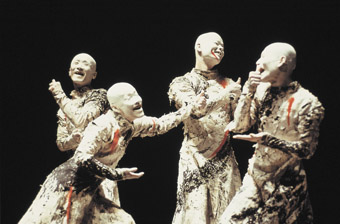
Sankai Juku, Kagemi, Beyond the Metaphors of Mirrors
photo Jacques Denarnaud
Sankai Juku, Kagemi, Beyond the Metaphors of Mirrors
THERE IS SOMETHING CHURCH-LIKE ABOUT THE VICTORIAN ARTS CENTRE, WITH ITS MELBOURNE FESTIVAL RITUALS OF MASS ATTENDANCE AND CELEBRATORY APPRECIATION. ROBERT WILSON ENHANCED THIS ELEMENT OF RELIGIOUS CEREMONY IN THE TEMPTATION OF SAINT ANTHONY, LIGHTING ITS CAVERNOUS STATE THEATRE ALONG THE LINES OF A MODERN-DAY CHURCH. HIS CAST OF AFRICAN-AMERICAN ARTISTS DULY PROCESSED INTO THE SPACE IN RICHLY COLORED ROBES, SITUATING FLAUBERT’S WORK ON SAINT ANTHONY WITHIN A PARTICULAR MUSICAL MILIEU.
robert wilson
Wilson’s esteemed collaborator, Bernice Johnson Reagon, exercised her extensive knowledge of the musical/spiritual heritage of African-American culture in writing the music and libretto for this work. Reagon’s background in civil rights, historical research and musical performance gave the production depth and credibility. Its series of songs progressed from the singing of spritiuals through to blues, jazz and into hip hop.
The story is embroidered around St Anthony’s ascetic retreat into the desert. Though pivotal, St Anthony was upstaged by a series of luscious figures and musical numbers embodying the temptations of sin, sex and worldly dominion, all aimed at corrupting the saint’s spiritual purpose. The power of colour, through costuming and Wilson’s characteristic fulsome washes, contrasted with the singularity of white —the sign of spiritual purity. Red, blue, purple, hellfire, sizzling sexual desire, the heat of passion and worldly seduction—I would have definitely opted for the snake over the rather wan St Anthony. The production incorporated a range of performers from young to old, lithe to substantial. If the older performers suggested frailty with their slow movements and walking sticks, their voices resonated with the aged richness of a Chambertin purloined from Flaubert’s celebrated cellar.
sankai juku
While Wilson’s distinctive usage of colour facilitated bold immersive experiences, the palette elaborated in Sankai Juku’s work was much more subtle, a set of tonal variations suited to the refined gestures of Amagatsu’s Butoh work. Kagami, Beyond the Metaphors of Mirrors opened with a square floor covered in white flowers, water lilies that were slowly elevated to expose intertwining bodies nestling underneath. The pace of the movement in Kagami invited the kind of visual contemplation often associated with its inspiring ikebana motif.
Although ikebana is sourced from the natural world, nature and culture come together to make art. The chalked bodies that constitute Sankai Juku are living, mobile subjects. Their juxtaposition created tableaux of human, cultural significance. The variations in pace, relationship to a defined field of action, and changing subordination to light and darkness created a level of abstraction that was simultaneously pure and contaminated. The purity of the abstraction was achieved by draining the whole scene of everyday colour, bleeding the mundane out of the movement. And yet, there is a limit to the abstraction of art. That limit was clearly breached in one scene where the performers drew red lines on each other, quietly desecrating the human dignity of the other. Dionysius ruptures the quiet clarity of Apollo. Like many Japanese artforms, this was a very pared back piece, delicate but clear.
merce cunningham
Writing about Merce Cunningham’s work I feel a certain ambivalence. Cunningham was a major influence in the development of modern dance, particularly in the US. He pursued a kind of abstraction and artistic collaboration that lent distinctive contingency to his work, in contrast to narrative forms or naturalist modes of dance. Although Balanchine also worked a kind of abstraction into ballet, Cunningham displaced ballet’s lexicon, incorporating spirals throughout the torso and parallel positions rather than turn-out. One of my difficulties is that, with the advantage of time and subsequent developments in dance, to my eyes, the dancing itself is nevertheless immersed in the legacy of ballet. This was suggested by a kinaesthetic texture in Program A, a terse sleekness to the movement which was enhanced by the choice of lycra, the pace of the movement and the muscular tone of the dancers. How then to afford proper historical respect to Cunnigham’s artistic significance for modern dance whilst dealing with a perception which is formed out of subsequent developments in (post)modern dance?
One way of doing this might be to draw out the differences between the pieces in Program A, which spans a colossal 50 years. Suite for Five was first performed in 1956, whereas eyeSpace premiered in 2006. In the latter work, the audience listened to iPods in order to experience the soundtrack independently of the dancers, to rupture the link between music and movement. The ability to shift between the onstage music and the aural difference of the headphones produced a really interesting experience of the flow and temporality of the dancing in eyeSpace. The sensory effect of the sound impacted on the experience of the movement, raising questions about the perception of rhythm in the body.
Since he has been less mobile, Cunningham has engaged with computer technologies in order to create new work. BIPED, which was first shown in 1999, drew on motion capture technologies to create a beautiful curtain of virtual movement, which was juxtaposed against working bodies in the space. The use of lighting created the feeling that the dancers were appearing from nowhere and likewise receding into nothingness—a nice parallel to the appearance and disappearance of the images. The movement also manifested a silicon syntax that somewhat decentred the ongoing distinctive character of Cunningham’s choreography. All in all, this was an enjoyable and instructive experience. It is rare to see seminal dance work that hails from so many years ago, still alive in the hands of its artistic creator.
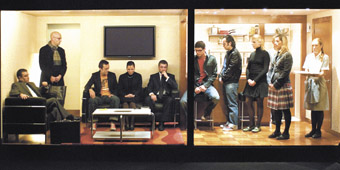
European House, Teatre Lliure
photo Ros Ribas
European House, Teatre Lliure
teatre lliure
Spanish company, Teatre Lliure presented European House, a contemporary reworking of Hamlet. All the main features are present, the death of the father, appearance of his ghost, seduction of the mother by the brother, a romantic liaison involving the young man. But the mise en scène is different—the drama unfolding simultaneously in an entire house opened up dolls-house style. There is no spoken text but each room is miked for sounds of urination, cooking, washing. We watch the family gathering after the funeral, ‘Hamlet’ taking a shower, the young people listening to music, the brother’s seduction of the new widow. Instead of Hamlet’s famous soliloquy, a message is flashed onscreen—”Choose to live and make changes or simply die in life”—a lesson in cultural critique instead of personal crisis.
This anatomy of bourgeois family life was shown but not spoken. Its presentation of modern-day funereal rites suggested very clear social rituals, which were set against improvised interactions between cast members. This made for a strange piece which was nonetheless compelling. Personally, I found the textual message didactic and simplistic, as if the lack of spoken text had to be compensated for. Instead of Hamlet’s questions, we are challenged from the anonymous vantage of the billboard. Are things that bad that we cannot bear to make our own interpretations without guidance from above? Maybe, maybe not—is that the question?
Melbourne International Arts Festival: The Temptation of St Anthony, direction, set, lighting design Robert Wilson, composer, librettist Bernice Johnson Reagon, State Theatre, Oct 11-14; Sankai Juku, Kagemi, Beyond the Metaphors of Mirrors, director, choreographer, designer Ushio Amagatsu, State Theatre, Oct 18-20; Merce Cunningham Dance Company, Program A, choreography Merce Cunningham, State Theatre, Oct 24-25; European House, Teatre Lliure, director Àlex Rigola, Playhouse, Oct 24-27; Victorian Arts Centre
RealTime issue #82 Dec-Jan 2007 pg. 10
© Philipa Rothfield; for permission to reproduce apply to realtime@realtimearts.net
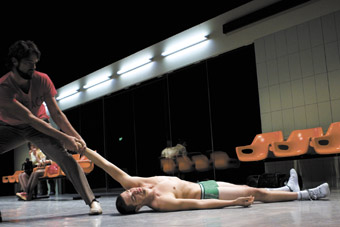
Guy Ryan, Matt Cornell, This Show Is About People
photo Stephen Oxenbury
Guy Ryan, Matt Cornell, This Show Is About People
JOHN BAILEY SEES AUSTRALIAN CHOREOGRAPHER SHAUN PARKER’S FIRST MAJOR WORK, THIS SHOW IS ABOUT PEOPLE, BARRIE KOSKY’S ADAPTATION FOR THE STAGE OF EDGAR ALLEN POE’S HORROR CLASSIC, THE TELL-TALE HEART PERFORMED BY AUSTRIAN ACTOR AND SINGER MARTIN NIEDERMAIR, PROVOCATIVE PARIS-BASED CHOREOGRAPHER JEROME BEL’S THE SHOW MUST GO ON, AND MELBOURNE’S MIXED ABILITY PERFORMING GROUP RAWCUS PRESENTING THEIR NEW WORK, HUNGER, IN COLLABORATION WITH THE MELBOURNE SYMPHONY ORCHESTRA.
shaun parker
Shaun Parker’s This Show is About People is a messy, incoherent furnace of competing forces. It is also entirely unique and utterly wonderful. It begins softly, a handful of ordinary-seeming people idling in a setting which could be a bus station waiting room, or an airport, or an underground bunker, or something other. But the moment a retiring man in vest and brown slacks suddenly bursts into an angelic medieval soprano and, somewhere else, a hulking boho-type begins dragging partially clad dancers from a vending machine, we know we’re in strange territory.
This aspect of the unexpected is what makes This Show such perfect arts festival fare. Throughout, its ability to provoke shock and wonder isn’t simply novelty for its own sake. It urges its audience to discover what exactly is happening here. Unlike much performance which revels in the play of ambiguity to hide an essential lack of meaning, This Show does promise something meaningful at its core—but you’ll have to work to find out what it is, and it’s likely that no two audience members will come away with the same conclusion.
Of course, the title gives a hint. But what about these people? There’s no narrative to the performance as such, which straddles contemporary dance (often heavily influenced by breakdancing with its floorwork, headspins and body rolls), spoken word, mime, theatre and more. The characters do maintain a certain consistency, but they’re not types—they’re fascinating assemblages of contradiction that develop in furtive, subtle ways, but are never pinned down in service of a grander function.
What does run throughout the piece, however, seems to be an interest in exploring the various ways people attempt to grapple with their own isolation in the universe. Philosophy and theology feature, as does war, work, art. A recurrent motif is the manipulation of one person by another—one dancer ‘paints’ another’s motion, for instance, her mimed brushstrokes mimicking a puppeteer’s control.
It doesn’t add up to any particular point, and even concepts such as war are injected with a giddy playfulness—mass combat played out by fingers engaging one another on the battlefield of a human body. At times beautiful and often gesturing toward the profound, This Show only stumbles during the occasional spoken section in which latent themes are rendered too starkly, losing their shimmering edge of transcendence by being addressed directly. At its best, it is during moments of silence or in the spaces between meanings that Parker’s work achieves the promise of something higher to which its subjects aspire.
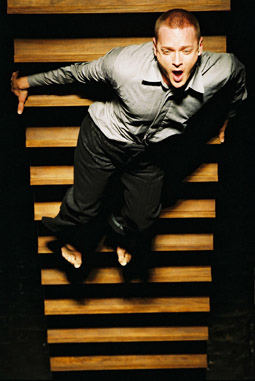
Martin Niedermair, The Tell Tale Heart
photo Nick Mangafas
Martin Niedermair, The Tell Tale Heart
barrie kosky
Silence also opens Barrie Kosky’s masterful new work, The Tell-Tale Heart. It begins before the deep red curtain is raised, the house lights dimming at an agonising, nearly imperceptible rate and leaving nothing but a heart-shaped after image disappearing from our retinas. It happens slowly, too slowly, but time, in this work, is of the essence.
Poe’s original story is a tiny one, all the more effective for its brevity. The strangeness of the narrator’s voice is sustained throughout, but by denying the reader a lengthier engagement with his fevered mind, the central question he puts to us—am I mad?—cannot be easily answered. Certainly, everything from his murderous admissions to his spurious motivations would seem on the face of it the rantings of a psychopath, but Poe does not provide a satisfactory and rounded portrait of a killer. Instead, he limits his reader’s understanding of this fractured consciousness by restricting our view of events to the first person.
The story is simple. A man recounts a murder he has committed and the (perhaps hallucinated) thudding heart—“such as a watch makes when enveloped in cotton”—that leads to his discovery. Kosky has admirably embraced the story’s deceptively uncanny effect in two ways—firstly by deliberately, and at times frustratingly, foregrounding time and duration as a crucial element in theatre. This is a theatre of ellipses, in which the unsaid holds as much weight as the spoken word. Kosky stretches the short text over more than an hour, but holds the attention with an iron grip by imbuing each pause with much freight.
Secondly, director and performer offer a counterpoint to the drama of a mental insularity through the extremes of the human body. The madness of The Tell-Tale Heart’s narrator is accented by his logic, his attempts to explain his actions by pouring them into the empty moulds of rhetoric and rationality. The absurdity of this process is emphasised through the corporeal hysteria of performer Martin Niedermair’s body. As he confesses his crimes in pleading and serious tones, his initially respectable figure—impeccably suited and clean-shaven—quickly becomes a mass of symptoms, a pyrotechnically neurotic body at odds with itself. In this respect alone, Niedermair’s performance makes for compelling viewing, his body soon drenched in perspiration, spittle and froth spraying intermittently, and blood—of course, blood—rising to fill his quivering cheeks.
The piece ends as it began, in darkness and silence, though the roar of an appreciative audience quickly dispels this final moment of contemplation. Audiences, in Melbourne at least, usually find a way to fill the void.
jerome bel
Jerome Bel’s contribution to this year’s festival, The Show Must Go On, saw a similarly uneasy attitude towards silence—at a crucial point, Simon and Garfunkel’s “The Sound of Silence” is played in darkness, but in keeping with the song’s lyrics is only heard during the chorus line that makes up its title. For the remainder of its duration, silence is all. Some audience members laugh, a few mutter to one another while others hush them loudly. Are we supposed to be silent? Why is this even happening?
We can’t look to Bel for answers, since he seems to have abdicated his role as creator. The work itself consists of a swag of popular songs, the chorus of each of which becomes a command for the 18 non-dancers who occasionally appear on stage. If there’s any actual choreography in play, it seems to be dictated by the songs themselves and interpreted by the performers alone. Bel even seems to clue us in on his unwillingness to take on the god-like role of artistic creator with the opening number from Hair, “Let the Sun Shine In.” But if there’s a god letting there be light here, he’s a retiring sort who rarely shows his hand again.
That so little actually occurs throughout the work’s running time seems important. The music is catchy and banal, from Queen to Edith Piaf, but each song provides only a single image, a punctum, and often offers nothing but a blank stage or a few bodies lying around. It is, for the most part, a show about negative space, about (I suppose) the vacuity of disposable popular music and the way untrained, spontaneous movement is as valid as the trained perfection of traditional choreography. But in so obviously refusing his audience an overarching authorial intent, Bel becomes a structuring absence, a choreographer who has simply made pedestrian, ordinary movement his thing.
This has done well to establish a fine reputation, and The Show Must Go On is certainly a lot of fun, but it doesn’t tread conceptual territory too distant from the blank canvases and silent scores of those working in other media half a century ago. If it does start a few audience scuffles, however, that might be something.
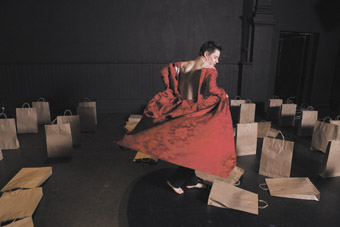
Paul Matley, Hunger, Rawcus
photo Brett Brogan
Paul Matley, Hunger, Rawcus
rawcus
In a few short years, Melbourne company rawcus has produced a small body of work of an outstanding quality which, for me, ranks among the most exciting of the moment. The company is composed of performers with and without disabilities and creates non-narrative works which explore the experiences of its members. The last work, Not Dead Yet, was an incredibly moving investigation of death and its effects on the lives of performers. Hunger turns the spotlight onto an equally rich topic, love, and while lacking the sublime effect of the previous work nonetheless contains moments of unforgettable power.
The new work was developed in collaboration with the Melbourne Symphony Orchestra, and features MSO musicians accompanying and frequently becoming a part of the action on stage. The music itself, by 19th century composers and Jethro Woodward, is gorgeous, but in conjunction with the performance becomes something more—a character itself.
Romantic imagery abounds, and much of the work plays with the tension between desire and the brute facts of life. For some this desire is to make a meaningful connection with another, for some it’s simply to be heard, and for others it’s hot sex or a caring boyfriend they’re longing for.
So far rawcus’ output has been small, but the company deserves far greater attention and support. Hunger, at least, is a festival event that could never be met by silence.
Melbourne International Arts Festival: This Show is About People, director, choreographer Shaun Parker, performers Anton, Matt Cornell, Marnie Palomares, Guy Ryan, Jarnie Birmingham, Tobias Coles, Sylvia Entcheva, Mara Kiek, Llew Kiek, musical directors Mara Kiek, Llew Kiek, designer Robert Cousins, sound design Peter Kennard, CUB Malthouse, Oct 11-14; The Tell-Tale Heart, director Barrie Kosky, performer Martin Niedermair, music played by Barrie Kosky, original music Barrie Kosky, dramaturgy Susanne Wolff, design Michael Zerz, Alfred Mayerhofer, set and costumes adapted by Anna Tregoan, lighting design adapted by Paul Jackson, Malthouse Theatre Workshop, Oct 10-20; The Show Must Go On, concept, direction Jérôme Bel, DJ Gilles, Gentner, Victorian Arts Centre, Oct 16-18; Hunger, devised by rawcus and the Melbourne Symphony Orchestra, director Kate Sulan, set & costume designer Emily Barrie, lighting Richard Vabre, sound designer Jethro Woodward, dramaturg Ingrid Voorendt, Arts house, Meat Market, Oct 22-24
RealTime issue #82 Dec-Jan 2007 pg. 8
© John Bailey; for permission to reproduce apply to realtime@realtimearts.net
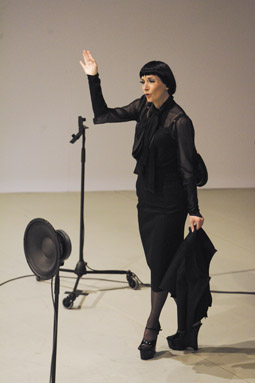
Joanna Dudley, The Scorpionfish
photo James Knowler
Joanna Dudley, The Scorpionfish
IT IS EASY TO FEEL UNEASY AT ALL TOO COMFORTABLE ENCOUNTERS WITH THE EXOTIC. THERE IS AN INDULGENT AIR OF LASSITUDE ABOUT THE ARMCHAIR TRAVELLER OF COLONIAL TIMES OR THE COLLECTOR OF OBJETS D’ART FROM FOREIGN PARTS. THEIR EXOTIC TASTES AND PLEASURES TAKEN NOW SEEM INSUPPORTABLE. THESE DAYS WE PREFER MORE ACTIVE, MORE ENGAGED ENCOUNTERS WITH THE UNFAMILIAR AND REMOTE. WE FAVOUR FULL IMMERSION OVER CONTEMPLATION FROM A DISTANCE.
Consider the allure of do-it-yourself backpacking, with its promise of cultural encounters and its marketing of culture shock. Such authenticity of immersion is denied those who prefer their holidays pre-packaged and their encounters mediated through the windows of a bus. But if in the future opportunities for excursions into foreign lands or the wilderness are to contract, we may come to value more acutely the exotic species in our own gardens, aquariums and zoos—and in those performances which extend an invitation to imaginatively encounter what lies beyond the horizons of the known. Indeed, theatrical performance excels at enabling encounters with the exotic, the unusual, the unfamiliar and the strange in humans and their cultures, and it does so under resource restricted conditions with relative comfort, easy access and minimal distress.
In many respects, this was the invitation of the OzAsia festival, the Adelaide Festival Centre’s inaugural celebration of culture and performance from Asia, Australia and Asian-Australia. OzAsia extended an invitation to encounter cultural difference, and it did so with the promise that we may recognise our own culture anew. However, global flows of culture and performance have created such convoluted mixtures of the familiar and the strange as to confound our certainties.
the scorpionfish
Kroncong, for example, is a kind of pop music from Java. It provides some of the musical score for The Scorpionfish, a piece of music theatre from Joanna Dudley and Rufus Didwiszus which had its premiere performance in Berlin in January. The rhythms, harmonies and instrumentation of kroncong are familiar enough to western ears. Historically, they are derived from fado, the songs sung by the Portuguese who established trading posts in eastern Indonesia in the 16th century.
But Kroncong is a hybrid style of music, a blend of European and Javanese, with a complex social history. Once the preserve of Jakarta’s urban poor, it was adopted by the nationalists in the 1940s as the people’s music and it has remained in nostalgic favour among the Sukarno generation, though younger people came to regard its nationalist associations with suspicion.
In Dudley and Didwiszus’s performance, however, kroncong is radically decontextualised. Its vocal qualities and lyrics, in particular, are thoroughly estranged from time and place. The work’s title is borrowed from Nicolas Bouvier’s book of travels in Sri Lanka. The subtitle, ‘Song and Dance in Tropical Downtown’, is geographically generic. The set–three white walls, white floor, no doors–is stark and post-dramatic.
Dudley, an Anglo-Australian performer originally from Adelaide, transforms herself into the Scorpionfish. An exotic creature from the abstract East, she lives in a tropical aquarium of urban oriental sounds emitted from ominous black speaker cones on stands. The soundscape is impressive: chirping frogs, rain and radio static, gamelan gongs and bird song.
Dudley performs solo, singing and dancing with nervously compelling diva poise. Her costumes form a minimalist suite of Eurasian femmes-fatale: from business style to geometric geisha, cabaret lingerie to Mandarin nightclub. Her European affectation of Asiatic grace is sustained to curtain call. The performance is executed with inscrutable precision, its tone is cute at times, even seductive, but always calculated and sometimes cold.
The Scorpionfish is a performance in the grand orientalist tradition. From the modernists (Craig, Yeats, Brecht and Artaud) to the interculturalists (Grotowski, Barba, Brook and Wilson), western artists have long sought inspiration for stylistic innovation in the performance traditions of Asia. Dudley’s cultural capital as a western artist enabled her to study song and dance in Java. It led to her “becoming embraced as a pop icon in the city of Surakarta”, according to the program.
Yet in The Scorpionfish, Dudley detaches kroncong from its cultural moorings in bodies, time and place. She redeploys it within a European context predetermined by the post-dramatic. In this decontextualising move, The Scorpionfish rendered apparent a latent orientalism propelling interest in OzAsia. I wondered if this work would find an audience in Java.
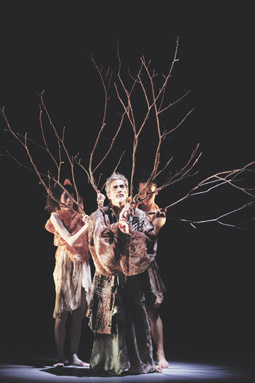
Leigh Warren & Dancers, Wanderlust
photo Hiroyasu Daid
Leigh Warren & Dancers, Wanderlust
wanderlust
Wanderlust, a collaboration between Leigh Warren & Dancers and Japanese dancer and choreographer Uno Man, transcends the orientalist attitude. It had its premiere in Japan in October 2006. Participating in that rich and well supported flow of people, culture and performance between Australia and Japan, Wanderlust followed a different path in search of encounters with the strange.
The work is inspired by the celebrated poetry of Matsuo Basho (1644-1694) who cultivated his haiku through an aesthetic practice of attentive wandering. According to philosopher Thomas Heyd, Basho found it difficult to write poetry “while remaining in one place for very long.” Basho’s wandering aimed to estrange him from the familiar and the known. This experience of estrangement he would deploy in poetry to apprehend the nature of the world anew.
Wanderlust is structured like the memory of a journey. It recalls not every step but scenes along the way. The opening scene, ‘Prelude/First Step’, consists of little more than dancers walking, fading in and out of view. From there the scenes unfold. Creatures are encountered as environments are traversed: Cicada, Stone Woman, Boy’s Day/Carp, Small Islands, Paddy Field, Deer and Forest, Waterfall, Hermitage Lantern and Battle Plain.
Alongside Uno Man, the dancers are Deon Hastie and Jo Roads from Australia, Mako Kawano and Tomohiko Tsujimoto from Japan. The choreography is supple, light and precise, rippling from the core to distal joints and arriving at positions with finely tuned decelerations. At times I feel they dance like birds with hollow bones. But where the pleasure of the work emerges is within the choreographic articulation of the environments.
According to Leigh Warren, the developmental process was unusual. Having analysed the dramaturgy of Basho’s texts, they first created environments of light, space and projection, before choreographing the work. The projected animations from visual designer Tetsutoshi Tabata are extraordinarily beautiful. Simple shapes in plain colours are softly projected onto diaphanous screens amongst which dancers move.
As the scenes unfold, the visual effect is dream-like and elusive. Like a journey, it is utterly compelling in the present, yet difficult to remember as a whole. In the final scene, Moon/Last Breath, Uno Man dances with the exhaustion of old age, but also with the sense of an arrival somewhere other than home.
dis-oriental
Yumi Umiumare’s 20-minute solo work, Dis-Oriental, is also motivated by an experience of estrangement, as attended in the work of Japanese architect Shigeru Ban whose emergency houses built from cardboard tubes address the need for comfort when disasters reduce homes to smoking piles of rubble and the familiar is rendered strange.
Toilet rolls, odd shoes and clothes, a book, a birdhouse and a balloon are the objects which Umiumare plays with and displays in this manic meditation on the necessity of comfort and self-care under conditions of estranged duress. Living well among the unfamiliar is a survival strategy for our time.
The Scorpionfish—Song and Dance in Tropical Downtown, created & performed by Joanna Dudley, creation & scenography Rufus Didwiszus, costumes Bernd Skodzig, choreography Nicola Mascia, sound design Dirk Dresselhaus, Space Theatre, Oct 1-2; Wanderlust by Leigh Warren & Dancers in association with Uno Man, direction, choreography Uno Man, Leigh Warren, dancers Uno Man, Mako Kawano, Tomohiko Tsujimoto, Jo Roads, Deon Hastie, visual design, screen media Tetsutoshi Tabata, composer Stuart Day, lighting Nic Mollison, costumes India Flint, Dunstan Playhouse, Oct 3-6; Dis-Oriental, choreographer, performer Yumi Umiumare, sound design Cat Hope, lighting Richard Vabre, Space Theatre, Adelaide Festival Centre, Sept 28-29; OzAsia Festival 2007: for full program see www.ozasiafestival.com.au
RealTime issue #82 Dec-Jan 2007 pg. 13
© Jonathan Bollen; for permission to reproduce apply to realtime@realtimearts.net
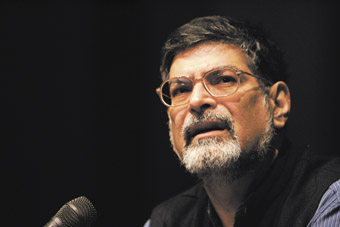
Rustom Bharucha
photo James Knowler
Rustom Bharucha
WHEN A NEW FESTIVAL SPRINGS INTO BEING, IT NEEDS TO DO SOME GROUND-CLEARING TO JUSTIFY ITS EXISTENCE. WHEN THAT FESTIVAL IS ONE DEVOTED TO THE CULTURAL CONNECTIONS BETWEEN AUSTRALIA AND ASIA IN A CITY AS TRADITIONALLY ANGLOCENTRIC AS ADELAIDE, YOU NEED TO ROLL UP YOUR SLEEVES BECAUSE THERE’S SOME SERIOUS WORK TO BE DONE. IT WAS IN THIS SPIRIT THAT WE HUNKERED DOWN TO A TWO-DAY SYMPOSIUM TO LAUNCH THE OZASIA FESTIVAL WHICH DOUGLAS GAUTIER, THE HEAD OF THE ADELAIDE FESTIVAL CENTRE, HOPES TO MAKE AN ANNUAL ADDITION TO HIS CITY’S CULTURAL LANDSCAPE.
Asia and Australia are both complicated places and a variety of issues must be considered when speaking of the possible connections between them: the economic and political contexts; questions of intercultural communication; the multicultural politics of Asian communities in Australia with the tricky business of hyphenated identities; and then the pragmatic stuff about how to turn all of this into a living for working artists. With such a disparate array of terrains in front of us, and with the desire to invite as many voices as possible into these debates, the challenge was for the participants to find points of common interest so that they didn’t simply talk past each other.
Bob Hawke’s opening keynote set up a range of ideas against which several subsequent speakers tried to define their positions. After a brief historical outline (ALP=Asia as opportunity=good; conservatives=Asia as threat=bad) Hawke based his argument on the primacy of economic and trade ties. His argued that Asia—read primarily as China—is increasingly important to Australia’s economic base and implied that the arts should be along for the ride in the superstructure. And besides, the takeaway food here was hell prior to Asian influence.
The challenges flung down were several: is there a justification for intercultural artistic practice that isn’t premised on placing art in the margins of economic life, and is the quality of the pad thai all there is to multiculturalism—an increased sense of cosmopolitanism for skippies to enjoy while they watch the footy on telly?
Penny Wong, Labor Senator from South Australia, showed scant respect for party elders as she rose to this bait, criticising the reduction of Asian influence to marginalised exotica within Australian culture. She pointed out that the central question is not so much the economic possibilities for Australia in Asia, but rather the ways that Asia is within Australia and not something external to it.
This way lies that most nebulous of territories, cultural identity. This is one of those large and comfortably amorphous terms which looks good on the menu but which usually leaves you hungry again pretty quickly. Send in the cultural theorists—or in this case, our second keynote speaker, Rustom Bharucha.
Bharucha, described in the program as a “leading practitioner and theorist of interculturalism,” led off the second day of the symposium with an abstract, yet immensely engaging talk (no easy combination), which considered the general issues on the table, and more specifically, his experiences with the National Cultural Diversity Cluster established in the Australian Performance Laboratory at Flinders University.
He pointed out that, from his position in India, he saw the category of Asia as a construction, in many ways imposed externally. Given the variety of identity positions through which we can all define ourselves, “Asia” is a fairly general one in relation to more immediate options such as nation, gender, class or profession. While Asianness can function as a form of western orientalism, it can also be invoked strategically from within Asia, though Bharucha had stern words for the ways in which this has been used as a pretext for state determinism, as in the case of Singapore.
Bharucha ended with a cogent analysis of Australian cultural policies in the Asia-Pacific, contrasting the Australian government’s increasing interest in expanding markets within the region with its populist cultural xenophobia on the home front. While many of the speakers couched their calls for increased cultural outwardness in the language of multiculturalism, Bharucha adopted a more critical approach to this rather vexed term, noting that mythicising ethnic origin was less important than other everyday negotiations. He criticised the construction of the national based on past traditions, and sought to replace it with a more complex (his favourite word) sense of the nation as an ongoing activity, the sum total of actions taken in the public sphere aimed at greater inclusivity.
The political analysis offered here lingered like a slightly bad smell over much of the symposium. Lachlan Strahan of the Department of Foreign Affairs and Trade noted that his department funds artistic activity as a form of cultural diplomacy in order to project an image of Australia “as a tolerant, innovative country.” This sat uneasily with the obvious fact that most people interested in exploring the cultural relations between Australia and Asian countries are frequently predisposed towards criticism of current Australian government policy. As much as cultural exchange eludes the control of governments, there is no escaping the way that the mechanisms through which working artists explore these more diffuse connections are intimately connected to the purse strings of foreign governments (those of China and Indonesia) and alien governments (those of John Howard and Alexander Downer).
If the initial fault line under analysis was the difference between Australia and Asia, other more immediate fissures were quick to appear. Primary among these was the problem of intersection between theoretical discourse and artistic practice. Bharucha’s keynote talk was followed by a panel discussion by the artists who had residencies at Flinders Cluster (and whose work, by the way, formed a hefty chunk of the OzAsia program.)
Artists as wildly different as monologist-photographer William Yang, violinist-stand up comic Hung Le and visual artist Hossein Valamanesh were asked to speak briefly on how they defined culture. The fragmentary and rather embarrassed responses pointed to the problems of practising artists being asked to reflect upon such abstract generalities, when what they normally do is something quite tangibly specific that doesn’t require such self-conscious abstractions.
If Bharucha’s favourite term was complexity, the value of many artists is that they can convert the complexities of the world into small chunks of insightful simplicity by filtering them through their craft. Woyciech Pisarek and Yumi Umiumare wanted to tell stories about how, unbeknownst to them, living in Australia imprinted a new culture on their bodies because, now when they return to their countries of birth, they physically experience themselves as foreigners in these defamiliarised lands. Others, such as playwright John Romeril and theatre entrepreneur Michiko Aoki, attempted to explain the connections across cultures as a matter of lived experience by narrating their own experiences as nothing more mysterious than going to new lands and showing an interest in what they saw there.
OzAsia 2007 raised a host of related issues in an unruly way—which is perhaps the best start you can hope for. Cultural debates only cohere easily in the hands of ideologues. If nations are about the way people imagine themselves and others, art clearly has a role to play in affecting those imaginings. But both art and nation states involve everyday actions as well as simply imagining. As the OzAsia festival gets people to think about the connections they have, and might have, to Asia, this will involve looking inward as well as outward, at abstract beliefs and at everyday practices, at how art and the social world intersect in constantly changing ways.
OzAsia Festival 2007, Cultural Symposium, OzAsia—The Big Ideas, Space Theatre, Adelaide Festival Centre, Adelaide, Sept 22-23
RealTime issue #82 Dec-Jan 2007 pg. 12
© Mike Walsh; for permission to reproduce apply to realtime@realtimearts.net
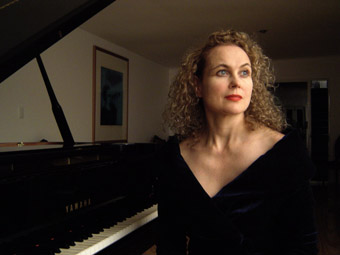
Gabriella Smart
photo Mark
Gabriella Smart
THE OZASIA FESTIVAL, BRAINCHILD OF ADELAIDE FESTIVAL CENTRE CEO DOUGLAS GAUTIER, IS A GREAT NEW ADDITION TO ADELAIDE’S CULTURAL CALENDAR; ONE CAN ONLY WONDER WHY IT HASN’T HAPPENED BEFORE. WHITE SHADOW, A CONCERT OF EAST ASIAN CONTEMPORARY MUSIC WITH A STRONG CHINESE REPRESENTATION, WAS AN OUTSTANDING EVENT IN THE FESTIVAL PROGRAM. PIANIST GABRIELLA SMART WAS BOTH THE CURATOR AND A VITAL PLAYER IN WHITE SHADOW, WHICH BROUGHT TOGETHER SOME OF THE COUNTRY’S BEST CONTEMPORARY PERFORMERS—VIOLINISTS NATSUKO YOSHIMOTO AND JAMES CUDDEFORD, PERCUSSIONISTS CLAIRE EDWARDES, VANESSA TOMLINSON AND PAUL LIN, AND OBOIST SEUNG-EUN LEE.
The story of the engagement of China with Western classical music is long, complex and fascinating. For nearly a century it has been a battlefield on which sometimes violent ideological conflicts have been conducted. It is a story of individual heroism and cowardice, of bureaucratic intrigue and political oppression, of tragedy and farce; great material indeed for a novel yet to be written.
The wholesale repression of Western music during the Cultural Revolution is a distant memory. The millions of young Chinese now studying the piano or the violin—more, it is said, than the entire population of Australia—were not even born then. But the ideological battles of the past cast a long shadow. The apparently insatiable appetite of the Chinese for bourgeois European music of the 19th century has not led to a corresponding interest in the music of its own composers, who have assimilated the techniques of the Western avant garde.
It is significant that the Chinese composer best known in the West today is Tan Dun, who settled in the United States and made his reputation there. Tan Dun was a celebrity in the West before he became well known in China. There is a parallel here to the Western fascination with contemporary Chinese art; it is primarily Western collectors paying big money for works by Chinese artists who are on the fringes of their own society. Tan Dun’s C-A-G-E (Fingering for Piano) is a tribute to John Cage, a composer whose fascination with chance procedures and the ancient classic I Ching could be expected to appeal to Chinese musicians, just as his reasoned espousal of anarchism would be anathema to the Chinese authorities. It was considerate of John Cage to be born with a surname of pronounced pentatonic character, allowing Tan Dun to use the letters of his name in a composition that alludes equally to Cage’s own innovative treatment of the piano, and to techniques of playing the pi’pa. It was superbly interpreted by Gabriella Smart.
Guo Wenjing creates an engaging piece of choreography in Parade, a work performed by three percussionists standing around a table on which are arrayed a collection of Chinese cymbals. It’s quite a tour-de-force for the players as they weave in and out of the narrowly constrained performance space; on this occasion a music stand prevented most of the audience from seeing exactly what was going on. Fortunately the work is as intriguing to the ear as it is to the eye.
The largest work on the program was Flavour of Bashu by Jia Daqun, which required the combined forces of two violinists, three percussionists and pianist. The title alludes to the province of Sichuan, famous for spicy food, the rapidly disappearing scenery of the Three Gorges, and its own unique brand of traditional opera. The latter two of these three themes are directly alluded to in the music—and if food is not specifically mentioned, that can only be because it is the ever-present subtext for all Chinese culture. This was an exciting performance, in which one could sense that the performers were taking risks in order to convey the vitality and intensity of the composer’s vision. James Cuddeford and Natsuko Yoshimoto were particularly effective in their use of portamento and microtonal intonation to convey the uniquely Chinese flavour of their parts. The percussion parts are full of colour, including the obligatory cymbal crashes with their distinctive pitch-bending character, while the piano seems to fulfil a continuo role in holding it all together.
The remainder of the program included Toru Takemitsu’s Rocking Mirror Daybreak, a series of four connected pieces for two violins—played by Cuddeford and Yoshimoto—which, in contrast to the highly coloured music around it, was a model of monochromatic restraint and a haven of tranquillity. It was certainly far removed from the convulsive gestures of White Shadow by Korean composer In-Sun Cho, who has thoroughly imbibed the language of the Central European avant-garde. This thorny piece, bristling with multiphonics and sudden, violent disruptions, was played with conviction and intensity by Seung-Eun Lee and Gabriella Smart.
OzAsia Festival: Soundstream Contemporary Music Ensemble, White Shadow, piano Gabriella Smart, violins Natsuko Yoshimoto, James Cuddeford, percussion Claire Edwardes, Vanessa Tomlinson, Paul Lin, oboe Seung-Eun Lee, Dunstan Playhouse, Adelaide Festival Centre, Sept 25
RealTime issue #82 Dec-Jan 2007 pg. 14
© Stephen Whittington; for permission to reproduce apply to realtime@realtimearts.net
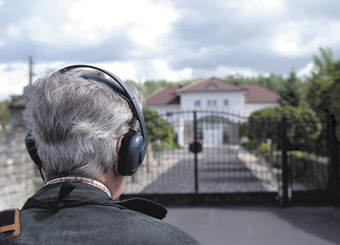
Audiowalk Gusen, The Invisible Camp
photo Christoph Mayer chm
Audiowalk Gusen, The Invisible Camp
THE OLD MAN IS QUIETLY PRUNING HIS ROSE BUSH BEHIND THE HEDGE AS THE VOICE IN MY HEADPHONES ASKS ME TO LOOK AT THE THREE STEPS THAT LEAD TO THE ENTRANCE OF THIS QUIET SUBURBAN DWELLING. IT WAS THROUGH THIS DOOR 60 YEARS AGO THAT SS OFFICERS FILED TO SEEK ‘COMFORT’ WITH FEMALE PRISONERS FORCED INTO PROSTITUTION. THE MALE VOICE CONTINUES WITH A DESCRIPTION OF HOW AFTER THE WAR, HE REMODELLED THE HOUSE, DEMOLISHING THE TWO METRE WIDE WOODEN CUBICLES TO MAKE DOMESTIC ROOMS. I LOOK AT THE OLD MAN PRUNING THE ROSES BUT HE DOESN’T RETURN MY GAZE.
A female voice leads me around the corner into another quiet street; it was here she says, that an SS soldier halted her during a visit to the camp dental clinic. While she waited, two men threw hessian sacks from a truck, dashing them against the wall exactly where I am now standing; the sacks contained children. When the woman was allowed to continue she saw the roadway was covered in blood.
I pass Spiegelplatzstrasse (playground street) walking past gaggles of happy, healthy kids, riding BMX bikes and drawing hopscotch grids in chalk. I am beginning to feel very uncomfortable and uncertain whether I should be nodding a greeting to the suburban housewives walking past with their baby strollers—they know what I am listening to, even though, as the work’s author later told me, no-one in the community has chosen to experience “The Invisible Camp.” This is an Ars Electronica project, and I am taking an audio tour through a small village built on the site of Gusen I and II, the most notorious forced labour camps of the Third Reich. Here 37,000 political prisoners were worked to death building the underground bunkers that housed the Messerschmitt Jet bomber factory. More powerful and disturbing than any filmed documentary, the juxtaposition of memory with the barely perceptible architectural traces of the camp that remain in this sleepy suburb of happy residents is chilling.
sous les pavés, la plage!
As they used to say in Paris ’68 (and may yet say again in Sarkoland), “beneath the street, the beach.” The Ars Electronica festival theme, Goodbye Privacy, was symbolised by images of a beach, more specifically Bondi Beach, which furnished the metaphor for a public space in which people choose to display, or rather expose, a good deal of themselves while maintaining a robust sense of individuality. Linz took the metaphor a step further, by physically constructing a sandy beach in Pfarrplatz (not a credible threat to Bondi!) and equipping it with a DJ kiosk, beach chairs et al. Unfortunately, chill was what this chill-out space did best, as the weather was worse than nasty and the opening took place in a covered courtyard of the nearby Kunst Universität where director Gerfried Stocker’s wistful remarks touched more than once upon topless Australian sunbathers!
At the Gala event at the Brüknerhaus, Australians had the front row seats and all the Austrian VIPs on stage had Second Life avatars floating behind them as they presented their speeches and awarded the Golden Nicas (Oscars with wings but no heads or arms) to the lucky winners. The obvious joke circulating among the winning SymbioticA crew from Australia was how we might grow the missing body parts back!
club med
The Second Life sub-theme manifested in the physical domain as an entire street of converted shops and restaurants, reminiscent of a Philip K Dick scenario—replete with an ex-Chinese restaurant, closed down for serving dog food, re-opened as a cyber-bar serving schnapps—and maybe dog food? Justine Cooper (Aus/US) set up shop (sic) peddling an almost believable parody [apparently believed by disappointed Americans according to recent press reports. Eds] of a Yuppie drug HAVIDOL™, a promise of effortless Gain and no Pain. Cloying American sales voices and spray-on smiles coax punters toward arrays of Baby Blue merchandise—actually the shiny blue pills in the large jars turned out to be a very tasty malted chocolate (at least I hope that’s what they were as I ate handfuls of them!). Reality hybridising with fantasy and fiction creeping into real life, I am even more convinced that Second Life is Club Med populated by Ken and Barbie dolls sporting repulsive jewellery, who in reality are accountants and dental receptionists. Anyhow, there is more than enough to keep most of us busy in Life No.1!
alternative interaction models
Ars Electronica encapsulates the broadest spectrum of ‘new media’ in both name and as an event, implying an embrace, for example, of the earliest experiments in electronic music or kinetic sculpture through to contemporary activist art and current commercial digital animation. Such a broad historical and thematic horizon makes Ars Electronica a robust event with a high degree of integrity and the capacity to be critically self-reflexive.
It is this breadth of vision, which permits the inclusion of the Conservation of Intimacy, a major installation of whimsical human-powered wooden kinetic sculptures by Bernie Lubell (USA). These anarchic Heath Robinson-style inventions, inspired by the 19th century physiological experiments of Etienne Jules Marey, demand a high level of direct physical engagement in order to activate pneumatic pumps that operate the work. Lubell’s oeuvre seems to originate from an era before electricity, let alone computers, and they playfully invert the slick, the polished and the super-cool auras that frequently plague new media practice (and practitioners).
Ashok Sukumaran (India), awarded the Golden Nica in the Interactive category for Park View Hotel, shares Lubell’s irreverence by establishing quite simple interactive relationships that allow the possibility of dysfunction; users can jam, upset and deny the system. Perhaps forms of interaction which are antagonistic, broken or refused are more realistic modes than those complicit ones implied in nearly all forms of new media arts. In general, most cultural forms propose interactive relationships that are ‘composed’ within hermetic worlds, not substantially different from the rules of Monopoly, and we all know how boring that is!
Another Award of Distinction in the Interactive category was pulled by Leon Cmielewski and Josephine Starrs (Aus) for their elegant work Seeker (RT78, p26) which, in the process of mapping one’s personal geospatial history, allows the interactor to access layers of data relating to global resource conflicts and associated human displacement. The highly resolved graphical display and beautiful panoramic landscape imagery belies the implied violence that the data visualisation represents; likewise I found the authors’ claim (made during the conference) that the work was non-political to be somewhat disingenuous. There is a Bermuda Triangle bounded on one side by subtle work that elicits a genuine ideological or political response, flanked on the second by old fashioned in-your-face agit-prop and, on the third, by work that simply aestheticises pain and disaster—only one of these strategies has integrity.
growing hybrids, selling shit
Ars Electronica inaugurated a new Hybrid category this year, noting a shift in the interests of new media artists beyond information technologies and computer networks towards the areas of materials technologies—biological, chemical, mechanical and (watch this space) nano-technology. Rather than simply working with the vectors of transmission and transformation of data, artists are now engaging with these others as material manifestations. The emphasis on hybridisation of forms and concomitant interdependencies and cultural mixing reformulates the easily jaded term ‘new media’, steering it away from the digital ghetto.
In this context, it is fitting that the inaugural Hybrid Golden Nica should be awarded to the work of the SymbioticA Laboratory, which is a paradigm of a collective, inter-disciplinary and hybrid practice. The Lab has recently become a “Centre” in the University of Western Australia and has initiated a Masters Degree in Biological Art, both developments attesting to the unique and vital opportunities SymbioticA offers and the high regard UWA has for its work.
The SymbioticA exhibition for Ars Electronica comprised five works, curated to demonstrate the wide scope of the work undertaken in the Lab. They included a DNA fingerprinting performance by Paul Vanouse (USA); a video projection work with a maze-like screen manufactured from collagen extracted from rats’ tails by Boo Chapple; an exquisite dress coloured by fungal material created by Donna Franklin; a live tissue culture work by Oron Catts and Ionat Zurr (aka Tissue Culture and Art) and a double data projection installation about sex, which included a (captive) audience of hundreds of crickets (by yours truly).
An unpleasant odour drifts down the corridor. Cloaco, by Belgian artist Wim Devoy, duplicates the human digestive tract, something Vaucanson attempted with his famous Canard Digérateur automata (The Digesting Duck, 1738), which the inventor falsely claimed could eat and shit. However, Cloaco really does the business as it mulches through several gourmet meals a day, but like all automata, it invokes the hubris of breaking the taboo of creating life. But I guess here we are only contemplating the rear end of creation and its manna from heaven. A secondary layer of critique connects the cycles of conspicuous consumption and attendant conspicuous waste directly to the controlling mechanism of Global Capital. Devoy has managed to register Cloaco Ltd on the Belgian stock exchange (using 100 Kilos of shit as equity) and now trades shit on the open market. Well, as they used to say in the old country, “Where there’s muck, there’s brass!”
Festival Ars Electronica 2007, Goodbye Privacy, Linz, Austria, Sept 5-11, www.aec.at/en/festival2007
RealTime issue #82 Dec-Jan 2007 pg. 15
© Nigel Helyer; for permission to reproduce apply to realtime@realtimearts.net
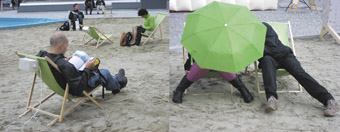
Pfarrplatz Lido (Second Life/Bondi Beach) – Ars Electronica Futurela
photo Somaya Langley
Pfarrplatz Lido (Second Life/Bondi Beach) – Ars Electronica Futurela
AN AUSTRALIAN MEDIA ARTIST ONCE TOLD ME TO BE CAUTIOUS WHEN NAMING AN ARTWORK AS THE VERY TITLE HAS THE POTENTIAL TO BRING FORTH ITS ESSENCE INTO EXISTENCE. I WAS REMINDED OF THIS CONVERSATION WHEN ARRIVING IN LINZ IN THE MIDST OF A HEAVY AFTERNOON DOWNPOUR WITH THE KNOWLEDGE THAT ONE OF THE SCHEDULED WORKS IN THIS YEAR’S ARS ELECTRONICA WAS AN EXCERPT FROM PETER WILLIAM HOLDEN’S AUTOGENE—UMBRELLAS SYNCHRONISED TO THE SOUNDS OF “SINGIN’ IN THE RAIN.” WHILE SINGING MIGHT NOT HAVE BEEN THE ACTIVITY OF CHOICE, ONE THAT QUICKLY CAPTURED ATTENTION OF MANY WAS THE OPPORTUNITY TO COMBAT THE COLD TEMPERATURES.
pfarrplatz lido
The drinking of hot punch at an artificial beach constructed by the Ars Electronica Futurelab in the likeness of Sydney’s Bondi Beach was a profoundly semi-virtual world experience. Over the first cup, we tried to comprehend the relationship between this patch of sand in Pfarrplatz and its apparent association with Second Life. While a comment about “Second Life invading my first” was bandied around, it was only during consecutive visits to this gathering place that the connections became obvious.
Protected, and therefore obscured, by white plastic tubs were laptops where individuals could log into Second Life, situated in the virtual equivalent of the Pfarrplatz beach, and ‘talk’ (in conventional SL style) with real-world participants. The twist was that that real-world participants were delivered the messages via computerised voices—some with particular idiosyncrasies, such as children screaming. Unfortunately, communication was unidirectional and real-world inhabitants had no way of replying apart from looking bewildered, annoyed or amused. Situated alongside the beach was a blow-up performance venue resembling a children’s jumping castle where a range of audiovisual acts performed, including Australia’s Botborg. Despite the weather, this location became a regular haunt for festival attendees. Who ever said that water, sand and technology don’t mix?
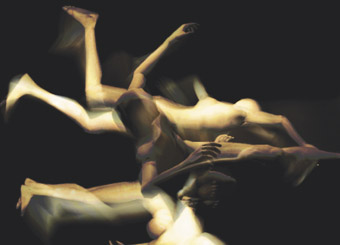
EED, Kurt Hentschläger
courtesy of the artist
EED, Kurt Hentschläger
feed
Kurt Hentschläger, an Austrian and long-time resident of the USA, re-staged FEED, originally commissioned for the 2005 Venice Biennale. The performance took place in an old underground bunker and, prior to admission, the sense of anticipation built as audience members were required to declare the state of their health. Anyone suffering from headaches, anxiety attacks, “anyone under the influence of medication for the treatment of depression” through to epilepsy, was to be excluded from attending if they did not sign a disclaimer.
FEED takes place in two parts, the first being an audiovisual experience in traditional surround-sound cinema mode. Animated clones float in space and at intervals jerk and twitch simultaneously. Without warning, smoke machines billow out clouds and in minutes the audience is engulfed in fog. I can’t see my hand inches from my nose and realise that now there is no way to back out. Sharp flickering patterns of interference and revolving coloured light emerge, evocative of a hallucinogenic experience and coupled with sound that vibrates not only your eardrums but your whole body. Hentschläger uses stroboscopic lighting accompanied by resonant drones so that his work “happens as much in your brain as in your eyes, and in the rest of your body”, adding that something initially scary can ultimately become peaceful and sublimely beautiful.
audiowalk gusen
Christoph Mayer chm’s AudioWalk Gusen, subtitled The Invisible Camp and created over a three-year period by a dozen-strong project team, far surpassed any expectations with its simplicity and elegance of construction. Technology was definitely not the focus, used only as the delivery tool, presenting previously unspoken and unheard accounts of numerous atrocities. Discussions with the creator on the way to the audio walk’s starting point gave no hint of what was to follow, or the very personal nature of the work. AudioWalk Gusen takes place on the former location of the Nazi concentration camps Gusen I and II.
A single iPod and set of headphones accompany you on the solo journey around the small town, allowing the past to emerge and become corporeal. Layers of present-day suburban tranquility are slowly peeled away to reveal a terrifying past. The juxtaposition of past and present climaxed for me when, listening to accounts of the mass graves located on a particular site, I saw a group of children with coloured chalk drawing an aerial view of a shopping centre in the middle of the asphalt road.
While the walk should have been straightforward, at one point tears obscured my ability to follow directions and, inevitably, I became lost. Existing in both the past and present became exceedingly difficult, given that I was rendered almost useless due to the intense nature of the work’s content. Careful construction of a woman’s narrative, a soundscape of noises of life inside and out of the camp grounds, and a sparse, minimal soundtrack were interwoven with testimonies from concentration camp survivors, past and current village members and former SS officers. Memories are forever imprinted upon these voices. One story impossible to forget is of a camp survivor’s childhood memory of witnessing other children, bound in sacks, thrown repeatedly against an apartment building wall until they were dead.
Two hours later I arrived at the endpoint as daylight was fading. AudioWalk Gusen continues to resonate with me—for weeks it entered my thoughts within minutes of waking up each morning. The work, available in an English translation, exists as an ongoing installation with the audio equipment available for hire from local restaurants nearby the Gusen Memorial.
post-immersion
Gusen Audiowalk and FEED each encourage my belief that embodied and immersive artworks are an incredibly powerful and very direct means of delivering concepts, of conveying the ‘other’s’ experience and developing empathy. Post-immersion, these artworks at Ars Electronica have significantly impacted on my daily life. This is how history should be learnt.
Festival Ars Electronica 2007, Goodbye Privacy, Linz, Austria, Sept 5-11,
www.aec.at/en/festival2007
RealTime issue #82 Dec-Jan 2007 pg. 16
© Somaya Langley; for permission to reproduce apply to realtime@realtimearts.net
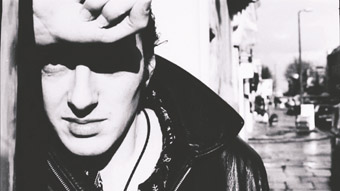
Strummer: The Future is Unwritten
courtesy Dendy Films
Strummer: The Future is Unwritten
PHILIP SEYMOUR HOFFMAN HAS SO MANY FACES AND VOICES THAT I’M CURIOUS TO FIND OUT WHAT HE LOOKS AND SOUNDS LIKE. THE ACIDIC WRITER TRUMAN IN CAPOTE (FOR WHICH HE WON AN OSCAR), THE HEAVY-BREATHER ALLEN IN HAPPINESS, THE LYRICAL JOURNO LESTER BANGS IN ALMOST FAMOUS AND, MY ALL-TIME FAVOURITE, THE TRY-HARD IN THE TOO-SMALL T-SHIRT, SCOTTY, DEFEATED BY THE POWER-PLAYERS IN BOOGIE NIGHTS. HOFFMAN IS IN SYDNEY TO DIRECT RIFLEMIND, ANDREW UPTON’S PLAY FOR THE SYDNEY THEATRE COMPANY. AT A RECENT Q+A BOTH HOFFMANN AND UPTON WERE ON STAGE DISCUSSING A MINI-FESTIVAL OF FILMS REVOLVING AROUND THE THEMES OF THE PLAY.
Hoffman takes the stage, scruffy and retiring; it’s hard not to position him as a character in exile, even now. He chooses to screen Round Midnight, Bertrand Tavernier’s sensual evocation of a jazz muso past his prime, battling alcoholism in a seedy hotel in Paris. He talks of directing his own ageing rockers in Riflemind (harnessing various circular character ‘needs’), about the difference between acting for the stage and screen (not much, just flexing different muscles). As Upton punctuates Hoffman’s silences with his own staccato style, the ghost of Cate Blanchett—Hoffman’s female equivalent in terms of taking on multi-faceted roles, and Upton’s wife—seems to hover offstage, directing from the wings.
I admit it. I bought a ticket to Riflemind because Hoffman was directing and Hugo Weaving was starring. I have struggled with theatre for many years. It doesn’t grab me like film does. Often as soon as the opening words are uttered I groan inwardly; if there’s a fake American accent, that’s it, I’m down for the count. If there’s a film connection I take the chance. And if there’s star power, I’m drawn in. Call me shallow. There’s something about being in the same physical space with a face you’ve seen up close for hours on the big screen. When I think about it, I’ve probably spent, adding up all his titles, 20 hours with Hoffman in an intimate space. Hugo Weaving, probably more.
riflemind
Riflemind is like The Big Chill for rock musos. An 80s band decides to think about re-forming (and reforming too), meeting in a mansion on the outskirts of a UK village, arriving by helicopter. It’s not Kevin Costner (yes, he played the corpse in the film) but there’s something dead in the water. Revolving around a simple set—a long benchtop kitchen and fridge, a couch near a stereo, a Mark Rothko painting—band members John (Hugo Weaving), Phil (the always charismatic Marton Csokas), Moon (Steve Rodgers), a young upstart from the States, Lee (Ewen Leslie—yep, there’s that ‘American’ accent), the band’s manager Sam (Jeremy Sims) and two girlfriends Cindy (the one with a history, Susie Porter) and Lynn (a new recruit but battling addictions of her own, Susan Prior), fire mis-timed missiles at each other.
In the Q+A with Hoffman, Upton was pretty harsh about Metallica (the subject of the 2004 documentary, Some Kind of Monster) and the band’s fans, talking in a derogatory way about their music being ‘crap’, and in the same way, he seems to despise his own characters. While we skim the surface of their despair, addictions and tenuous familial threads, we remain as disconnected as the lot of them. There’s some humour to relieve us (Jeremy Sims hams it up as a Rod Stewart-like pompous git and, damn, another fake accent) but you’ve got to wonder what Susie Porter saw in the role, other than I guess working with Hoffman. Cindy (shortened to ‘Cin’) goes from bleached to raw—yes, she’s sucked a lot of dick to get where she is, we get it. Vanilla ice layers of cliche, punctuated by the stub-stub-stubbing of cigarettes. Apart from Weaving’s opening monologue, a taut rhythmic tongue-play around the construction of a lyric, there’s no real sense of the music, beyond the occasional scene change effect of strobe-lighting with a rapid fire chunky guitar (Peter Black and Raymond Ahn from the Hard Ons) that makes my neighbour lean forward in her seat as if she’s been shot.
You don’t have to go much further than your local RSL to see real-life examples of these bands and we’re talking further back than the 80s. There’s a re-forming revolution going on. I used to cast scorn on my parents’ generation, queuing up for Countdown rerun concerts where even the band couldn’t get it together (see Katrina from Katrina and the Waves!), doing the stomp with knobbly knees to Eagle Rock (yep, those boys are back in town too, and on Sunrise). But then suddenly it was my teenage past that was coming back to haunt me at the Sydney Entertainment Centre. The Cure. Duran Duran. Psychedelic Furs. Hoodoo Gurus. Suddenly the past didn’t seem like that long ago, especially with current teenagers wearing the same clothes I did; bubble skirts and smock frocks were bad then and nothing’s changed. I knew I was heading down a slippery slope when I saw Violent Femmes at the Revesby Workers Club last year and stood on the perimeter of the dance floor with lots of bald, middle-aged accountants, screaming “day after day, I get angry, and I will say, that the day, is in my sight, when I’ll take a bow, and say goodnight.
film & rock
Filmmakers have also been riding the crest of this wave, fascinated with the idea of washed-up rockers giving it another go. The tour de force Some Kind of Monster—which Hoffman screened to his cast early in the rehearsal process—reveals the inner workings of a band, Metallica, who have reached their peak and are coming down the other side, the psychologising and gameplay that goes on to bring out a new album, and the strain to just keep on keeping on, battling 20-year-old habits and wives who expect more now they have children. The doco also deftly gets into the heads of the hangers-on, particularly the band’s somewhat delusional psychologist, who begins to see himself as an essential part of the band, unable to acknowledge his own co-dependency. Popular hits like Music and Lyrics, with Hugh Grant, and the Australian BoyTown, with Glenn Robbins and Mick Malloy, play with Riflemind’s themes in a comic way, making the most of bad 80s haircuts and worn-out dance routines.
strummer: the future is unwritten
The best of these films is Julien Temple’s passionate unearthing of an era in Strummer: The Future is Unwritten. This tender documentary has a cohesion often lacking in films where the protagonist is no longer with us. The film makes Joe Strummer breathe, in contrast to Riflemind, where the band is stifled and suffocating. At the Q+A, Upton said his play was influenced by Chekhovian rhythms, and yes, the characters seem trapped by their own inertia, their sense of ennui—but is that because Upton himself doesn’t quite know where to take them? Temple doesn’t have the same problem but of course he’s guided by the meandering narrative of a known musician who was frontman of The Clash. There are a million ways to approach the contradictory forces in Strummer’s life and he shapes the doco beautifully by interviewing family and friends, framed in front of a raging bonfire at night, the soft focus of flames encouraging spontaneous bursts of Clash songs. A radio broadcast—London Calling—acts as scaffolding, holding the narrative up, while it interweaves Strummer’s eclectic taste in music from around the globe with his captured archival history as a diplomat’s son in Iran, Malawi and Mexico.
What the doco manages, and where the play struggles, is to get into the complex yearnings of men who’ve had it all (fame, money, girls, drugs, success) and lost it. Temple has always been into punk. In the 70s he was one of the first to film the Sex Pistols and The Clash. He became a close friend of Strummer’s in the years before his death. In the film, over 25 years, Joe Strummer re-emerges in a series of identities, from rebel to hippie to punk back to hippie, shedding his slippery snake skin when it no longer fits. The band members in Riflemind seem trapped behind glass, like oddities in a museum with strap-on instruments, but then they are only captured at one moment in time. Perhaps the difference in what’s offered to the audience is that Temple comes to the subject as a passionate fan of the music first, while Upton seems more interested in what happens when the music dies.
Strummer: The Future is Unwritten, director Julien Temple, producer Amanda Temple, currently screening nationally, www.joestrummerthemovie.com
Riflemind, director Philip Seymour Hoffman, writer Andrew Upton, performers Marton Csokas, Ewen Leslie, Susie Porter, Susan Prior, Steve Rodgers, Jeremy Sims, Hugo Weaving, design Richard Roberts, lighting Damien Cooper, costumes Tess Schofield; Wharf 1, Sydney Theatre Company, Oct 5-Dec 10
RealTime issue #82 Dec-Jan 2007 pg. 17
© Kirsten Krauth; for permission to reproduce apply to realtime@realtimearts.net
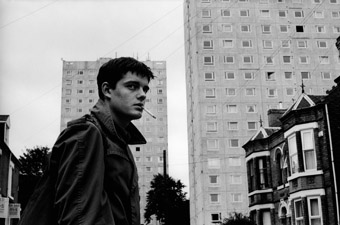
Control
courtesy Dendy Films
Control
IN 1980, ON THE EVE OF JOY DIVISION’S FIRST AMERICAN TOUR, SHORTLY BEFORE HIS 24TH BIRTHDAY, IAN CURTIS HANGED HIMSELF. ON A SMALL COMMEMORATIVE STONE—THAT ISN’T EASY TO FIND—IN MACCLESFIELD CEMETERY AND CREMATORIUM, IS WRITTEN “LOVE WILL TEAR US APART.” ALMOST THREE DECADES LATER, THE SINGER ATTRACTS INCREASING NUMBERS OF DEVOTEES, MANY OF THEM ARTISTS, INSPIRED BY THE SMALL BUT COMMANDING BODY OF WORK JOY DIVISION MADE AND THE INTENSE EMOTION CURTIS IMPARTED—A DESPONDENCY PERHAPS NEWLY RELEVANT IN OUR OWN TIME.
Dutch photographer Anton Corbijn—revered for his celebrity portraiture and award-winning film-clips, including Joy Division’s Atmosphere (1988)—was inspired to transform his practice and make his first feature film when offered the subject of Curtis, based on Touching from a Distance, a biographical account of the musician’s life written by his widow, Deborah. The crossover from still to moving image has taken Corbijn 30 years, but it seems appropriate that he waited to do it with Control. At a recent appearance at Melbourne’s Nova Cinema he told how he moved from The Netherlands to England in 1979 following the sounds of Joy Division, making a touching joke that he hasn’t washed his hands since he shook Curtis’. Photographing Joy Division in 1979 and 1980 was a personal and professional milestone in his life.
The transition from photography to filmmaking (or vice-versa) can be a logical progression, each medium an appendix of the other. Many artists work successfully across both media, for example Robert Frank, Wim Wenders and Larry Clark. Other contemporary artists narrow the divide even further; works by The Kingpins, Tracey Moffatt and Matthew Barney slide seamlessly between moving and still photography, not surprisingly given the high saleability of production stills as editioned works.
Working from his own and Deborah Curtis’ memories, Corbijn manages to capture the singer’s magnetism. From a mere hour of extant Joy Division footage, newcomer Sam Riley convincingly embodies Curtis, capturing the essence of his distinctive dance style. From portraying the band’s cocky, bold front man to the self-conscious epileptic, heavily dosed on medication (and alcohol), Riley’s performance is excellent. He reveals Curtis’ struggle to hold the disparate pieces of his life together, juggling a demanding tour schedule, a day job as a civil servant, a baby, a wife he married in his teens, and his feelings for the sophisticated-Belgian, Annik Honoré, with whom he fell in love.
Tormented and torn between moral obligation and the path to musical acclaim, on stage Riley’s Curtis completely surrenders to the music; off stage he fluctuates, naïve, sensitive and sincere, then cruel and selfish. Curtis incarnates the myth of the tortured artist, his tragic suicide fuelling the legend, yet Corbijn doesn’t exploit this—Curtis’ lack of control of his life is portrayed as less than romantic, as is the culture of the oppressive, post-industrial towns of Manchester and Macclesfield in the late 1970s. Corbijn’s decision to film in black and white heightens the sense of a relentlessly depressing England where the music scene in the pubs and clubs provided the only respite from cold, grey streets lined with cheerless council flats and offices. Corbijn explained that the medium perfectly captured the bleak atmosphere of the era, and exemplified Joy Division’s aesthetic—photographs of the band are virtually all monochrome (including Corbijn’s) as are their album covers (designed by Peter Saville).
Curtis and Joy Division have inspired more artists than Corbijn. Over a quarter of a century after Curtis’ tragic death, the band’s music has been covered by countless others. In fashion, Belgian-designer and curator Raf Simons designed men’s clothing and jewellery ranges based on Joy Division lyrics and album art. ‘Joy Division trainers’ have been designed for both Nike and New Balance (although neither as yet have gone into production). And, in visual art, there are many examples of the band’s influence.
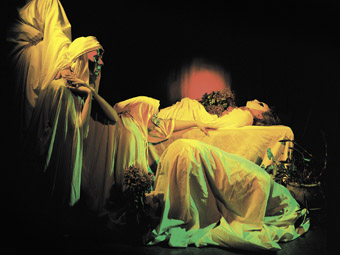
Darren Sylvester, No Fun, No More (2006)
courtesy of the artist
Darren Sylvester, No Fun, No More (2006)
In Australia, Melbourne-based artist Ronnie van Hout’s video I Remember Nothing (2004) appropriates the Joy Division song of the same name for its audio track. For the length of the song, a bewildered van Hout, in odd attire complete with mask, staggers blindly and senselessly through a grassy urban setting. Darren Sylvester’s No Fun, No More (2006), a restaged, colour version of Joy Division’s Closer album cover, was recently exhibited in Perfect for every occasion: photography today at Heide Museum of Modern Art. The accompanying catalogue reveals that Sylvester “wanted to return to a theme of that album, in which Ian Curtis was seemingly having no fun at all, to remind the viewer that sometimes nothing changes, by dragging the image closer to the modern age in lurid colour.”
In Melbourne, in 2003, the Centre for Contemporary Photography showed David Crawford’s Dance to the Radio—the chorus of Joy Division’s Transmission—three readymade music videos for Joy Division songs constructed from stock photos selected by keywords typed in by audience members. The same year, in Sydney, gallery WREN exhibited Dorothy Bona’s portrait of Curtis.
Internationally, Swiss artist Philippe Decrauzat’s Komakino (2006)—a Joy Division song title—is a wall decal (in black and white) inspired by the band. David Alker (UK) has made recreations of Joy Division album covers as part of his remade record collection series The Record Collections, while Glenn Brown (UK) has made paintings titled The Ever Popular Dead (painting for Ian Curtis) After Adolf Schaller and Ornamental Despair (Painting for Ian Curtis) After Chris Foss. The Museum of Contemporary Art in Chicago is currently showing Sympathy For The Devil: Art and Rock and Roll Since 1967, including Futurama (2004) by Scott King and Kevin Cummins—digital prints featuring portraits of Ian Curtis.
Slater Bradley (US) regularly pays homage to Joy Division, crediting Curtis in his catalogue acknowledgements and making work that includes paintings reproducing the band’s graphics; photographs of Bradley’s doppelganger, Benjamin Brock, posed as Curtis (with remarkable likeness in Bradley’s Doppelganger Trilogy, 2001-04); a video ‘recreating’ footage of Curtis (Brock) performing; and a project titled In a Lonely Place—one of Joy Division’s last songs, later recorded by New Order—in which Brock simply attends events (including exhibition openings) styled and dressed as Curtis.
The music and visual art crossover isn’t unusual, given that many visual artists are musicians and vice-versa, however the pervasiveness of Joy Division’s impact is significant. Reverberating across generations, the band’s music appears to have increasing relevance for contemporary audiences who recognise feelings of guilt and shame, of the despair that can come with falling in and out of love—as Sylvester rightly points out, “sometimes nothing changes.” Curtis’ lyrics are as compelling now as they were in the late 1970s.
Curtis’ legacy is just under 50 songs that are full of life: they are dark and oppressive, yet liberating and inspirational. They hold weight—his deep and haunting voice propelling the palpable despair at the heart of it. Cleverly, Corbijn uses Curtis’ lyrics for the singer’s thoughts throughout Control, which is the story of a private life—a revealing account of the man rather than the myth. Like the sounds of Joy Division, the film is genuinely moving, at times humorous, and heartbreaking, leaving us with a sense of longing for what might have been.
Control, director Anton Corbijn, screenwriter Matt Greenhalgh with Deborah Curtis, cinematography Martin Ruhe, John Watson, editor Andrew Hulme, music supervisor Ian Neil, score Joy Division, New Order, sound designer Peter Baldock. DVD release in Australia through Madman.
RealTime issue #82 Dec-Jan 2007 pg. 18
© Karra Rees; for permission to reproduce apply to realtime@realtimearts.net
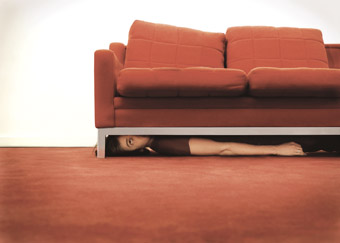
Hamish Michael in publicity still for Marius von Mayenburg’s Moving Target
photo Garth Oriander
Hamish Michael in publicity still for Marius von Mayenburg’s Moving Target
This edition of RealTime is, above all, musical. In a cluster of OnScreen articles you can read about the impact of vintage popular musics on artists working in film, theatre and installation. In our festival section, you’ll discover the potent music programming evident in the Sydney and Adelaide Festivals. Consonant with this, the issue of hybridity constantly rises to the surface of this edition—whether in expanded notions of media arts evident at Ars Electronica, Videobrasil and Zero One or in numerous individual artworks and performance festivals, like OzAsia. Cross- fertilisation, multilinearity and media convergences continue to yield emergent possibilities, not fixities. It’s a fecund time offering a creativity to counter the multitude of fundamentalisms that have beset us in recent decades. The Labor Party’s victory in the 2007 Australian federal government election and the prospect of the Senate becoming once again a house of review offer hope for a revival of the democratic impulse in our culture, for the promotion of empathy and active compassion. But let’s not think it’s going to be easy. Leonard Cohen writes in his Book of Longing (see page 5), “We are moving into a period of bewilderment, a curious moment in which people find light in the midst of despair, and vertigo at the summit of their hopes. It is a religious moment also, and here is the danger. People will want to obey the voice of Authority, and many strange constructs of what Authority is will arise in every mind. The family will appear again as the Foundation, much honoured, much praised, but those of us who have been pierced by other possibilities, we will merely go through the motions, albeit the motions of love. The public yearning for Order will invite many stubborn uncompromising persons to impose it. The sadness of the zoo will fall upon society” (Book of Longing, Penguin Books, 2007). We prefer to look forward, cautiously, to happier times, wish you good reading, a joyous holiday season and hope to share a richly creative 2008 with you. At least you don’t have to hide under the couch any more. Keith, Virginia & Gail
RealTime issue #82 Dec-Jan 2007 pg. 1
© RealTime ; for permission to reproduce apply to realtime@realtimearts.net
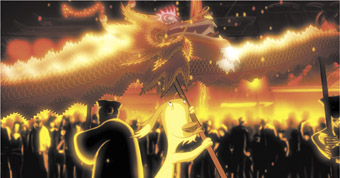
Sweet and Sour
CHINATOWNS HAVE LONG BEEN A KEY SITE OF CROSS-CULTURAL EXCHANGE IN AUSTRALIAN CITIES, SO IT’S APPROPRIATE THAT THE FIRST AUSTRALIA-CHINA ANIMATED CO-PRODUCTION TAKES AN IMAGINARY CHINATOWN AS ITS SETTING. BRINGING TOGETHER NEW TECHNOLOGY AND YOUTHFUL ANIMATORS WITH THE HAND-DRAWN WORK OF ONE OF THE WORLD’S OLDEST ANIMATION STUDIOS, THE 17-MINUTE SWEET AND SOUR MARKS AN EXCITING FORAY INTO ASIA FOR AN INDUSTRY TOO OFTEN BLIND TO THE DEVELOPMENTS, INNOVATIONS AND OPPORTUNITIES TO OUR NORTH.
Sweet and Sour originated with Adelaide’s youthful People’s Republic of Animation, a company whose short films like Carnivore Reflux and Fritz Gets Rich have quickly put them at the forefront of Australia’s small but active animation sector. The Chinese contribution came from the venerable Shanghai Animation Film Studio (SAFS), renowned for hand-drawn animation work evidenced in such classics as Sun Wu Kong (The Monkey King, aka Uproar in Heaven, 1965) and Nezha nao hai (aka Prince Nezha's Triumph Against the Dragon King, 1979).
Sweet and Sour revolves around a cute stray dog living in a cold, bleak metropolis, whose world is transformed one night when he inadvertently stumbles upon Chinatown’s golden carved gateway. He enters, passing into a warm, dynamic world of startling sights and tantalising aromas. Like so many others, the little dog begins his love affair with Chinese culture by sampling the myriad culinary delights on offer, from noodles to soups to steamed dumplings. However, after revelling in the richness of all things Chinese for several nights, the romantic image is suddenly shattered when he realises that he and his canine comrades may be destined for the menu. Chinatown’s hospitable ambience is suddenly transformed into a threatening air of menace, full of monsters and knife-wielding chefs, and the dog flees in terror. Enticing scents eventually lure him back, and before the film’s end he manages to find salvation, along with his four-legged friends (including one stray turtle!), in Madame Li’s Vegetarian Restaurant.
Given the vast cultural and linguistic differences between China and Australia, Sweet and Sour’s writer-director Eddie White knew he would need some serious help when he dreamt up the idea of an animated co-production between the two nations. Fortunately, the Australian Shanghai-based producer Barry Plews and his company Reckless Moments were already working with the Shanghai studio developing an animated TV series when the PRA approached them with the co-production proposal. Aware of the PRA’s reputation and track record in Australia, and always eager to further the cause of transnational artistic partnerships, Plews agreed to come on board as executive producer, and the first animated China-Australia co-production was born.
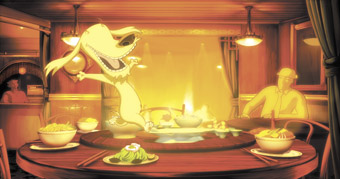
Sweet and Sour
Ironically, the concept of Chinatown was the first cultural stumbling block when the Shanghai animators read Eddy White's script. “It took quite some time to get the 'idea' of a Chinatown in a foreign country across to the Shanghai animators”, recalls Plews. ” They had no concept of it. One of the issues that needed clarification was that 'Chinatown' was not China…we had to do sessions where we showed the Chinese animators extensive folios of Chinatown photos from around the globe.”
Despite the SAFS’ international reputation, Sweet and Sour is only the second co-production undertaken by the studio. Plews and his associate producer Hu He “ended up being the conduit and the bridge, interpreting each side's expectations and looking after both side's creative interests.”
The result of all these cross-cultural negotiations is best seen in the film’s gorgeously sensuous Chinatown. Modeled on a dream-like 1930s Shanghai-style reality of bright colours, sensual women, raucous restaurants, gambling dens and bustling street life, the astonishingly detailed setting and expressive fluidity of the main character’s movements were borne of the two teams’ respective strengths. The backgrounds and some characters relied on the PRA’s skilful use of digital technology, while the cute lead was designed by the Australians and drawn by the Shanghai team. The finished film marries the SAFS’ hand-drawn characters with the PRA’s warm, digitally-generated backgrounds to beautiful effect.
Since premiering at the 2007 Adelaide Film Festival, Sweet and Sour has played at festivals around the country and garnered the Yoram Gross Award for Best Short Animation at the Sydney Film Festival last June. The Hong Kong International Film Festival will unveil the film for Chinese audiences in March 2008, and approval for Chinese mainland screenings was granted at the end of October 2007.
Perhaps more exciting than Sweet and Sour’s current success is the prospect of future collaborations. Despite the cultural divides that had to be bridged in the course of working with an Australia company, according to Plews the Chinese animators greatly enjoyed the experience. The two sides are now working on developing a feature-length project. A 'Memorandum of Understanding' was signed in June and two potential movies are currently being discussed: a film entitled Train to Never Was, and another about Christmas. Plews says they’re “leaning towards the former”, but will make up their minds before the end of 2007.
Given the level of artistry achieved in Sweet and Sour, the prospect of a feature-length co-production is an exciting one for animation fans. If Sweet and Sour has a weakness it’s the lack of narrative sophistication that so often characterises Australian animation. A longer work will hopefully facilitate the kind of rich storytelling the Shanghai studio has demonstrated in earlier works such as Sun Wu Kong.
China is a nation whose culture is only just beginning to meaningfully respond to outside influences, while Australia’s film community can be depressingly myopic when it comes to influences beyond America or Europe. Joint projects between the two countries can only provide a healthy artistic shot in the arm for both. As Barry Plews says of the many Australian-Chinese collaborations on which he has worked, “The most satisfying aspect is that the collaborations actually happen and that they realise such interesting outcomes. These are often very difficult and complex undertakings and they test everyone involved. Many of the Chinese artists with whom we work have never worked with foreign artists or producers before. Collaborations confront cultural differences head on, and the artists have to create within a moving landscape of cultural chasms and fault lines. It's no mean feat for any of them. The pleasure is the journey's end. Always.”
Sweet and Sour, director Eddie White, producers Sam White, Hugh Nguyen and Ren Zhong Lun, The People's Republic of Animation, Shanghai Animation Film Studio, Reckless Moments, 2007
RealTime issue #82 Dec-Jan 2007 pg. 20
© Dan Edwards; for permission to reproduce apply to realtime@realtimearts.net
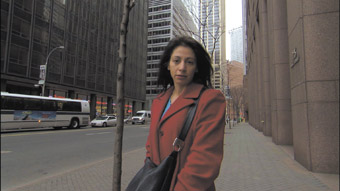
Norma Khouri in New York, Forbidden Lie$
AUSTRALIAN DOCUMENTARY FILMMAKER ANNA BROINOWSKI HAS A HISTORY OF TAKING ON THE STORIES OF STRONG AND CONFRONTING WOMEN. IN HELEN’S WAR (2004 AFI AWARD WINNER FOR BEST DIRECTION IN A DOCUMENTARY) SHE GETS TO THE HEART (AND HEAD) OF PHYSICIAN AND ANTI-NUCLEAR CAMPAIGNER HELEN CALDICOTT (SHE’S ALSO HER NIECE). WITH FORBIDDEN LIE$, SHE HAS AN ENGROSSING READY-MADE MYSTERY AT HER FINGERTIPS: WHO EXACTLY IS NORMA KHOURI? IS SHE A CON OR AN ARTIST (AS THE PROMOS ASK THE AUDIENCE)? AND DID THE EVENTS THAT SHE DETAILS IN HER BESTSELLER FORBIDDEN LOVE—AN APPARENTLY TRUE STORY ABOUT A JORDANIAN ‘HONOUR KILLING’—REALLY
HAPPEN?
Forbidden Love reads like a Mills and Boon romance of two star-crossed lovers: a dashing army hero and a pretty damsel in distress. It never sat right with me as autobiography or even as a recreation of real events. Stylistically it’s a Hollywood blockbuster transposed to a hairdressing salon in Jordan, dressed up as melodrama and, finally, horror as Dalia (the damsel) ends up murdered by her brothers and father. The dialogue is excruciating and the descriptions fail to create any real sense of place, but there’s no doubt it’s a page turner, and that many readers loved it. It also worked to fuel a sense of outrage—that women are still being treated this way—and fed into the current Western trend of positioning the Islamic community and their beliefs as morally and spiritually questionable and/or Arab Muslim men as embodiments of evil. Through all the drama, Khouri places herself firmly in the middle of the story—as the loyal friend willing to risk her life so the lovebirds can escape and live happily ever after—which, judging by Broinowski’s observations, is Khouri’s favourite place to be.
At the start of the film, we are introduced to Norma Khouri as she reads from her book, sitting in a white minimalist set where the windows have been painted on. As her words and voice linger, we zoom through the faux-glass into windswept desert sand. High-blown and arch, her narrative of Dalia—best friend since childhood—soon begins to drift, like those quickly disappearing footsteps wandering up into the sand dunes. From this brilliant beginning, Broinowski plays with poetic devices and metaphor throughout, and uses a great selection of music, like Sade’s classic 80s hit Smooth Operator, to highlight the possibility that Khouri might not be all that she appears.
But this ambiguity just seems to add a dollop on top of the woman’s already intense charisma. It helps that she’s gorgeous and gregarious, a natural in front of the camera; she looks straight down the barrel of the lens. Footage from the Byron Bay Writers Festival shows her treated like a rock star; the crowd want to touch her—“if there’d been music, I would have been in the mosh pit.” But with Broinowski now playing the detective you sense Khouri’s met her match. This filmmaker knows all about layers of manipulation and it’s intriguing to watch her tread a careful line between encouragement and scepticism as she tries to get to the nitty gritty, find some grain of truth. Like her subject Broinowski is in a gradual process of hiding and revealing what she knows (both to Khouri and in the way she structures the film) and at its best the film becomes a kind of bike race, the women hovering just in and out of each other’s sights, taking off in spurts and starts, slowing then waiting for that split-second moment to start the Olympic sprint.
As Broinowski convinces Khouri to travel back to Jordan to help sift fact from fiction, the filmmaker starts to get the upper hand. We meet a parade of historical experts, human rights activists, journalists (like Australian novelist Malcolm Knox, who initially exposed Khouri as a fraud) and Jordanian women going about their daily lives, who reel off lists of dates, locations and local beliefs that start to jar: a woman would never cut a man’s hair at a unisex salon; a certain brand of cigarettes hadn’t then been introduced into the country; the hotel chain, Hyatt, was still under construction; many women can travel alone without male escort—revealing Khouri’s writing to be, at best, historical fiction; at worst, a series of cliches wrapped up in great packaging in a bid to make a quick buck. On the ground in Jordan and increasingly under pressure on camera, Khouri says, “I don’t want her [Dalia’s real] name in the limelight. Everything here is smoke and mirrors.”
But, still, Khouri refuses to admit that her work is faction, or to call it a novel. Her refrain is that it came out of a promise to Dalia (at her gravesite) that her death would not be in vain. Khouri repeatedly states that her vision is to increase international awareness of the mistreatment of women in Jordan and encourage political pressure so that it does not keep happening. But although Khouri claims to send funds received from her book to charities fighting for women’s rights in Jordan, as with all her other leads, Broinowski can’t find proof of any philanthropy either. It’s all about controversy—and controversy sells. In a poignant moment, the killing is recreated for us with Dalia in bed repeatedly stabbed by her brother, a mindless knife attack in a frenzy of blood and chaos. And just as the horror has reached its peak, the girl sits up and laughs, pulls out a pillow that’s borne the brunt of this violent act, throwing us from real life to artifice in a split second. Just another actor working for the camera.
Which brings us to Norma Khouri’s ‘Oscar-winning’ performance. As she takes us and the filmmaker into her labyrinth of hidden lies and half-truths, we leave the book behind on the shelf, a curiosity to ponder along with Helen Demidenko’s The Hand that Signed the Paper. A Chicago cop on Khouri’s case reveals that a con artist likes to rub their victim’s face in the faeces of the crime; if Norma Khouri admitted her book was a fake there’d be no more story to tell. So here she is, still smiling for the camera as she strides down a New York street, bright red coat wrapped around her as if she’s just stepped off the set of Sex and the City—confident in the knowledge that while we may not know what’s fairytale and what isn’t, if she keeps this up she just might get away with it. And if Broinowski knows any diffferent, she’s not letting on.
Forbidden Lie$, writer, director, producer Anna Broinowski, cinematographers Kathryn Milliss, Toby Oliver, editors Alison Croft, Vanessa Milton, producer Sally Regan; nominated for the 2007 AFI Award for Best Documentary.
RealTime issue #82 Dec-Jan 2007 pg. 21
© Kirsten Krauth; for permission to reproduce apply to realtime@realtimearts.net
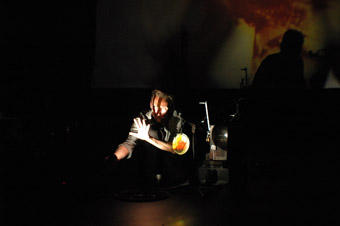
Christophe Auger
photo Tom Hall
Christophe Auger
EXPANDED CINEMA GREATS CELLULE D’INTERVENTION METAMKINE VISITED THEIR INFAMOUS LIGHT-AND-SOUND PERFORMANCE EXPERIENCE ON BRISBANE, SYDNEY AND MELBOURNE AUDIENCES IN JULY 2007 FOR LIQUID ARCHITECTURE. THEIR STYLE OF AUDIOVISUAL GROUP IMPROVISATION HAS BEEN HONED THROUGH COLLABORATION OVER A DECADE AND REVOLVES AROUND THE PERFORMANCE OF MULTIPLE 16MM PROJECTIONS AND LIVE ELECTRO-ACOUSTIC COMPOSITION.
Musical lynchpin Jerome Noetinger’s tape loops are a signature element of the band’s highly evolved but still frenetic shows which combine spectacularly sensual audiovisual experiences with a subtle critique of digital hegemony. Noetinger has said that he still hasn’t “exhausted the tape recorder” as he discovers things every time the band plays. He argues that “today there’s this spurious idea of ‘progress’, this imposition of new technology by the market. There’s something totalitarian about it. It’s like asking a violinist why he doesn’t play a computer.”
Noetinger’s description of Cellule d’Intervention Metamkine as “a band” is instructive. Key to the Metamkine approach and aesthetic is the careful positioning of the players; projectionists Christophe Auger and Xavier Querel face the audience like musicians, bouncing their beams off two large mirrors at the front of the stage, ‘playing’ their projectors like musical instruments. In the band’s shows at film festivals and music events, Auger and Querel operate up to eight aged 16mm film projectors, ‘performing’ the projection with various creative interventions into the beams, including moving projectors, using prisms and lacing up custom-made loops of the band’s distinctive luscious hand-processed abstract film. On their 2007 Australian tour, Querel spoke about the group’s approach and aesthetics.
Querel recalls that his “first experience of expanded cinema was through Christophe Auger, whom I’d come to know socially. I went along to one of the performances in the early days and really liked it. I was born in Saint Gervaus, a small skiing village in the French Alps, with only one cinema, and it was bullshit. No art cinema, just ‘classics’—‘the movies,’ in other words. As soon as I could I got out, and got to Grenoble with the wish of seeing lots of different films. And then…I discovered Metamkine performances. My grandfather and father were electricians so I used to work with them a lot and I am sensitive to light, but when I arrived, I had absolutely no background in film, cinema or music. But I was curious about everything—and, most importantly, I was in that state of mind to find avant-garde film. When I discovered Metamkine, even though it was only slides at that point, I thought immediately about Man Ray’s and other avant-garde films, and I understood: this is a new type of cinema. I was excited. Pretty soon I began to help Christophe and the other guys. The band and I clicked and we decided to work together, processing the films.”
For Metamkine, the key question, says Querel, is “What is cinema?” He explains, “For this we have a very empiric procedure—we try something, if it works, great, if it doesn’t, why? We are always asking ourselves, ‘where can I make a modification?’ We have an empirical method, not a structure.”
The other motivation was “the wish to be independent, to make films by ourselves, that special political situation, that led to Cellule d’Intervention Metamkine. Why? It’s political, of course: it’s to be outside the market. But it’s two things, really, it’s political/economical, but also aesthetic. On the one hand we want to control everything, make everything ourselves, take control of the process! Most people, even filmmakers, are happy to shoot film themselves, but then they have to hand it over to a lab for processing [where] it will be processed to exactly the same ‘standard’ as everywhere…This is why it’s very important to us to have our own lab, to process and explore film ourselves…the processing is as much a part of the filmmaking as the filming. To do it without participating in the industry is both an aesthetic and a political agenda.”
Querel says that when you take control of processing “you can make crazy experiments, such as the lab could never allow! This is more about aesthetics, obviously. A big part of our aesthetics, actually. We explore with black and white film a lot, processing it to two-colour separation, for example. Working with film, learning its ways, coming to know it, love it, work with it constantly, we have ‘become’ our own style of image. We’re not working on reproducing reality; it’s more to go deep into what film is as a ‘thing’, as matter, or substance, material, a tool rather than a medium for representation. Yes, I suppose there is some illusionism in our performances…it’s not with characters and reality, though, it’s not using recognisable images, and we don’t mean to have signification of some ‘thing’—it’s about matter, grain, colour, rhythm, light, particles, cells, flow…If there is an illusion, it’s a trick of your eye, or of the light itself.”
On his attitude to mainstream cinema Querel says he’s not really hostile. “I can accept the cinema for what it has become today—mass entertainment, it’s an industry, sure. An enormous amount of money involved—yes, I’m a bit hostile to that, sure…when I think about what it could have been. There are still some things that are interesting for me in the cinema—South American film, South East Asian film, African films can be quite intense. That intensity is critical to my creative life, it’s why I do Metamkine—the important thing to me is the play, that live moment, because it gives me such great pleasure. It’s intensely pleasurable to work with the loops and lenses and prisms and make something that’s different to normal cinema, something that’s unpredictable, where you have to react and really be there in that unique moment, that ‘now.’”
Querel recounts the many moments he loves in performance: “I actually love the space in between the so-called ‘perfect’ moments most of all; sure, it’s great when it’s all going well, but there is also excitement when I see something not going right and think, ‘oh, shit…’ There are always accidents occurring; it’s a door opening, where you can discover all sorts of new things. People tend to think of film as very fragile and get precious about it, but I don’t; if I break a loop or ruin a length, no problem, I react, improvise. I’ll just make some more. It’s great that it (the film) had a good death! Film for us [is] matter, demystified, you can work with it, and love it, and also love the destruction of it, scratch it, burn it, damage it voluntarily, and then you can create more. And we’re always creating more. When we’re playing, I am responding to Christophe and Jerome and they are responding to me…as well as to the venue, the performance space, the ambient light, the day you had before and maybe will have tomorrow, the audience…These things will all interfere a little bit, and charge up the performance with a unique energy each time.”
Read reviews of Metamkine in RT81, p46 & RT80, p51; www.metamkine.com
RealTime issue #82 Dec-Jan 2007 pg. 22
© Danni Zuvela; for permission to reproduce apply to realtime@realtimearts.net
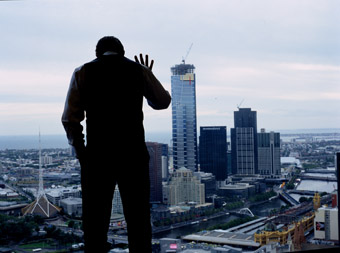
Meditations #2 (2007), BORIS + NATASCHA, production still
courtesy of the artists
Meditations #2 (2007), BORIS + NATASCHA, production still
THE BIENNALE OF ELECTRONIC ARTS PERTH IS A LITTER OF SQUIRMING CONFERENCES, SUCKLING AT THE CROSS-PROMOTIONAL TEAT OF A GALLERY PROGRAM LARGE ENOUGH TO FILL SEVEN VENUES. NOT QUITE ENOUGH TO PRODUCE A COFFEE TABLE BOOK AS A CATALOGUE, BUT ENOUGH TO MERIT DOING THE ROUNDS ON A BICYCLE. THERE IS A SATISFYING DIVERSITY OF STUFF GOING ON, WHICH IS NOT APPARENT FROM BEAP’S INSCRUTABLY MESSY 90s-STYLE WEBSITE. IT SEEMS THAT ‘ELECTRONIC ARTS’ NO LONGER INCLUDES THE INTERNET. OR PERHAPS THE FLASHY, CONSUMER-DRIVEN INTERACTIVITY OF THE NEW FANGLED WEB 2.0 MACHINE IS UNSUITED TO THE CENTRE-PERIPHERY MODEL OF CONTENT DELIVERY THAT MAKES UP THE GENRE OF ‘BIENNALE’ WHERE CURATORS RULE AND ART IN THE UNRULY NEW MEDIA IS GIVEN LEGITIMACY BY ITS DISTRIBUTION IN ANCIENT AND VENERATED FORMATS, AND WHERE IT IS JUDGED BY ART CRITICS INSTEAD OF SOCIAL TAGGING.
And this, I suppose, is why I’m here; it’s just not what I expect from a festival of technology. Mind you, I’m enjoying it, once I turn up and get my hands on one of the print catalogues, where the actual design effort seems to have gone. I still itch for some kind of search function, though. Not to worry. Steeling myself to experience art the Old Way I depart clutching a program, mounted on a bicycle borrowed from my grandfather.
I confess, it’s a rewarding ride. First left after the train station, Hannah Mathews has curated a cracker of a show at the Perth Institute of Contemporary Art, entitled I took a deep breath…. The darkened main gallery is completely occupied by Ulf Langheinrich’s WAVEFORM B, a monolithic strobe-lit piece on a horizontal screen. From the ceiling, subtly filtered white noise is projected in between strobes. The pattern hidden in the chaos is apparently rippling water, so barely present as to be hallucinatory. The catalogue assures me that couples “spontaneously” dance on the surface of the work, so moving is this piece. But not Australia’s demure gallery going public, it seems. We are stuck motionless to the edge like moths on a designer bug zapper. Even without the terpsichorean urge, it makes for an unforgettable entrance, mind you. Ulf Langheinrich, puts the capital “E” in “Electronic Art.”
Upstairs is the equally contemplative work by BORIS+NATASCHA. Now, “meditative” is a term that’s usually classified as ‘damning with faint praise’, but Meditations 1-5 decisively moves to reclaim that word for people with an ounce of irony left in their art-wracked frames. The pair have partitioned the gallery space into five discretely curtained meditation chambers. In each, a single channel video piece encourages us to contemplate the tightening of our muscles as we are guided into the transcendental depths of suburban paranoia and insecurity. A hypnagogic voice intones histrionic scripts reconstructed from discount bin new age chill-out cassettes, backed by synth pads and reverberating gongs and all: “Now think… when was the last time you changed the battery of the outside motion detector?”/”Keep focusing on the feeling that you will always be this stupid, that you will always be this low, and that you are a genuine phoney.” The dialogue sways between internal monologue and instructional recording as the faces of suburbanites depicted on the screen sway into and out of ill-contained anxiety and painful self-consciousness. It’s enough to put me off yoga for a month.
A bit further down the road, in Artrage’s The Bakery, Still, Living goes for a different sort of immersion. The show features an assortment of gut-churning, stinky, sticky work that plays with the boundaries of the body in all the least comfortable ways. This is a show centring on the practice of using living things in art, and it has the Frankenstein chic for which the various other SymbioticA-affiliated shows are infamous, but with a fecund rainforest diversity where others tend to cultivated monoculture. It is also a literal sensory immersion; the black back room of the gallery space is rich with a stale-wine funk from S. Chandrasekaran and Gary Cass’ Bleeding Angel, which uses live bacteria to produce the ‘blood’ that flows from their sculpture. This microbe-slick sculpture-cum-performance piece is surviving well post launch, slimy and alive and metabolising quietly. This is what I mean by the boundaries of the body; it’s rare that work gets up my nose in precisely this way, or makes me long for a glass of red quite so much.
In questioning blind science—gleeful biotechnologists playing with the stuff of life—these artists weirdly ape their subjects even as they parody them; blind art, its practitioners gleefully toying with the stuff of ethics. Brandon Ballengée’s work presses this line most deliberately. His piece is simple; a display of the documentation of the artist’s controlled frog breeding program in series of slides and preserved bodies, and it is both chilling and revolting. The eventual goal is to breed a line of frogs back to an extinct variety known from preserved specimens. Tame, mind you, compared to animal experimentation going on in every tertiary institution and cosmetics company worldwide, and not so far from the natural history concerns of your renaissance artists, but still disturbing. The artist’s assertion that each generation of his experimental amphibian population is precisely a new work of art unearths all sorts of unquiet ideas about genetic engineering, about eugenics, about volition in art…Even if the idea of selective breeding is the same in form as the aesthetic at any dog show, the presentation casts our history of animal husbandry in a harsh, clinical light, and scuffs the line drawn around playing god. Is it the vanity of breeding your own frog species that makes this unsettling, or the presentation of them amidst all the trappings of scientific research? What has happened to our notion of life to elicit this response? And yes, anatomically stained frogs are, simply, gorgeous.
This show is an exceedingly interactive one, in the pre-new media sense of that term. A cunningly contrived overlap between the attendees at the various conferences and the exhibiting artists sees the bulk of each personally present at the show launch. Sure enough, the place heaves with enthusiastic Igors explaining their exotic programs of animal-dissection-as-art and what have you. Not only is it congenial, it’s necessary to get your head around this show. Zbigniew Oksiuta’s semi-organic inflatable forms are as sad as abandoned beachballs, until you see the artist waxing excitable about their genesis in his research into breeding underwater habitats, where they become prototypes for an alien but delicious future enacted in organic subaquatic membranes. Beatriz Da Costa’s PigeonBlog, in the gallery, is a bunch of stuffed birds on plinths. Paired with her deadpan background presentation, however, it is a journey through ideas of ownership of space, of collaboration, of environmental decay, and a dig at the fashionable ‘collective intelligence’ of online communities. She has been strapping pollution detectors to the backs of pigeons to map the ebb and flow of toxic gas in the air they pass through in flight, and if taxidermy is all that remains of the project proper when it emerges into the gallery it is still an intriguing entry point into a fascinating project. These are works on the edge of what can reasonably be crammed into a gallery, and the fit is uncomfortable. But in a show that is already so disquieting, that’s half the point.
The word on the street is that Still, Living was intended for the suburban-gothic surrounds of the WA Museum, but that it pulled out due to the controversial nature of some of the works. That is disappointing, especially given the bizarre formaldehyde horror show in the museum’s own basement. However for this show the simple exhibition resources of the Bakery are congruous; gaffer tape would surely be the construction medium of choice of the modern mad scientist on the go and the show is a winner for reasons all about the hospitable informality of the space. It’s an unconventional curatorial effort by Jens Hauser, not without awkwardness, but he pulls it off with style. The dark walls enclose a show stronger and more compelling than any of the works that make it up, which is surely the ultimate mark of a well-conceived show.
Contrast this grungy fun with the more proper show at the John Curtin Gallery, where a few, mostly high profile works have been lavished with top notch presentation. I acknowledge that this is an important thing to do for reasons that have a lot to do with the need to get people turning out for your shows, and it is a marvellous excuse to pull out all the stops. The Bill Viola and Daniel Lee pieces here are excellent, but I’ve seen them before, and so have you. Possibly on a t-shirt. And yes, they are yet more impressive in real life. Ultimately these familiar objects aren’t the pieces which will make me squeal involuntarily like a five-year-old, though, and that’s what I really want.
What does the job is Lynette Wallworth’s Still: Waiting 2, a strong work which benefits from meticulous presentation. The piece is a high definition video recording of corellas in the Flinders Ranges, seamlessly edited to compress the details into a comprehensible chunk of time and space. You don’t have to do much to turn the colours of the landscape into something spectacular, where the million year habits of birds are set in a landscape scarred from a billion years of sunlight. It’s minimally interactive. You walk in, the startled birds take off. Done. But then the numberless flock leap from the remote fossilised landscape against the back wall into the immediacy of the gallery, and your head twists to follow the intricately granular swarm of shrill squalling…It’s a kind of eco-evolutionary panorama, where the forty thousand year human occupation of this continent is too tiny to notice. It brings the smell of sun warmed rocks to my nose, and makes me check my shoulders for birdshit. A must see.
Stillness, The Biennale of Electronic Arts Perth, Sept 10-23, http://beap.org/
RealTime issue #82 Dec-Jan 2007 pg. 23
© Dan MacKinlay; for permission to reproduce apply to realtime@realtimearts.net
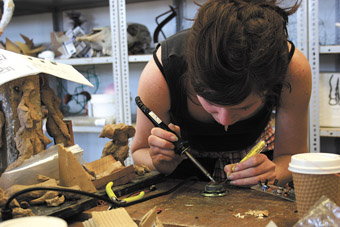
Dorkbot Workshop, Electrofringe
photo Mardy Dean
Dorkbot Workshop, Electrofringe
ELECTROFRINGE TURNED 10 THIS YEAR. THIS MEANS THAT THOSE OF US WHO HAVE BEEN ATTENDING THE FESTIVAL FOR A GOOD PART OF THE LAST DECADE ARE NO LONGER YOUNG.
Surrounded on all sides by aggressively marketed ‘youth’ events, there’s been a growing suspicion among some regulars that perhaps they’d outgrown This Is Not Art, the festival of which Electrofringe is a part. However, what distinguished TINA 2007 was an unwillingness to take these sorts of assumptions lying down. Instead, the festival hit back with a refreshingly self-reflective program that included panel discussions and artistic interventions designed to unpack ideas about the philosophy and future of the event as it edges towards double digits.
Take, for example, the panel on culture and generationalism cheekily titled You are all going to die. Facilitator Simon Cox had envisioned a throwdown between the young(er) and old(er) panelists about who’s monopolising arts funding and who’s blocking the doorway so that other generations can’t get a foot in. Interestingly however, the panelists including Kate Crawford, Marcus Westbury, Alice Gage and Gabrielle Carey didn’t turn on each other, but on the concept of generationalism itself. This point was deftly laid down by Crawford, author of Adult Themes, who argued that generational battle lines are essentially media chalk-ups and that real differences between groups are more likely to occur in relation to socio-economic factors.
But if generational divisions are not all they are hyped-up to be, what does this mean for the festival itself? Is TINA a cross-generational platform or an event specifically directed towards emerging practitioners? The discussion titled Is TINA a Critical Animal? (epistemological raisons d’être) pulled a sharp focus on these issues. Featuring Crawford, former Electrofringe co-director Gail Priest and 2007 Critical Animal co-director Sass Nicholson, the panel speculated on the cultural philosophy of TINA: is the festival facing a crisis in identity or should it hold fast to its consciously slippery position as a series of shifting possibilities. It is, after all, an arts festival called This is Not Art.
I tend to side with those who see the festival’s rejection of any clear mission statement as one of its fundamental strengths, enabling the event to be fluid and responsive to shifts in culture. The Electrofringe camp of the festival would seem particularly in keeping with this ethos, having—unlike the Young’ Writers Festival arm of TINA–never attempted to wear a youth demographic on its sleeve. As a festival simply geared to the showcasing of experimental electronic arts, Electrofringe also has certain mechanisms in place aimed at combating programming stasis.
To this end, Electrofringe’s biannual turnaround of directors this year teamed Alex White, Ben Byrne and Cat Jones. They engineered a tight program that seemed to preference organisation over anarchy, providing a distinctly different feel to some of the more deliriously chaotic Electrofringes of the past (I’m thinking in particular of the 2005 festival which, among other things, spawned its own irreverent talent show, Plover Idol). Significant new territory covered by the 2007 team included a thorough examination of issues of disability and accessibility in the electronic arts, presented in partnership with Accessible Arts NSW.
Of course, just because Electrofringe has the potential to change doesn’t mean that it necessarily will—there is always the danger of too much familiarity creeping into the programming. For this reason I would argue that it’s often the more specifically focused presentations that really hit the mark, plugging into people’s desire to walk away from each event with a new arsenal of skills, Dorkbot’s Pia Van Gelder not only gave an introductory presentation on her electronic learning group, but also ran an inspired series of practical Dorkshops on wiring circuits, sensors and controls. Other program highlights included the screening of Good Copy, Bad Copy (2007), a brilliant Danish documentary on audio remix practices (the panel on copyright which followed was irritatingly conservative, but that’s another story) and Clinton Green and Robin Fox’s compelling history of Australian electronic music otherwise virtually unrecorded.
In the visual arts corner, emerging collaborative outfit spat+loogie packed a huge crowd as they explained their intriguing and ambitious brand of low-fi art magic. The pair talked through their major projects including a Redfern community-based performance project, a fictional supermarket and their plans for a virtual travel agency. Although at TINA it is common for artists to be placed in the service of panel discussions, spat+loogie’s presentation confirmed just how rewarding it can be when the hour time-slot is given over to a single presentation.
In a similar vein, I could not help but wonder whether Electrofringe’s long standing video program would benefit from a rethinking of its format. Pieced together from an annual international call for entries, Electroprojections always showcases engaging works but the content of the program tends to suffer from a lack of variety from year to year. Curatorially this year’s program held together better than most, which is unsurprising considering that the guest curators were the seriously clued-in Keir Smith and Daniel Heckenberg (co-ordinators of the monthly Sydney-based film night Camera Obscura). Given their credentials, however, it would have been fascinating to see what they could have brought to Electroprojections had they not been restricted to selecting from a pool of submissions.
Ingeniously anticipating criticisms that TINA might have become dangerously institutionalised or formulaic, a number of artists were tasked to perform interventions designed to disrupt the efficiency of the festival. Dressed in beige military get-up, collaborative group Brown Council took aim at TINA’s ambiguous identity, instituting their own splinter event, the This IS Art Festival. Throughout the weekend they could be found (clipboard folders in hand) inspecting presentations and workshops for signs of legitimate “art.” But perhaps the most wildly disruptive interventions were the terror(art)ist antics of Melbourne’s Black Lung Theatre. Ambushing one unsuspecting panel discussion, two performers raided the stage and gaffa-taping, stripping, urinating and urine drinking ensued. Whether or not this organised anarchy was entirely successful in every instance, it was indispensable as an affirmation of the healthy future of TINA. It seems to me that any festival that is conscientiously concerned with its own undoing is not in danger of forfeiting its life-force anytime soon.
Electrofringe/This Is Not Art 2007, Newcastle, Sept 26-30
RealTime issue #82 Dec-Jan 2007 pg. 24
© Dominique Angeloro; for permission to reproduce apply to realtime@realtimearts.net
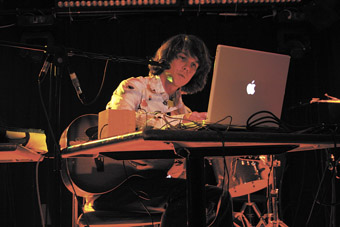
Leafcutter John, Electrofringe
photo Mardy Dean
Leafcutter John, Electrofringe
ELECTROFRINGE. IT’S A TRICKY TIME FOR A FESTIVAL TO CLAIM FRINGE CREDIBILITY WHILE DEFINING ITSELF IN TERMS OF TECHNOLOGY. BACK IN THE EARLY DAYS THE BACKBONE OF ELECTROFRINGE WAS WORKSHOPS ON NEW IDEAS FOR EKING SOME SKERRICK OF AUDIOVISUAL PROCESSING POWER OUT OF A ZERO BUDGET. THAT WILL GET YOU NOWHERE IN 2007. ACCESS TO TECHNOLOGY IS NOT THE LIMITING FACTOR HERE, IN THIS FESTIVAL WHERE THE NON-LAPTOP WIELDERS HANG OUT AT THE EDGE OF THE PLAYGROUND AND SULK. IT IS NO LONGER ENOUGH FOR IDEAS TO BE NEW, THEY MUST ALSO BE GOOD.
That said, this is still an egalitarian festival. If some festivals are agricultural fairs where all you see is the produce in its presentation box, Electrofringe is still closer to Backyard Blitz where we aren’t quite sure what we’re planting ahead of time. But we’re doing it fast, and in teams. One question is whether, in the YouTube generation, the focus on co-creation of the experience is at all fringe—or are the less participatory festivals beginning to be increasingly marginal?
One indicator of the way the mainstream wind is blowing must surely be the ABC, out in force at Electrofringe. Firstly, The Night Air radio-and-podcast performance is back from last year, bigger than ever. Secondly, sure enough, one of the various launches in this festival is an ABC-run social content-sharing website. Radio National’s John Jacobs and Sherre Delys have turned up to get feedback on their plan to produce an online collaborative A/V content repository, which will combine user generated content and archival material from the ABC itself, released under remix-friendly Creative Commons licences. You can smell the online content Zeitgeist.
More interestingly for the cool hunters among us, VJs are out this season, as out as surely as hoodies this month are preppy. The random video artists jamming along with psychedelic video clips to generic beats seem not to have put in an appearance. The venues are blissfully free from any manner of fractals, CGI robots attempting any kind of beatmatching, or oscilloscopes (except for the ubiquitous Robin Fox’s re-interpretation of that idea, and he doesn’t count). The electronic gig, then, tends to the genre of headphone music, the lie-down-and-close-your eyes school of performance. Sadly, the Cambridge Hotel, where the major gigs appear, is not the most suited to this in that no-one has provided spatulas to detach those foolish enough to lie down on the unidentifiable tar-like substance that the hotel classifies as ‘floor.’
Part of the backlash against the two-shy-blokes-with-laptops style is that we all seem concerned with performance aesthetics this year in general, and whether we are using Nintendo Wii game controllers in our art in particular. Paul Gough aka Pimmon declares his allegiance to the principle that computer music doesn’t need to justify itself by buying into the intensely manual modes of performance on acoustic instruments; it’s fine to press play and check your email. Although headliner Tim Hecker concurs during the discussion on their aesthetics panel, their juxtaposed sets in the final gig couldn’t be less similar. True to his word, the abstract soundscapes Pimmon produces are accompanied by little more interaction than the gentle oscillations of his eyebrows. It’s tightly controlled material, although I feel a little disappointed to recognise some of it coming straight off, for example, the *snaps*crackles*pops* album. Hecker’s sound is less tight, but his total engagement with the process and the audience and a very gestural style gives his piece the kind of emotional force that a gig in this venue needs to cut through the background fog of beer. More than that, it must be the most booty shaking ambient harmonic soundscape to convulse the sticky dancefloor, if anyone is keeping records. You can see the bituminous floor slime arrange itself into concentric ripples around the speakers. Or at least I can. The cold light of day might tell a more prosaic tale, but you can get the sober version by turning up to Electrofringe yourself and sticking to orange juice.
More gestural and improvisational still is Leafcutter John. He riffs on prompts and heckles from the crowd, with the sarcastic humour of the smartarse kid up the back of the class on a ten kilowatt PA. Oh, but with more toys. He jams with game controllers, springs, sticks, wooden boxes and an acoustic guitar and whatever else, working our anticipation each time he reaches for a new instrument, each time one of the audience yells out. He latches on to the injunction “Make us dance!” and summons the speaker onto the stage for a short bracket of loose-dancing ballroom moves. It turns out the belligerent heckler in spray-on trousers is Thug Quota, of Melbourne ur-rock ensemble Bum Creek, not to mention lead clarinet in Chalga Party, the hit Gypsy band from last night’s acoustic gig. It also turns out that neither of them knows how to ballroom dance. The ensuing jam between the two strangers, on half-assembled drumkit and guitar, is interesting musically and fascinating dramatically.
The traditional Electrofringe story from this point goes on to climax with further debauchery, possibly in a warehouse party of some description. Hell, possibly even with cheesy VJs. But this late and drunk in the evening, when we have let our hair down enough to consider such unfashionable activity, we are amazed to discover that after the close of the pub there is nothing else on. Damn, I thought we weren’t serious about all that nonsense about such stuff being out of fashion. Where’s the homemade zero-budget sound system when you need it?
Electrofringe/This Is Not Art 2007, Newcastle, Sept 26-30
RealTime issue #82 Dec-Jan 2007 pg. 25
© Dan MacKinlay; for permission to reproduce apply to realtime@realtimearts.net
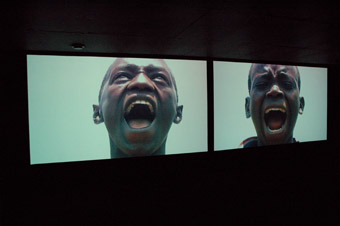
In Still Waters Crocodiles Lurk, Marcel Odenbach
courtesy of the artist
In Still Waters Crocodiles Lurk, Marcel Odenbach
FLYING SOUTH BEYOND AOTEAROA, ACROSS THE ARC OF THE GREAT SOUTHERN OCEAN, TO CROSS THE COAST OF CHILE BEFORE HEADING NORTH OVER THE SNOW-CAPPED ANDES, TO DESCEND LATE AT NIGHT INTO A SOMNAMBULANT SAO PAULO, WAS A VOYAGE ACROSS VAST DISTANCES AND ALSO THE REACHES OF THE IMAGINATION. THE 16TH VIDEOBRASIL INTERNATIONAL FESTIVAL OF ELECTRONIC ARTS IS LIKEWISE EXTENDING SCREEN-BASED ARTS BOTH GEOGRAPHICALLY AND CONCEPTUALLY. THE MAJOR THEME FOR 2007, LIMITE: MOVING IMAGE AND LOTS OF STRANGENESS, WAS UNDERPINNED BY A CLUSTER OF SUB-PROGRAMS THROUGH WHICH THE CONFLUENCE OF ART, VIDEO AND CINEMA WERE TO BE EXPLORED.
Sao Paulo is a city of staggering complexity and scale, and is Brazil’s economic and cultural powerhouse, with over 20 million inhabitants. This year’s Videobrasil had moved to a new venue in the unlikely and unpromising 14-storey office block, the SESC (Social Service of Commerce, a private cultural agency) Centre, on the grand Avenue Paulista in the city centre. Over 10 days SESC was the hub of a glittering constellation of filmmakers, critics, curators and artists gathered from around the globe to participate in a formidable program of retrospective exhibitions, cinema screenings, forums and critical debate.
going up
The five floors of the former office block now the heart of Videobrasil have been stripped bare and skilfully reconfigured as a series of galleries for the huge audience that the festival attracts, shuttled up and down in packed elevators between the successive floors, each dedicated to invited artists.
ground floor
There’s an outdoor video installation by Eder Santor and, in the foyer, a light installation by Angel Detanico Rafael Lain leading to the adjacent cinema and auditorium used for a daily program of screenings and forums.
mezzanine
The videotheque comprises a mini auditorium for forums and presentations, a video library browsing space and a catalogue shop including a rich collection of Videobrasil archive programs.
level 3
Here, the Loop video program, presented on plasma screens, comprised selected entries from the screening program and included works shot on mobile by Giselle Beiguelman and two of the eventual award winning works by other Brazilian artists Ayson Heraclito (As Maos Do Epo) and Alice Micelli’s short tribute to Andy Warhol titled Jerk Off 2. Level 3 also featured installations and exhibition screening spaces for retrospective exhibitions of two significant South America video artists: Arthur Omar and Carlos Adriano. It was a rare excursion into tracing the trajectory of video art development in this region. As a first engagement, what was striking was both the specificity and universality of visual languages. Nuanced cultural references, themes and techniques—borne out of a South American experimental tradition strongly informed by a social documentary style of filmmaking—proved characteristic of a significant number of works presented in this year’s Videobrasil.
level 4
Peter Greenaway’s Tulse Luper, an installation of 92 ‘suitcases’ extraordinaire, was stunningly baroque in its intensity. You are confronted with a dimly lit room with shelves of open cases filled with dusty old shoes, a train set, lingerie, small LCD monitors running video from films etc. For the audience this becomes a curious forensic exercise in deducing the significance of this material in the life of the enigmatic character of Tulse Luper. For the full story go to http://petergreenaway.co.uk/tulse.htm
level 5
An entire floor is devoted to one of the pioneers of western video art, Marcel Odenbach (Germany) with a major exhibition of 15 works dating back to 1978, culminating in a new single channel video installation, Disturbed Places—Five Variations on India (2007). This single channel work, characteristically presented in a complex and meditative documentary style, reflects on an idealized India—as promulgated through the 1960s counter culture—and evoked by the subtle interweaving of soundtracks from films of that era against footage from a recent journey.
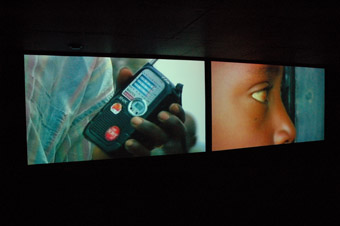
In Still Waters Crocodiles Lurk, Marcel Odenbach
courtesy of the artist
In Still Waters Crocodiles Lurk, Marcel Odenbach
hybridity & a new cinema
The theme of “hybridity of form” between art and cinema has been echoing around major film festivals over the past year including Toronto and Rio de Janeiro. The curator and director of Videobrasil, Solange Oliveira Farkas aimed to develop a common understanding about the ways the imaginative and theoretical spaces of hybridity have been charted and might be navigated in the future.
Explorations of a prospective ‘new’ cinema were grounded against the historical backdrop of a seminal experimental film from 1932, Limite: Movimentação de imagem e muita estranheza (Limite: Moving Image and Lots of Strangeness). A rare screening of this work by Brazilian filmmaker Mario Peixoto provided a central motif for this year’s event, as a precedent in form and technique and a departure from narrative. It is regarded as a film that has nourished and encouraged contemporary videographic language and a deterritorialized cinema.
greenaway festival launch
Peter Greenaway launched the festival in grand style with a massive three-channel outdoor projection component of his Tulse Luper project. More a performative cinema event, it comprised images and scenes conjured live from the artist’s huge database of cinematic works. Here Greenaway re-mixed and jammed with Serge Dodwell aka DJ Radar via a sophisticated touch screen interface. Over an hour the booming club-like atmosphere of the performance was completed by the crush of a street jam-packed with thousands of fans mixed with bewildered onlookers.
True to form, Greenaway’s strident and contentious critique and his experimentation with the formal language of film echoed throughout the week’s program. In an interview he stated, “Cinema is wasted on cinema—we really must put it to better use.” His notion that cinema is ‘dead’ was fiercely contested in a debate between Greenaway and French critic Jean-Paul Fargier who rightly asserted that it was “a claim too far.” The compromise reached was that we are seeing the birth of a ‘new cinema’ for which Greenaway was claiming some sort of paternity
What new forms art and cinema in the digital era might take was further explored in an extensive programs of exhibitions, retrospective screenings and forums which included works by Kenneth Anger, Marcel Odenbach, Arthur Omar, Carlos Adriano, Edgard Navarro and a huge program of recent screen works from around the world.
jury duty
Regrettably, I was unable to see all of the programs. I was there to work. A small group of jurors, our task was to deliberate on the subject of the confluence of art and cinema, and award three major and three supplementary prizes from a pre-selected program of 66 new works drawn from a total pool of more than 700 entries.
Australian artists have a significant history of participation and achievement at Videobrasil over many years. Peter Callas, Deborah Petrovich and Norie Neumark are among the dozens of Australians represented since the 90s. Australian artists on exhibition this year were Bridget E Walker, John Gillies, Alexandra and David Beesley and Shaun Gladwell together with a program I curated of Australian video works, titled Panoramas of the Imagination.
Likewise the other jury members were invited to curate and present their own video programs. These included Berta Sichel, Senior Curator of film and video at the National Museum of Art, Madrid, Tanzanian filmmaker, academic and director of the Zanzibar Film Festival Martin Mhando, Jean-Paul Fargier, author and art and cinema critic for Les Cahiers du Cinema and Daniela Bousso, Brazilian media art curator, writer and critic.
the future now
What Videobrasil so eloquently proposed and demonstrated is that we have entered a new space where boundaries fall away and that we can intelligently move into a creative and critical space where a new language of the screen can accommodate and embrace the wealth of possibilities that have been developed by artists and filmmakers over the past 80 years. We have this within our grasp. One work by Marcel Odenbach, about post-genocide Rwanda, elegantly and powerfully articulated what a new cinema might be. A simple two-channel installation titled In Still Waters Crocodiles Lurk (1995-2004), it dissolved the interminable dispute over narrative and form.
For more about Videobrasil, including this year’s award winners, go to www.sescsp.org.br/sesc/videobrasil/site/festivais/festival_16_en.asp
Videobrasil, 16th International Electronic Arts Festival, SESC, Sao Paulo, Sept 30-Oct 25
In RealTime 83 Nigel Helyer reports on Mexico’s Transitio_MX02 Mexico new media and video festival.
RealTime issue #82 Dec-Jan 2007 pg. 26
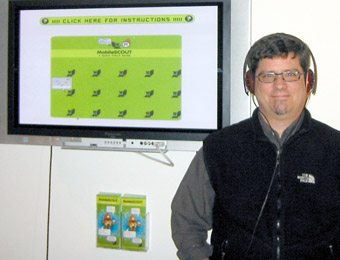
Steve Dietz listening to Mobile Scout at the Database Imaginary exhibition, Walter Phillips Gallery, Banff, Canada
THE VISUAL ARTS BOARD OF THE AUSTRALIA COUNCIL INVITED STEVE DIETZ, A SEMINAL FIGURE IN AMERICAN CURATION OF NEW MEDIA ARTS AND CURRENTLY DIRECTOR OF THE ZERO ONE BIENNIAL FESTIVAL IN SAN JOSE, CALIFORNIA, TO COME TO AUSTRALIA TO MEET ARTISTS AS PART OF ITS INTERNATIONAL MEDIA ARTS STRATEGY. TAKING ADVANTAGE OF THE VISIT, REALTIME, D/LUX/MEDIA ARTS AND PERFORMANCE SPACE COLLABORATED WITH THE VISUAL ARTS BOARD TO HOLD AN OPEN DISCUSSION BETWEEN DIETZ, SYDNEY ARTISTS AND CURATORS AT CARRIAGEWORKS. THE CONVERSATION FOCUSED PRINCIPALLY, EVEN RELENTLESSLY, ON THE STATUS OF TECHNOLOGY IN MEDIA ARTS, NOT LEAST ON THE WORD THAT WON’T GO AWAY—NEW. A TRANSCRIPT OF THE MEETING, INCLUDING DISCUSSION OF THE RUNME.ORG SOFTWARE ART SITE AND THE GUGGENHEIM VARIABLE MEDIA INITIATIVE, CAN BE READ AT WWW.REALTIMEARTS.NET/FEATURES. HERE ARE SOME EDITED EXCERPTS.
Anna Waldman, Director, Visual Arts Board, introduced Dietz to the gathering, detailing his extensive media arts career since the 1990s, including 1996-2003 as curator of new media at the Walker Arts Centre in Minneapolis in the US, where he founded the new media initiative Beyond Line Art Gallery 9 and the Digital Arts study collection. Dietz has written and edited extensively and organised and curated many new media exhibitions including some of the first online exhibitions. He was director of ISEA 2006, Symposium Zero One, San Jose and is artistic director of the biennale Zero One, Global Festival of Art on the Edge in San Jose, 2008. Waldman was pleased, she said, that Dietz had “positioned Zero One as an event where artists are making art”, rather than making work about technology, and reported that he had “described his curatorial role as being polymorphously inquisitive”—as the full transcript of the meeting attests.
Keith Gallasch In one of your essays, you quoted Tom Stoppard, from his play Arcadia, saying, “It is the best of all possible times to be alive when everything we thought we knew is wrong.” Has your own career been like the twists and turns of media and media arts developments?
Steve Dietz I did go to art school and very smartly knew that I shouldn’t try and be an artist after that. But I was always interested in the combination of art and text, you know, sort of multiple things at once, and I think probably for many people around the circle here, the so called ‘new media’ was a place where you didn’t quite fit in as an architect or an engineer or a programmer or painter, and somehow this sort of combination of things was an amazing opportunity. And that was what Tom Stoppard [was referring to], that we didn’t know exactly what was going to happen but there was a kind of excitement and enthusiasm and it wasn’t about success in traditional terms, it was about exploration and energy and for me it was around text and images and that photography is both an artform and a system of communication, and digital media was sort of that on steroids.
What actually grabbed me was the CD-Rom. I saw it and I thought this is what I want to do, and I went back and sort of founded the New Media Department at the Smithsonian American Art Museum. But I think net art was interesting because it was, kind of oddly, a substantiation of a virtual world. It’s a kind of platform that one could talk about that historically, I think, didn’t exist quite in the same way until the advent of the internet and especially the world wide web. So that’s where a lot of my early curatorial energy was focused because for me one of the roles of the curator is to be a follower not a leader. There were lots of artists, I think, who were doing things on the net that were interesting to me and I wanted to make them interesting to both my colleagues and the general public.
KG Later on you wrote an important paper called “Just Art: Contemporary Art after the Art formerly known as New Media.” I was wondering, how did you arrive at the ‘Just Art’ position having been so heavily involved in the promotion of new media art? Was this a rhetorical point? In what way was it strategic, because in the same essay, although you say it’s “formerly known as new media art”, you defend artists against the charge of technophilia. You say, in fact, that new media art would save contemporary art because it would never be curated in the same way, and you say at the end, new media art won. New media art is dead, long live new media art. Are you having it both ways?
SD Yes, exactly. For a time I was very interested in championing and understanding the sort of differences and the new possibilities and capabilities and especially network and computational based artwork. But I think at a certain point there started to be a kind of ghetto happening, a kind of division, of conversations that weren’t happening between contemporary artists and so-called new media artists. And one of the things I write is that every single artist and curator I talk to says it’s not about the technology, it’s about the art.
My argument is, and not everyone agrees with this, that the best way to understand contemporary art is though the lens of new media art. It’s ephemeral, it’s performative, it’s real time, it’s all these things that everyone is dealing with and new media artists in particular have been dealing with them for a long time. So it’s a bit of a stretch—in the real world, in the pragmatic world—to say that new media art is “now.” But I do think that a lot of the issues that we have been dealing with for however many years are ones that are also front and centre in the contemporary art world and so, we need to have that conversation.
KG And so in your own festival, Zero One, in San Jose, what kind of art do you include if you want to realise more expansive vision?
SD Well, I think that the goal of the festival is to be about contemporary art that intersects with technology but is not medium specific. So it has nothing to do with whether it’s a computer or projector or a network. It could be a painting, it could be a sculpture, it could be, you know, some version of nature. And so in that sense it’s a very open field. But I do feel like a whole range of artists are looking at how technology has impacted on the universe for better and worse over the past 40 years and to separate those artificially into media arts and contemporary art is no longer a very interesting proposition. So when I go to the Sao Paulo Biennale and see fantastic work and really interesting ideas and there are no artists who actually use technology in a compelling way, it’s depressing…Many new media artists are very cogniscent of their relationship to the ideas of the contemporary art world. It’s the institutions and curators that I think are keeping or creating the separation, for some odd reason.
Lizzie Muller You were saying you’ve spoken to lots of new media artists who say their work is not about the technology, it’s about the art. But I wonder if that’s one of the distinctions that’s becoming a bit of a problem because if technology is someone’s medium, it might be fair to say that their art is very much about the technology…Another possibility is that the division between art and technology has held for such a long time that if, as new media people, we continue to say it’s not about the technology, we are kind of refusing to allow our medium to be brought into contemporary art spaces, whereas if we started to say, actually it’s very much about the technology and we work with technology, as a material, that might start to create some of those conversations between contemporary and technological art.
SD …[T]echnology is changing how society works and this is my sort of core argument. [T]he computerisation of society, the combination of computation and networks has changed the world. And the world includes art. But my experience, and frankly my own interest, is not that artists formerly known as new media artists are interested in their art being understood as being about technology.
Denis Beaubois It’s very interesting for me because I don’t think it’s an either/or argument, I don’t think it’s polarised like that. I think part of the debate about new media, in my understanding is, that it is a fluid thing, a developing field, something that is active, and shouldn’t be pinned down by a medium.
LM Is it not possible to say that you couldn’t make an artwork now that wouldn’t be dealing with the impact of technology on experience, on one’s life? But that, on the other hand, some artists are really confronting that impact in an explicit way.
SD That is very well put in terms of how I would like to think about Zero One, because one shorthand way of saying it is that it’s not medium specific. And I think the other thing is that it is a complicated argument and I’m not trying to say that there is contemporary art sitting up here, and we’re all trying to be there. We have to actively support a heterogenous environment, the idea of experimentation and the support of new practices, and you know, those are really critical issues that can’t be ignored, or shouldn’t be shoved away. At the same time, I also think we have a certain responsibility, whether we’re curators or critics or artists, of not limiting ourselves to our most comfortable circle, so to speak.
David Cranswick The thing I’m thinking most about at the moment is the technology, which is the substance of what the artists are working with…People now have fluency with navigating and understanding networks and systems—everyone has been drilled in the revolution …but again, artists have been working for decades now, have been doing great stuff with this.
SD Exactly my argument—I would say everyone except the institutions and the curators, right? The argument is not with the artists, the artists are not the problem…On the face of it, there is no adequate generalised appreciation of the amazing work that artists formerly known as new media artists are doing. And that’s, you know, bordering on criminal.
DC We’ve talked with you about ecologies and GPS and locative media. In recent months more and more people, and organisations like the City of Sydney, have alerted themselves to the fact that there are new channels, and they’re interested in how people traverse the city and how we might communicate with people, say within an arts festival or a biennale or so on. Thinking about five years from now, I’m not asking you to name the technologies [that will dominate], but is it GPS or some super network? Where are the movements do you think?
SD I was talking to someone here earlier about Second Life as an instantiation of a larger issue around virtuality and networks. And at one level, I couldn’t care less about Second Life per se. It’s a particular thing of the moment. So I do think that networks and computation are critical and what’s happened is that there’s this convergence…of mobility, the power of computing and the global network always being available. And that creates new possibilities, and I think that the larger issue there is how do we think about a universe that’s always online everywhere, all the time. And, yes, I absolutely think that that’s a direction that’s happening, whether it’s the iPhone or the Palm Pilot or GPS or a new set of satellites that the Chinese will put up into orbit—I don’t know, but I think that will change things. But the interpenetration of the network of computation into the physical world is only going to get more and more dense, and artists are going to do more and more interesting things with that.
See Features: RealTime/Performance Space Forums for full transcript.
–
Meeting Steve Dietz, presented by RealTime, Performance Space, d/Lux/MediaArts and the Visual Arts Board of the Australia Council for the Arts at Performance Space, Sydney, Australia, Aug 21, hosted by Keith Gallasch, Managing Editor of RealTime and David Cranswick, Director d/Lux/MediaArts.
Further information about Steve Dietz can be found at www.yproductions.com
Steve Dietz visited Australia as a guest of the Visual Arts Board of the Australia Council for the Arts as part of its International Media Arts Strategy.
RealTime issue #82 Dec-Jan 2007 pg. 27
© Keith Gallasch; for permission to reproduce apply to realtime@realtimearts.net
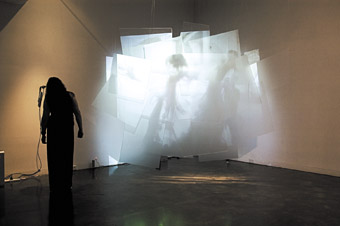
Impossible Geographies, Memory
photo Nicholas Goldhourst
Impossible Geographies, Memory
IT’S A WET AND COLD AFTERNOON IN EARLY SPRING AS I SLIP THROUGH THE DOORS OF THE TIN SHEDS ON SYDNEY’S ROARING CITY ROAD. THE PHYSICAL GEOGRAPHY OF SO MANY THOROUGHFARES IN THIS CITY IS UGLY AND ANTI-PEDESTRIAN—LONG WAITS BETWEEN MULTIPLE TRAFFIC LIGHTS TO CROSS THE ROAD; BUS STOPS EXPOSING COMMUTERS TO THE FORCE OF THE ELEMENTS; SEMI-TRAILERS THUNDERING PAST AND PELTING OUT SMOG. WHAT A DELIGHT, THEN, TO ENTER INTO AN UTTERLY DIFFERENT TERRAIN: THE UNHURRIED, LUMINOUS AND IMPERCEPTIBLE SPACES OF PETRA GEMEINBOECK’S EXHIBITION, IMPOSSIBLE GEOGRAPHIES.
Here we encounter two installations that stretch and fracture screen space, stitching and splitting image projection, surface and interaction. Installations that amplify the weird radiance of digital light—to the point where it becomes the material substrate constituting the works’ visual field. Installations that mesmerise in the minutiae of their movements or in the slow image disintegration that they perform.
The two installations that form the topography of this other space—Memory and Urban Fiction—both depend on maintaining a relation to physical, encountered and imagined spaces outside the refuge of gallery walls. Memory is a restaging of an installation that Gemeinboeck exhibited previously in Singapore, the US and UK. This was its Australian premiere and this fact alone attests to the lag we still experience in curating and providing access for our audiences to experimental new media arts. Memory captures audience members’ images as we pass into its net of Mission Impossible style laser beams. These ethereal bounding mechanisms trigger image captures, which end up spread both across the work’s fractured and layered screens and deposited in a databank. We join up with the ghosts of audiences long past and become slots in the computer’s memory to be accessed according to its algorithmic and rhythmic processing. That space of computational processing—utterly impossible for human memory to inhabit—nonetheless returns on the installation’s screens. We find our own real time gallery movements conjoined with the traces of previous visitors and of movements we have made in the gallery only five minutes before.
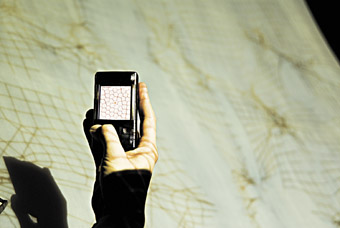
Impossible Geographies, left – Urban Fiction
photo Felicity Jenkins
Impossible Geographies, left – Urban Fiction
We expect a mirror, conversation or cause and effect response as we interact with Memory. We are met instead with distribution, fragmentation and filtering of the relations between image/trace, computer/embodied human and processing/thinking. What is delightful and pleasurable about Memory is that these are impossible spaces to navigate, if by navigation we mean to steer or move in a purposeful manner toward obtaining a goal. But this impossibility makes the interaction all the more enjoyable, provoking us to experiment with virtual and actual space and action.
We are also impossibly tiptoeing through something else in Memory—time. Although digital media have long been flaunted as ‘nonlinear’, much of our experience of them tends really to be multilinear. We branch through options in an interactive story; we go forwards, backwards, even sideways but advance through levels in gaming. Memory, however, gives us no such pathways: visitors’ images from the installation’s past are entangled with our own in a visual dynamic and in the software dynamically processing its present and prior captures. There are gaps and syntheses between the present and past and the installation’s future only materialises from this interplay. Memory is one of those rare interactive experiences where we momentarily perceive the impossible temporality of the nonlinear.
A fracturing aesthetic and experimentation with dynamic human-machine interaction connect the installations Memory and Urban Fiction, within the gallery. What threads together the two works visually is the distribution and layering of screen spaces. Rather than just a convenient wall to absorb projection, Gemeinboeck treats screens viscerally. They are the fabric and fabrication place of digital production, to be ripped, stitched, piled upon and scattered. In Urban Fiction, three screens are stretched in mid-air, catching their projections but also letting the edges of the moving image spill out onto the floor. Everything is beautifully positioned and executed yet simultaneously unshackled.
But what are we actually looking at? Pulsations become patterns; dots march imperceptibly across the screen space; deforming lines and grids slowly unravel. This feels like a fragment from a map of planet ‘Information’ or the twisted, skeletal wire-frame of 3D-generated space or computer code run through a visualiser of the imagination. If Urban Fiction is a map, then it is not of familiar territory and it defies all formal cartographic conventions. And yet, the barely moving images are all generated through engagement with the surrounding geography of Darlington. Participants use customised mobile phones to walk around the vicinity of the gallery. The installation also logs signals from unwitting mobiles on the same network within specified parameters surrounding the gallery. These signals all aggregate via custom software into forces and tensions that interfere, are sutured into and deform the image fields.
As we stand in the gallery, we begin to realise we are watching the formation of vast movement patterns beyond singular instances of navigation through urban space. We keep time instead with collective city rhythms beyond immediate visibility. Indeed we see more than we would when looking at a map or image of the city. For here the surrounding buildings block, refract and lose network signal and these processes affect the absorption of signal into the data capture process. An image scape emerges of the urban landscape we think we know but to which many histories, forces and traces also belong. What emerges is not cartographic but topological—the nonphysical yet ever-present ground of shifting relations between people, between people, buildings and urban cultures, buildings and signals, signals and signs, all contributing to contemporary urbanity.
Petra Gemeinboeck, who lectures in digital media in the University of Sydney’s Faculty of Architecture, is one of those rare new media artists whose work is equally aesthetic and intellectual. The sensation of inhabiting her impossible geographies is visceral but also a jolt that provokes thought: the thought of inhabiting the impossible. Like that of Jorge Louis Borges’ writing fragment, The Garden of Forking Paths, Gemeinboeck’s ‘impossible’ is actually a space and time of infinite possibilities.
Petra Gemeinboeck, Impossible Geographies: Memory (in collaboration with Mary Agnes Krell), Urban Fiction, Tin Sheds, Sydney, Aug 21–Sept 8
RealTime issue #82 Dec-Jan 2007 pg. 28
© Anna Munster; for permission to reproduce apply to realtime@realtimearts.net
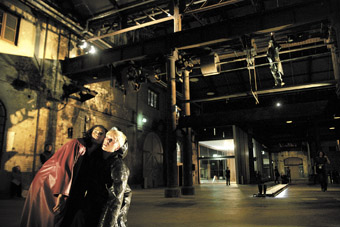
Henrietta Baird, Tess de Quincey, The Stirring
photo Heidrun Löhr
Henrietta Baird, Tess de Quincey, The Stirring
IN DE QUINCEY CO’S THE STIRRING, THE AUDIENCE MOVES ABOUT A CARRIAGEWORKS BOTH REAL AND IMAGINED. WELL BEYOND THE WATCHING OF PERFORMANCE, WE ARE PLUNGED INTO AN INTERROGATION OF INTERSECTING TEMPORALITIES BOTH MATERIAL AND IMMATERIAL.
The nature of roaming spectatorship precludes engagement with everything performed in the variously titled rooms (Shrine for a Whale, Snort Room etc) and corridors (Kandinsky’s Loop, Long Rails) of this industrial palace. Yet, I am somehow privy to all that happens because of the tangibility of response in movement quality between performers, and the piecemeal dissonance of stories continuously told, repeated in apocalyptic paroxysms or announced with statesmanlike cheer from a manhole.
First, I catch sight of Victoria Hunt’s shrouded body suspended from one of the vertical balusters, rapidly recoiling and arriving at prostrate gestures that loom over Tess de Quincey’s invocations at the mouth of a ‘river’ (lined rails filled with oil). A single motif (straight hand and arm held aloft) by de Quincey registers the relationship between performers. It’s picked up and signaled by Henrietta Baird who is enveloped by Oguri in quiet, quickly paced circles. The scattering of performers from this point is equally marked in the pattern of audience movement.
High in the gantry, Alan Schacher, in scurried motion, screams “There are no angels”, his performance, in distinct contrast to the others, approaching well-formed character. Meanwhile beneath, Baird negotiates another tongue with others not visible. It fills her with a sense of urgency netted by hesitation. Intricate shapes are formed in her hand, her movement punctuated by jumps and sporadic runs halting in stillness. Later she floats like a siren from unfathomable depths while hanging by her ankles—the pained quivering and twitching of the body yielding a striking illusion of beauty. Simple non-mediatised techniques meddle with perception.
In the Snort Room a piece of industrial balustrade precariously swings from a short chain, playing paradoxically with my sense of weight. Further away in the distance three figures in white stand motionless, empty, just there, until the passing of a train jiggles them into animated conversation. It is a vignette powerful in its use of serendipity, and intimate despite the distance.
Inside the Shrine for a Whale room, a huge mound of stones steams steadily. A thin spray of water falls imperceptibly at first until I feel the moisture on my lips and move to another position. Oguri’s hunched being dances effortlessly. His already soiled, hooded white coat sculpts his tiny body and hides his face. He steps cautiously with great delicacy in the unfolding landscape, his head escaping the hood like a mouthing infant finally leading him to climb the obstacle before him. The crunching of stone provides an underscore to the sonic tabernacle of mechanical polyrhythms and noise tectonics composed by Natasha Anderson. The voice of the building participates in the dialogue connecting rooms, notably silencing when the performers do. De Quincey and Oguri join each other briefly. Object composition, incidental shadows and patches of stasis juxtaposed with motion function to displace our beingness in this place, especially through oddities of scale. The dance devolves into the swallowing of Oguri’s shadow by de Quincey’s body.
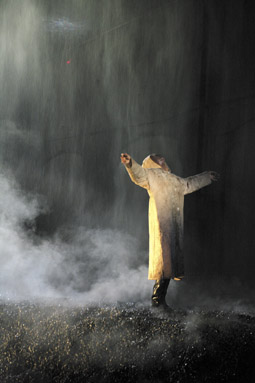
Oguri, The Stirring
photos Heidrun Löhr
Oguri, The Stirring
The costumes by Lian Loke pronounce the weathering of elements inside this world of water, steel, stone and concrete. They offer material documentation in their exposure to the rolling, pressing and rubbing of the performers. Like wearable flats, the performers seem to use the hooded coats to transit scenes.
The five performers in The Stirring dwell resolutely in the tension between points of definitive arrival and unsettled dissipation. The cheek to cheek duet between de Quincey and Baird is a soothing communion, a reckoning that has all five performers walk toward two drums of bubbling fire in a final potent image. We are invited to stand opposite them. They smile, their hands outstretched. Silence.
The Stirring plumbs the temporal dimension of the CarriageWorks, reconstituting its past, present and possible future ecology with the many palpable languages found onsite.
–
De Quincey Co, The Stirring, concept and direction Tess de Quincey, choreography, performance Tess de Quincey, Henrietta Baird, Peter Fraser, Victoria Hunt, Oguri, Alan Schacher; composer/installation Natasha Anderson, lighting Travis Hodgson, costumes Lian Loke; CarriageWorks, Sydney, Nov 8-17
RealTime issue #82 Dec-Jan 2007 pg. 29
© Jodie McNeilly; for permission to reproduce apply to realtime@realtimearts.net
BLENDING DANCE WITH SPOKEN TEXT, LEHMEN LERNT IS A WITTY MEDITATION ON LIFE AS A NEVER-ENDING LEARNING PROCESS. CLAD IN A BLUE WORKMAN’S OVERALL, THOMAS LEHMEN PERFORMS ON AN ENTIRELY WHITE STAGE. HE SPEAKS GERMAN; ENGLISH SURTITLES ARE PROJECTED AGAINST THE BACK. THE WORK’S PREMISE IS DECEPTIVELY SIMPLE. LEHMEN RECITES A LONG LIST OF THINGS HE HAS LEARNED IN LIFE, EACH STARTING WITH “I LEARNED TO…” MANY OF THE STATEMENTS ARE FOLLOWED BY PHYSICAL DEMONSTRATIONS.
The German choreographer and performer is widely regarded as one of Europe’s most innovative and forward-thinking dance artists of recent years. Regularly presenting work at dance festivals worldwide, Lehmen recently paid his first visit to Australia. He was brought out to teach workshops for STRUT Dance in Perth and Critical Path in Sydney. In Sydney, Lehmen also presented his solo Lehmen Lernt (Lehmen Learns), for one night only, as part of the Goethe Institut’s GerMANY FACES australia arts festival.
Lehmen’s learning list is eclectic, detailing a wide range of activities. At first it seems as if it’s chronological, starting with the skills Lehmen acquired as a newborn—screaming, breathing, drinking, looking. Then he learns to crawl, walk, play, speak. And later to read, write, count, calculate, ask questions. It is not until Lehmen tells us that he learned to construct machines and build houses, bridges, schools and theatres that we realise that he is not necessarily only talking about himself. Lehmen Lernt explores the art of learning as a universal phenomenon but the artist keeps listing his alleged learning experiences in the first person—navigating a rocket to the moon, giving birth, organising wars, taming wild animals.
Lehmen’s physical interpretations of his statements are often amusing, especially when he moves away from the purely illustrative. “I learned to make art” is followed by Lehmen standing on a spot with his back to the audience, lifting his arms to the sides and screaming “art.” For “I learned self hypnosis” Lehmen assumes the roles both of hypnotist and hypnotised, engaging in a hilarious dialogue. “I learnt to avoid my problems” has him navigate the empty stage as if dodging invisible obstacles.
Towards the end, Lehmen puts on a red nose and tells the audience, in the persona of a clown, what his original intention for the work was—to bring together on stage a group of people, each one with a different set of skills. They would then share their knowledge, profit from each other and in this way try and make the world a better place. There is no doubt that this idea is as fabulous as it is silly. But then, Lehmen had already told us: “I learned to be naïve, dumb, full of pathos and, again and again, empty and stupid.”
Thomas Lehmen tackles his subject matter with humour and intelligence in equal measure. Every aspect of the performance seems thoroughly thought through. This applies to the concise writing and its crisp delivery as well as to the predominantly gestural movement vocabulary that is executed with impeccable precision. There is also a tremendous conceptual rigour evident in the work. The extent of the artist’s research is revealed later in the piece when a film is screened showing him with various teachers. He learns, among other things, to bake a cake, sweep the streets, fly a small plane, whistle to musical accompaniment, fish, beatbox and speak Japanese.
Through the film, we learn how strongly Lehmen’s research has fed the creation of the piece. For example, the blue overall was the one he wore when he developed his clown persona, under the attentive instructions of a clowning teacher. We also discover that many of the moves Lehmen uses on stage are inspired by his training in dance and martial arts. It is striking to see how committed Lehmen is to his numerous lessons and how seriously he takes the act of learning. He is clearly an astute observer, driven by great curiosity.
Lehmen Lernt treads a fine line between being truly profound and utterly banal. But then maybe the difference between the two is not as great as often perceived. Thomas Lehmen certainly seems to believe that learning is not only about acquiring skills but also a way of trying to make sense of the absurdities and complexities of life. It is this belief that, ultimately, makes Lehmen Lernt a deeply humanist work and a highly entertaining and intellectually satisfying one.
Lehmen Lernt; concept, choreography, dance, text by Thomas Lehmen, Performance Space, Goethe Institut, gerMANY FACES australia, CarriageWorks, Sydney, Oct 6
RealTime issue #82 Dec-Jan 2007 pg. 29
© Martin del Amo; for permission to reproduce apply to realtime@realtimearts.net
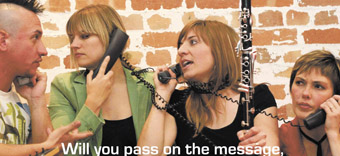
Harm Te Kuru, Nerida Matthaei, Nicole Canham, Skye Sewell, Phluxus dance collective program image, Chinese Whispers/Broken Telephone
PHLUXUS DANCE COLLECTIVE IS AN ENGAGING NEW BRISBANE COMPANY. THEIR FIRST WORK, THE MACHINE THAT CARRIES THE SOUL, WAS RECENTLY AWARDED THE CRITICS CHOICE AWARD IN THE 2007 SHORT AND SWEET AND DANCE FESTIVAL IN SYDNEY, HAVING ALREADY BEEN AWARDED RUNNER-UP FOR BEST DANCE/MOVEMENT PERFORMANCE AT LAST YEAR’S MELBOURNE FRINGE FESTIVAL.
The designation ‘collective’ is a nostalgic one nowadays, and Phluxus seemingly connotes both the name and spirit of the Fluxus art movement of the 1960s. There is a ‘family’ connection across time and across art boundaries, and in the relaxed and playful familiarity of the performers with each other and with their audience. I enjoy the fact that clarinetist Nicole Canham’s creative partnership with founder and performing artist Nerida Matthaei began many years ago singing Count Basie tunes together while decorating the Christmas tree.
We are at the Hot Gossip Lounge, cabaret style. Coloured globes float like planets in space above a minimal stage. There is a joke (at John Cage’s expense?) of a grand piano that is never played. Chinese Whispers/Broken Telephone is an exploration of the children’s party game which, at core, involves “cumulative error and communication breakdown…subtle shifts and changes moving between what you hear and what you see.” New York Counterpoint composed by Steve Reich has the soloist live accompanying a prerecorded tape of herself. Shifts and changes between the two modes of musical presentation create different inflections that extend into literal footnotes of commentary and baroque, Borges-like addenda by dancers Matthaei and Skye Sewell whose entwined hieroglyphic hand and arm movements sometimes evoke Chinese opera or Tai Chi.
The choreography adds different layers of concatenation and syntheses as the music becomes shriller and the moves smaller, tightening into exquisite focus on Canham’s fingers on the clarinet. Although music and dance are non-discursive, formally independent of semantic meaning, they are nevertheless constituted by their own phrases and syntax that, in this subtly abstract and contemplative piece, mix and merge, effecting a kinesiology of signals and signs that achieves a highly satisfying interface. Reich’s aural sculpture, Pendulum Music, with its haunting feedback effects, likewise interfaces with the kinetic installation created by Marisa Cuzzolaro’s video projections and pendulously swinging lights winding down to reinforce the perception of language and the body (by its absence) in fluid permutation but mutually subject, perhaps, to gravity.
Touching on a more accessible human dimension, the vaudevillian take on The Three Etudes on Themes of Gershwin by Paul Harvey, provides a change of pace, looking at role reversals between a ventriloquist and her doll. Matthaei and Sewell are superbly and entertainingly acrobatic in routines involving possession of a chair. Snatches of familiar melodies evoke nostalgia for sense in a world that is constantly being subverted by clowns. There is an interlude for participation, the audience dividing into three sections to be briskly (no time to think!) inducted into the reproduction of simple sounds and dance movements in a good-humoured, non-threatening manner that democratises as well as demystifies what is, after all, a highly sophisticated avant garde undertaking.
There follows a competitive, rapid-fire game-show version of Chinese Whispers with the audience as two teams. The last piece evolves through movement reminiscent of contact improvisation as a choreographed argument which finally subsides through the imposition of a yellow card, orange card and red card. Although well constructed and witty, this is perhaps the least successful as a discrete movement piece as it lacks full expression of the ritual nature of antagonism and its implicit rhythms. This aside, the composition Chinese Whispers by the group Alchemist was given an interesting electronic treatment by Harm Te Kuru “trying to capture the density of texture found in heavy metal music but using less familiar devices.” Canham’s clarinet comes through the filter of an effects processor.
Nicole Canham’s onstage presence was a bulwark of the evening, with Matthael and Sewell compellingly watchable, effortlessly stitching together in their movement work the remarkable (and contrary) strengths of teflon and toffee. Apart from sheer enjoyment, I liked the non-hierarchical nature of the performance (and the dues paid to the ‘silent partners’), a refreshing ingredient in itself.
Phluxus Dance Collective, Chinese Whispers/Broken Telephone, clarinet Nicole Canham, performers Nerida Matthaei, Skye Sewell, video & photography Marisa Cuzzolaro, electronica Harm Te Kuru, sound & lighting Chris Neehause, Ben Hughes, Matt Cody, Don Mackenzie, Corrin Matthews; Judith Wright Centre for Contemporary Arts, Nov 1
RealTime issue #82 Dec-Jan 2007 pg. 30
© Doug Leonard; for permission to reproduce apply to realtime@realtimearts.net
















































































